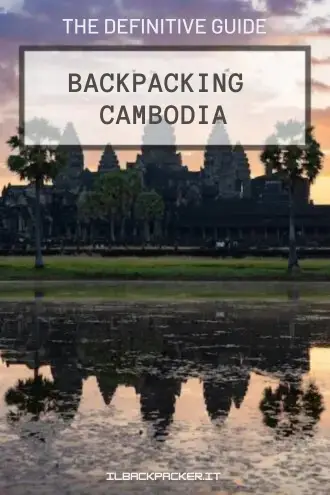Cambodia Travel Guide
Cambodia, officially the Kingdom of Cambodia, is often snubbed in favour of other Southeast Asian countries, but the country has more than a few exciting destinations.
Angkor Wat, the largest temple complex in the world and the most visited archaeological site in Southeast Asia, paradise islands in the south of the country, pristine forest, and a lot of recent history that unfortunately concerns one of the worst genocides ever. The government has a lot to offer.
I spent two months backpacking around the country. Whether you want to do the same or just do some research and then rely on an organized tour, you will find many valuable tips and information in this guide to help you better plan your trip.
Quick menu
- When to visit Cambodia
- Documents and vaccinations to enter Cambodia
- What to do and see in Cambodia
- Suggested itineraries in Cambodia
- How to get around Cambodia
- Backpacking Cambodia: costs
- Backpacking Cambodia: safety and security
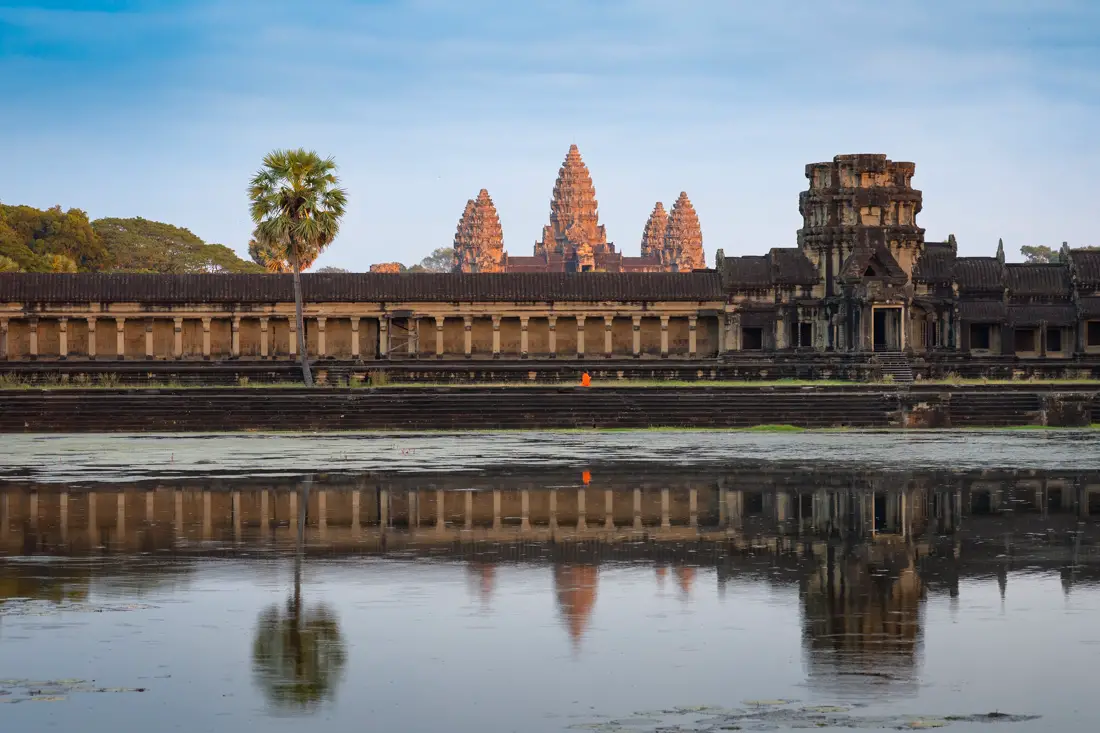
Angkor Wat at sunset.
When to visit Cambodia
Like virtually all other countries in the region, Cambodia has two distinct seasons: dry and rainy. Generally, the best time to visit Cambodia corresponds with the dry season, roughly from November to April. November, December, and January are considered the absolute best, given the absence of rainfall and the low temperatures, which are undoubtedly the most pleasant of the year. This period corresponds with the high season, reflecting prices, especially for accommodation and some activities.
Starting in March, temperatures and humidity rise considerably until peaking around May, just before the rains. While not the most pleasant, these months remain an excellent time to visit the country.
However, the rainy season from May to October has some advantages:
- The landscape turns green.
- The rice fields finally take on colour.
- The waterfalls are in full swing.
The almost daily rains tend to be concentrated within a few hours, especially during the first few months of the wet season, while they are much more frequent as the season progresses, peaking in August.
During the peak of the rains, some roads may be impassable, making overland travel difficult; many activities, such as hiking and tubing, are practically out of the question. September and October can be good months; there is a decrease in rainfall and a drop in temperatures until the transition to the dry season in November.
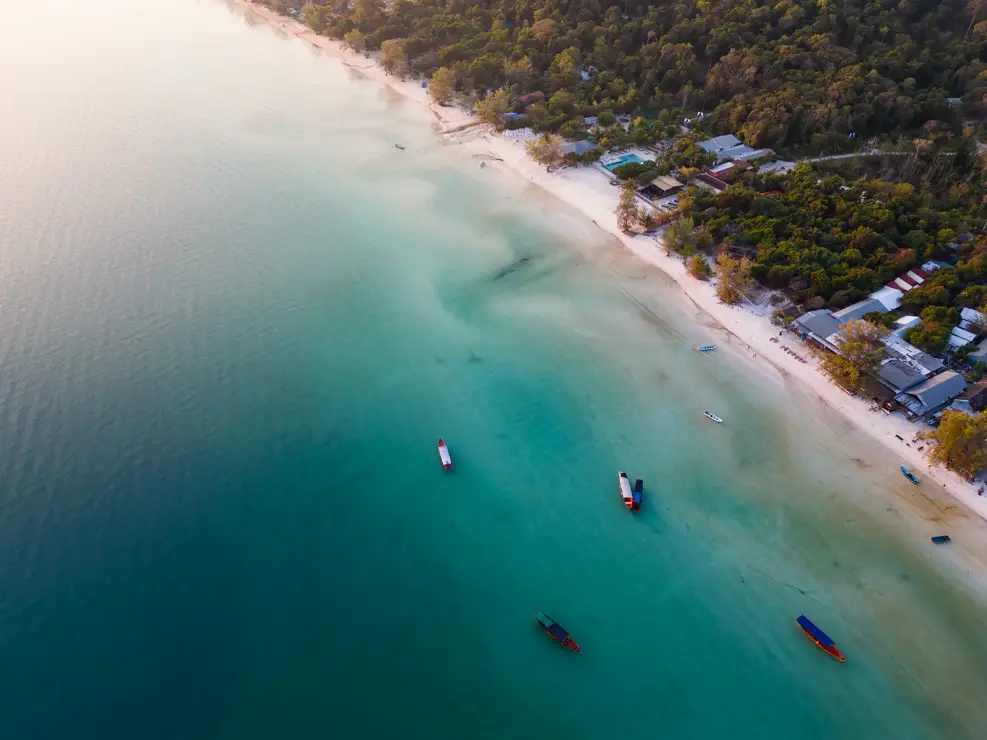
Sunrise at Saracen Bay, Koh Rong Samloem.
Documents and vaccinations to enter Cambodia
Most nationalities receive an on-arrival tourist visa valid for 30 days from the time they enter the country. The visa is Type “T” and typically costs US$30, but some border crossings charge US$35. Some borders also charge $1 over the weekend to process the application; whether this is legitimate or not remains a mystery.
I crossed the border at Ban Laem (where I paid $35), and when I arrived in Thailand, they did not ask for any passport photos, but from what we read, they sometimes ask for them. However, they also accepted the Thai Baht at a very unfavourable exchange rate if I wanted. I had US dollars with me, so I simply used them.
For the past few years, obtaining an online visa (E-visa) has also been possible, but the latter is not accepted at all land border crossings. When writing this guide, even the official website is unclear about this and merely mentions that it is not accepted everywhere: “Not all border checkpoints support e-Visa. Please check before you apply. You can apply for an on-arrival visa at those checkpoints that do not support e-Visa.” What is certain is that it is accepted at Phnom Penh airport. I encourage you to check, but according to unofficial sources. The visa is also accepted at Preah Sihanouk International Airport, Cham Yeam (Koh Kong) – Thailand border, Poi Pet (Banteay Meanchey) – Thailand border, Bavet (Svay Rieng) – Vietnam border and Tropaeng Kreal Border Post (Stung Treng) – Laos border. The cost is $36, slightly more expensive than the classic visa on arrival.

Sunrise at Angkor Wat.
The tourist visa (Type “T”) I have mentioned so far can easily be renewed for another 30 days. The procedure is straightforward, but unfortunately, it takes a week. The only immigration office where you can proceed with the renewal is Phnom Phen, opposite the airport (Google Maps, Maps. me). I recommend taking bus line 3 to get there, which lets you quickly identify the nearest stop with the official app (iOS, Android). The buses run frequently, are clean, have air conditioning, and, from my experience, are never crowded. All this for 1,500 reals. Just remember to bring exact money with you because no change is given.
At the immigration office, you are given a form that must be filled out and turned in along with your passport, a passport photo and payment of $30. You receive a temporary document and an appointment to pick up your passport a week later.
Cambodia requires no mandatory vaccinations, but Hepatitis A and B are recommended. Some doctors may also recommend malaria prevention, mainly if you visit the country during the rainy season or venture outside the big cities. Discuss this with your doctor.
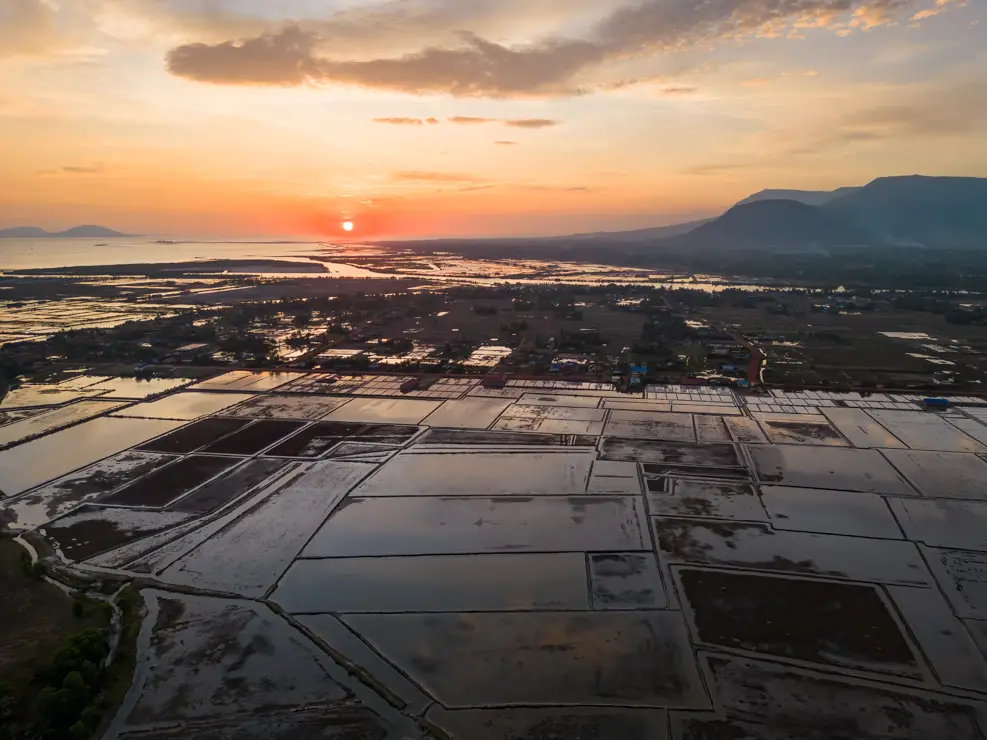
Kampot salt flats.
What to do and see in Cambodia
Throughout this guide, you will often find prices expressed in U.S. dollars but not only. Cambodia has two official currencies: the U.S. dollar and the Cambodian Riel. You might, for example, pay a $3 bill with a $10 bill and receive a $5 bill plus the equivalent of $2 in real and so on. This system can be a bit confusing in the beginning.
In general, the Riel is used primarily for sub-dollar figures but also in rural areas, and small businesses seem to prefer it or at least express prices directly in Riel, while larger companies and the tourism sector seem to like the dollar or otherwise express the cost of their services in dollars.
Fortunately, the unofficial exchange rate many uses is 1$ = 4000 real, which makes the math much more accessible. That said, at least during my stay, the official exchange rate offered by the various currency exchanges was around $1 = 4100 real. This means it was often possible to abuse the unofficial exchange rate by changing one’s dollars to 4100 actual and then paying using the 1$ = 4000 real exchange rate, saving about 2.5 per cent per transition. This trick, however, did not always work because the larger businesses, especially, although they gladly accepted reals despite prices being expressed in dollars, were rightly using the official exchange rate.
Finally, the destinations described are listed starting from the capital, Phnom Penh, continuing north and then moving west before descending south. If you fly into Phnom Penh, this is probably the best way to optimize travel. Still, it depends a lot on where you arrive, in what direction you intend to continue your trip, and what destinations you plan to visit within the country. I, for example, started my trip to Battambang after arriving from Thailand.
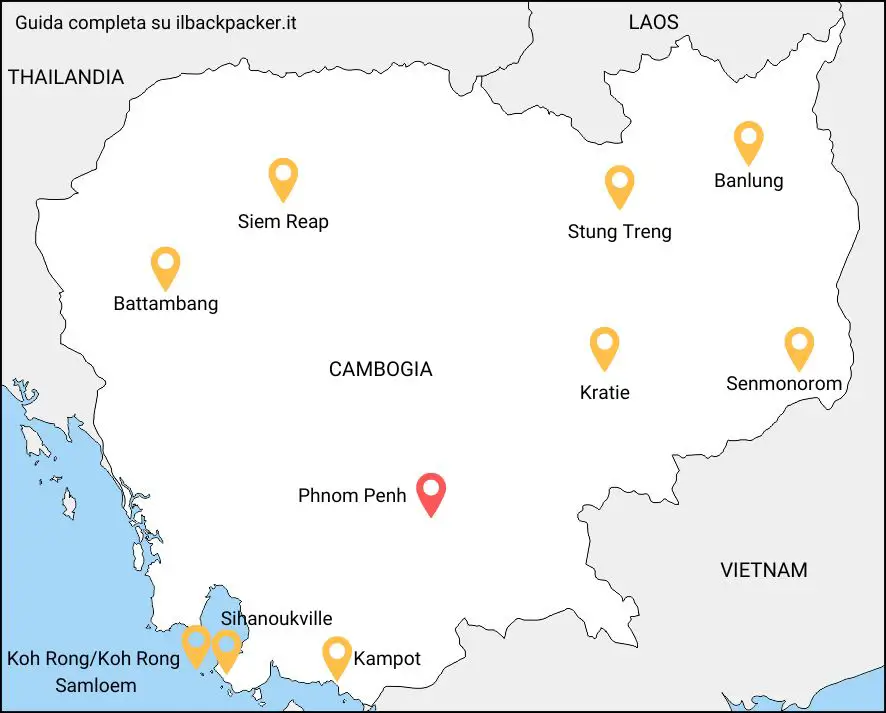
N.b. Several times throughout the guide, you will find links to https://www.alltrails.com/. Upgrade to the pro version if you want offline navigation directly from the Alltrails app. However, you can get around this by downloading the coordinates from the site’s desktop version in “Google Earth KML” format and then uploading them to organic maps, which is by far one of my favourite travel apps.
Phnom Penh
Phnom Penh, the capital of Cambodia, compared to other Southeast Asian capitals, is not exactly an exciting destination or a beautiful city, so much so that many travellers decide to skip it altogether. Unless your days are numbered, I think it is still worth spending at least a day there to visit some of the landmarks of the terrible genocide that occurred under the Khmer Rouge regime in the 1970s.
What to do and see in Phnom Penh
As anticipated, I think one day is enough to visit the main sites of interest, namely Tuol Sleng and Choeung Ek. Many hostels arrange shared tuk-tuk so that people can see both sites. I walked to Tuol Sleng with another guy and then shared a tuk-tuk to return to Choeung Ek.
Tuol Sleng (S-21)
Tuol Sleng, also called S-21 (Google Maps, Maps. me), was the top secret centre of a network of about 200 prisons where the Khmer Rouge tortured people. Between 12,000 and 20,000 people were imprisoned here. There are only 12 confirmed survivors. Admission costs $5, but if you want the audio guide, you must pay $10. It is also available in Italian, and I strongly recommend taking it. If you listen to all the steps in the audio guide, the visit will take about two hours. A documentary is also shown Monday through Friday, from 10:00 to 10:15 a.m., which I have not personally seen, but combining it with your visit might be interesting.
This is a visit that some may find difficult, almost traumatic. It starts with the rooms where the last prisoners were killed, literally quartered alive to avoid making noise by shooting them since the liberation army was now really close, and the fleeing staff wanted to avoid attracting their attention. The boy with whom I visited the museum missed more than a few stops on the audio guide and told me that he did not sleep well at night, so if you are compassionate, adjust accordingly. , I strongly recommend the visit (with the audio guide) to everyone else.
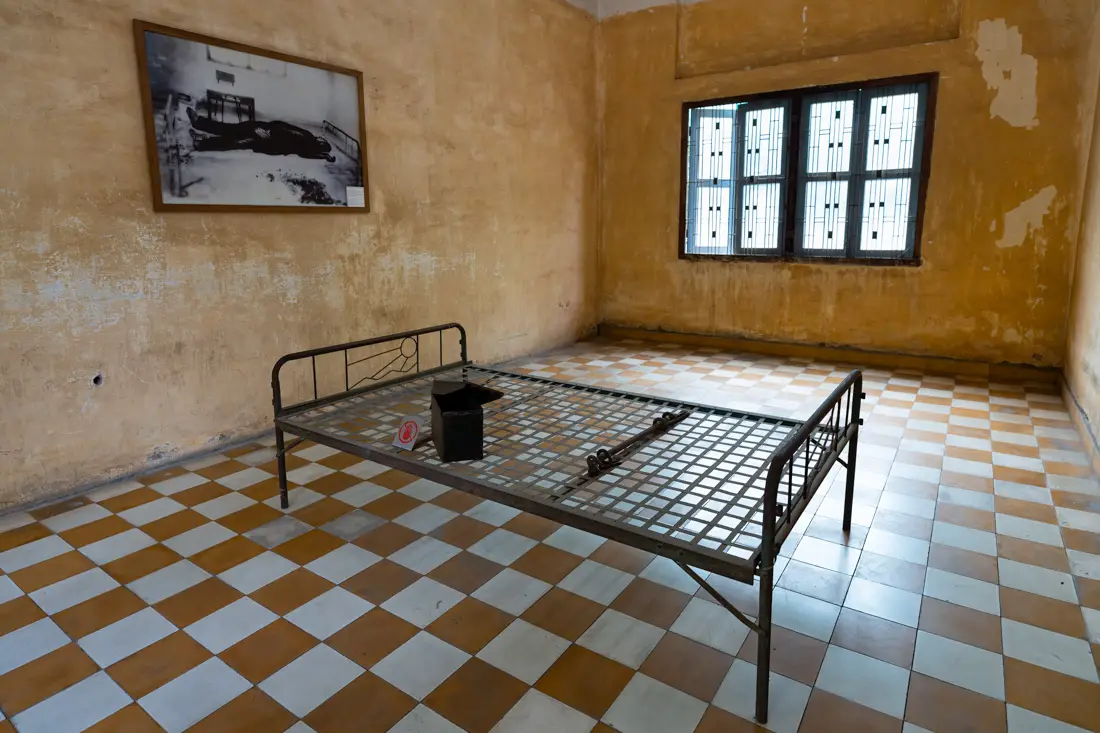
One of the rooms inside S-21.
Choeung Ek (Killing Fields)
Choeung Ek (Google Maps, Maps. me) is the best known of the 300 Death Camps or extermination camps in Cambodia, located about 15 km southeast of Phnom Penh and is where Tuol Sleng prisoners were led, executed and buried in mass graves. Today, it is a museum and a place of remembrance. Admission with an audio guide costs $6. If you listen to all the stages and visit the small museum, the visit takes about two hours. The documentary lasts about ten minutes or so and is shown repeatedly at the side of the museum; while interesting, it does not tell anything that is not already in the audio guide.
Again, this is a “heavy” visit; it is still possible to see bones and clothing surfacing from the ground, especially during the rainy season, and the guided tour ends with a Buddhist stupa filled with human skulls recovered from mass graves. Again, if you are a compassionate person, consider whether or not to visit the site. For everyone else, I strongly recommend the visit. As mentioned above, I recommend taking a tuk at the end of the visit to Tuol Sleng.

Choeung Ek Pagoda.
Royal Palace
The royal palace (Google Maps, Maps. me) is often recommended during a visit to Phnom Penh. Still, I decided not to visit it because it was under restoration and, therefore, only partially visitable. Built-in 1886, it is considered a fantastic example of Khmer architecture and the current official residence of King Sihamoni. Within the perimeter, besides the royal palace proper, there are other sites of interest, such as the Silver Pagoda and the Temple of the Emerald Buddha. Admission costs $10. Whether you decide to visit the complex or not, I recommend taking a tour of the entrance during the evening when it is illuminated. It is fascinating and a great way to escape from the hustle and bustle of the city because the area is closed to traffic. The national museum (Google Maps, Maps. me), beside the royal palace, is also often recommended, but according to my research, it is more of a collection of statues. I decided not to visit it, but some might find it interesting. Admission costs $10.
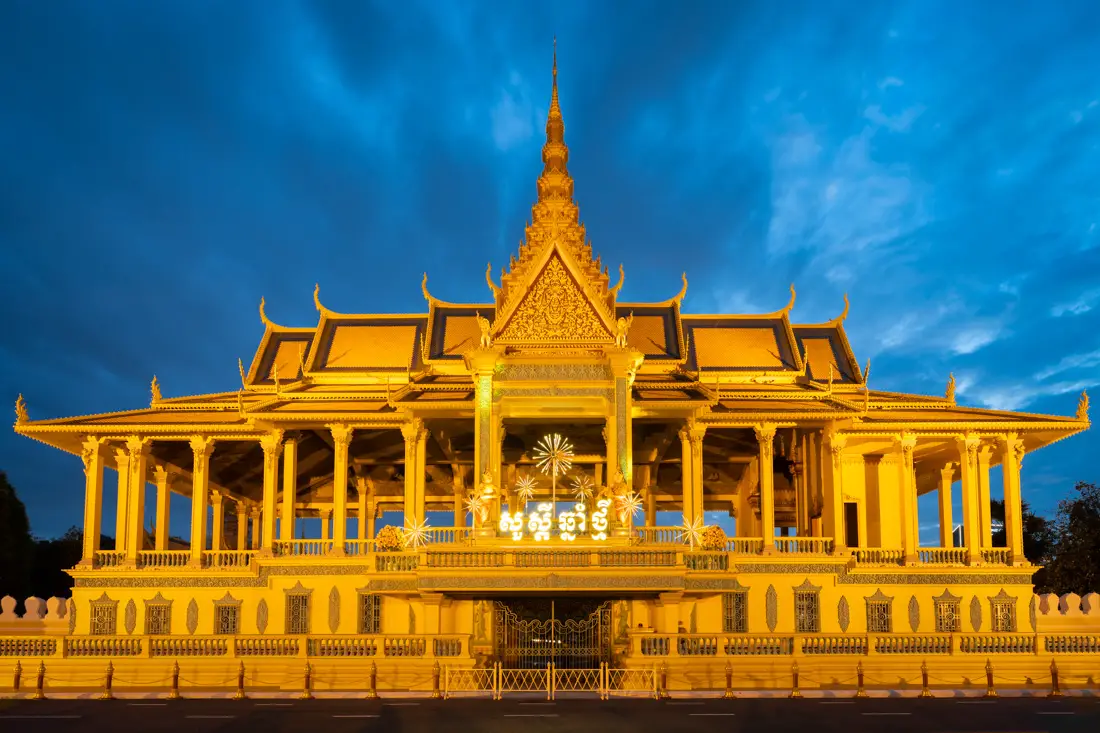
Royal Palace entrance.
Wat Phnom
Wat Phnom (Google Maps, Maps. me) is a pagoda that sits atop a small hill within a park in the middle of the city. Admission for foreigners is $1. It’s not a lot of money, but if you’ve already spent some time in Asia, I doubt you’ll find the visit particularly fascinating. For me, the best aspect was the peace from the hustle and bustle of the city; there are, in fact, numerous benches where you can sit and read a good book or just spend some time relaxing. – The best photo view is from the south side; you don’t need to go inside. I’m not suggesting you do, but here, you could simply climb over and avoid paying admission. I did it out of laziness when it was time to leave.
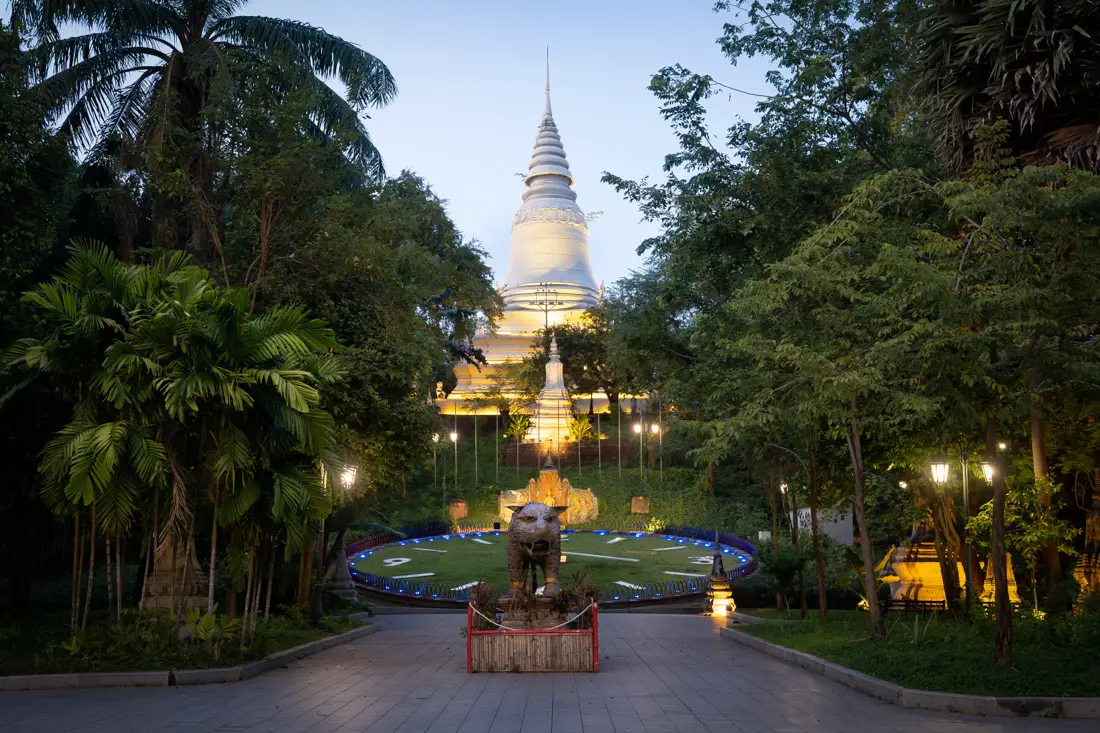
Wat Phnom.
Ta Prohm and Tonle Bati
Ta Prohm (Google Maps, Maps. me) and Tonle Bati (Google Maps. me) are some of the best-preserved temples outside the Angkor Wat complex. They are located about 30km south of Phnom Penh. Admission is only one euro, but after a week of exploring temples, I could not justify the hour-long drive and overall visit. However, for some, it might be something of interest.
Silk Island
Silk Island or Koh Dach (Google Maps, Maps. me) is another often-recommended excursion. However, according to my research, what was once a peaceful island where you could observe rural life has become a classic tourist trap that is not worth visiting. If you decide to see it instead of joining an organized tour, you can simply reach the ferry dock (Google Maps, Maps. me) by tuk-tuk and then rent a bike to get around the island.
To conclude, more than a few travellers recommended I try David’s restaurant‘s famous homemade noodles, so I decided to do so. I didn’t find them exceptional, and they charge for their notoriety. More than the food itself, I think it’s nice to see the preparation process, but you just have to stop in front of the restaurant for a few minutes…
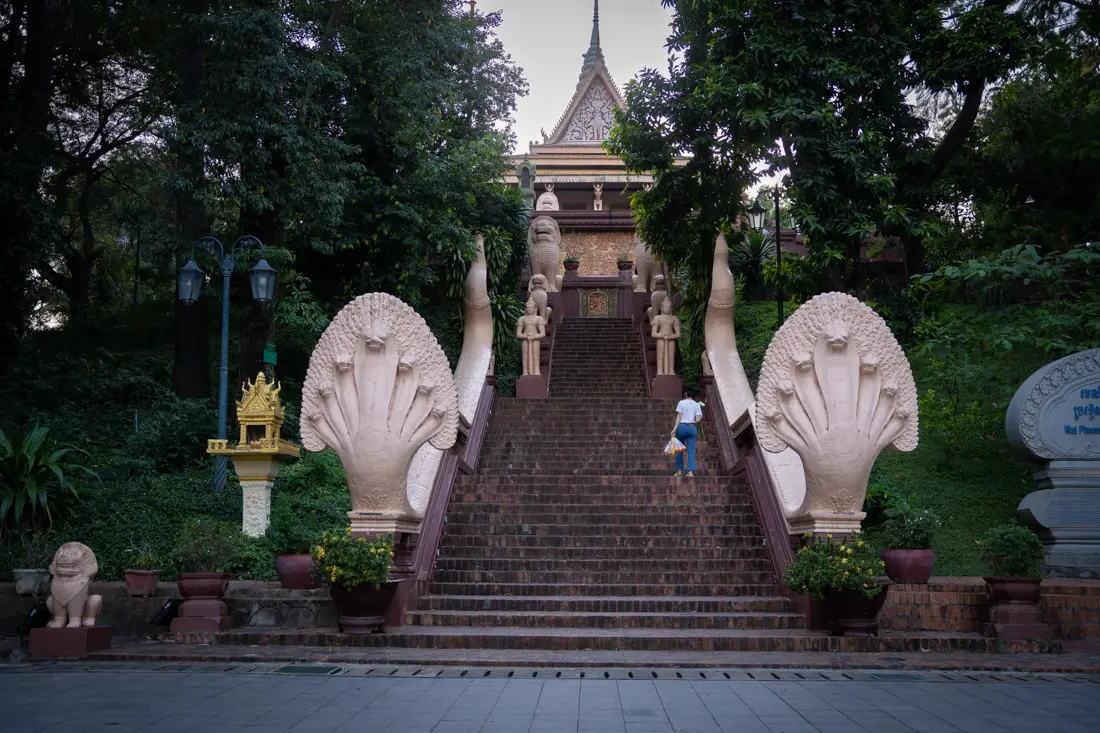
Wat Phnom.
How to reach Phnom Penh?
Given its central location, Phnom Penh has direct connections from virtually every tourist destination in the country at least once a day. Finding a direct bus or van to Phnom Penh is never a problem. That said, each company has its private terminal, which in some cases is located slightly outside the centre, which means taking a tuk-tuk to get to your accommodation. If you decide to stay around the riverfront, as many do, Virak Buntham, Larryta Express, and Giant Ibis have their terminals nearby.
If you are arriving from the airport, instead of taking a cab or a tuk tuk-obviously if you want to save money, I strongly recommend bus line 3, which I talk about in detail in the “Documents and Vaccinations to Enter Cambodia” section since it is the same bus to take if you want to renew your visa at the immigration office that is literally across the street from the airport. Walking out of the airport, the stop is a hundred meters to the left (Google Maps, Maps. me). 1500 riel, no change is given.
Where to sleep in Phnom Penh?
I spent one night at Pooltop Phnom Penh, which is not bad, but I strongly recommend Onederz Hostel Phnom Penh; it is slightly more expensive but a perfect hostel. Be careful, though, because from what I understand, the dorms for 12 are across the street in another building that is not as nice. Booking on the official website is often cheaper.
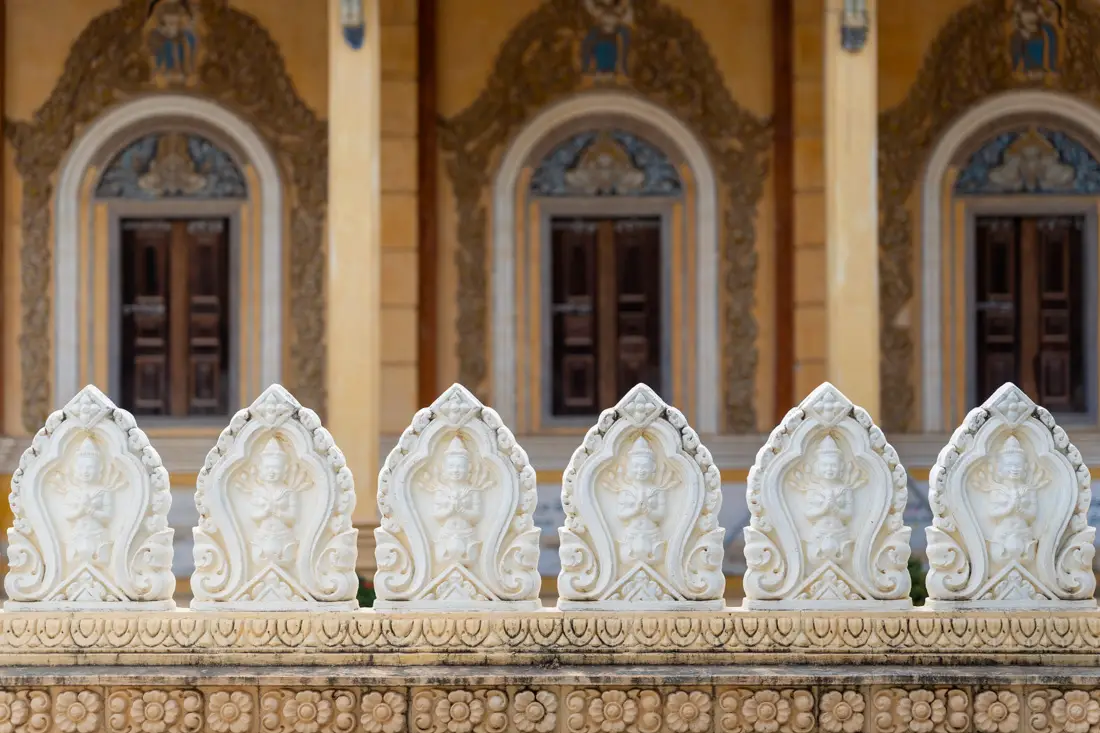
Wat Kandal, Battambang.
Battambang
Battambang is the third largest city in the country, often ignored in favour of more popular destinations; I think it can be an exciting destination to spend a couple of days in, especially for those continuing or arriving from Thailand.
What to do and see in Battambang
The city is quieter and cheaper than Phnom Penh and Siem Reap. I think it is an attraction, but there are also some interesting sights to see.
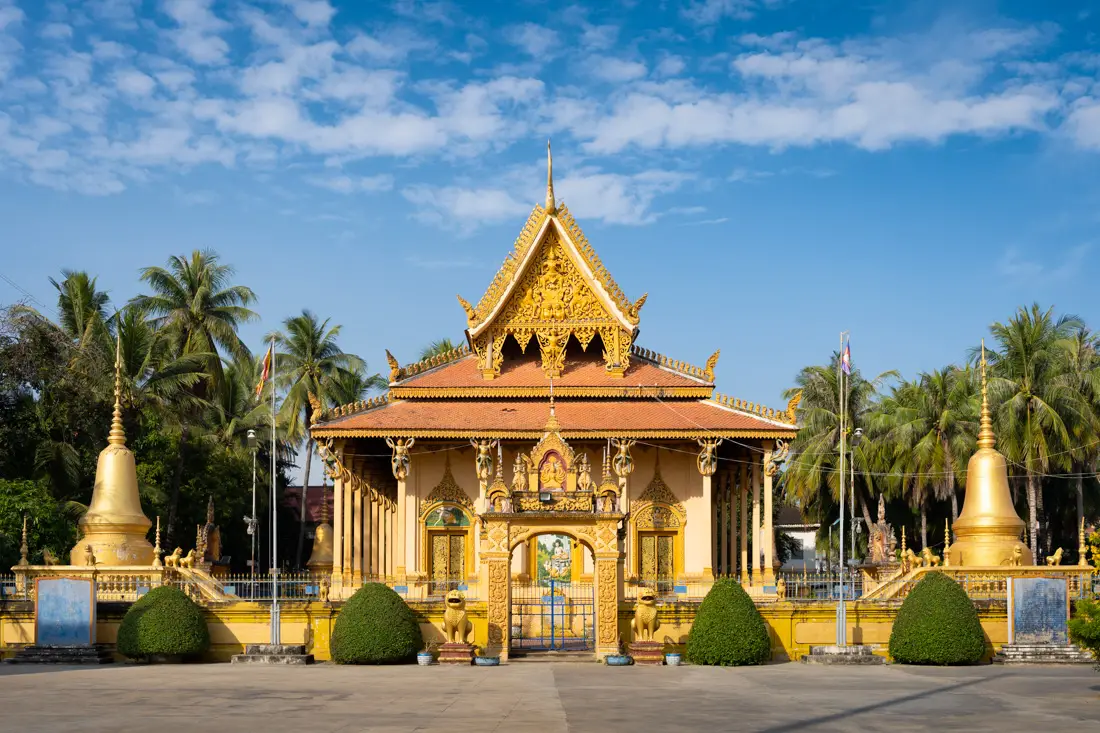
Wat Piphetthearam.
Temples and city tours
If you’ve been to Southeast Asia recently and haven’t had enough time to see temples, you can take a walking tour of the city’s main ones. Again, nothing is unmissable, but it is an excellent way to spend a few hours. In order: WaT Piphetthearam (Google Maps, Maps. me), Wat Po Cnong (Google Maps, Maps. me), Wat Kandal (Google Maps, Maps. me) and Wat Damrey Sor (Google Maps, Maps. me).
Other points of interest you could add to this city walking tour are the Battambang Museum (Google Maps, Maps. me) and the Governor’s Palace (Google Maps, Maps. me). They ask for a dollar as a “donation” for admission to the museum. There are a lot of sandstone sculptures. It is a short visit for non-fans, or at least it was for me. On the other hand, the governor’s palace is a well-preserved example of French colonial architecture; you cannot enter the building but walk through the gardens surrounding it. Admission is free.
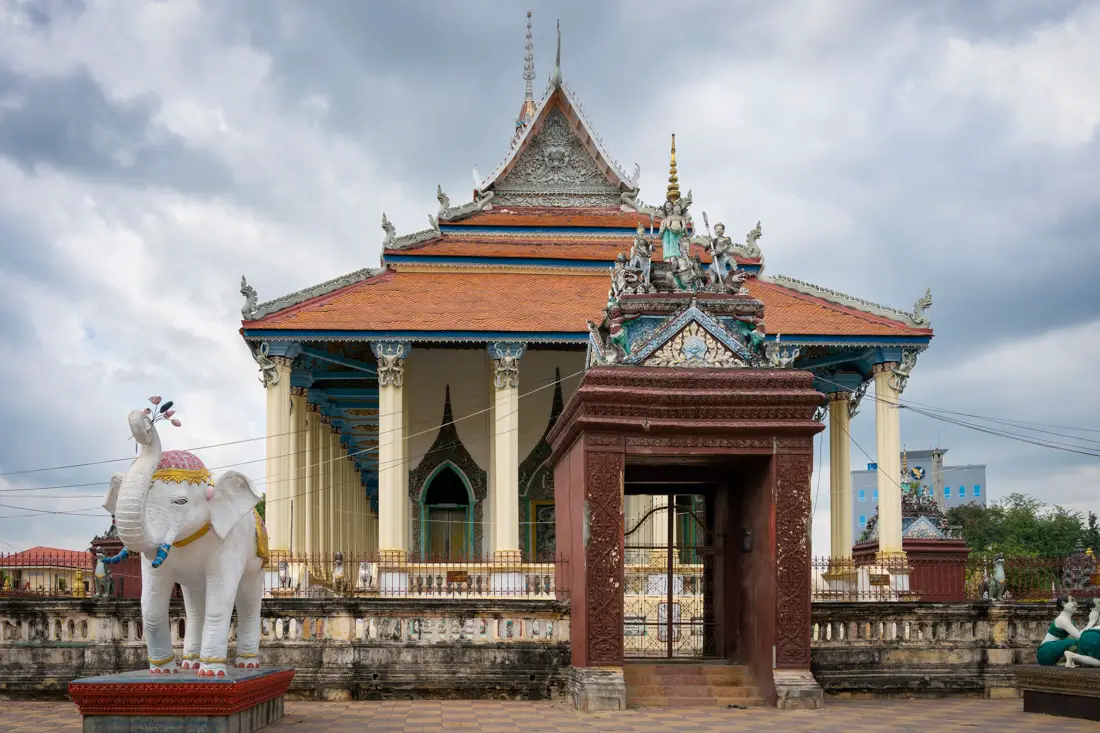
Wat Damrey Sor.
Wat Ek Phnom
Wat Ek Phnom (Google Maps, Maps. me) is located about ten kilometres outside the city and is the site of an 11th-century temple now in ruins but still an exciting place for its simplicity. Admission costs $1. A beautiful brand-new pagoda with a giant Buddha statue has been built before the ancient temple.
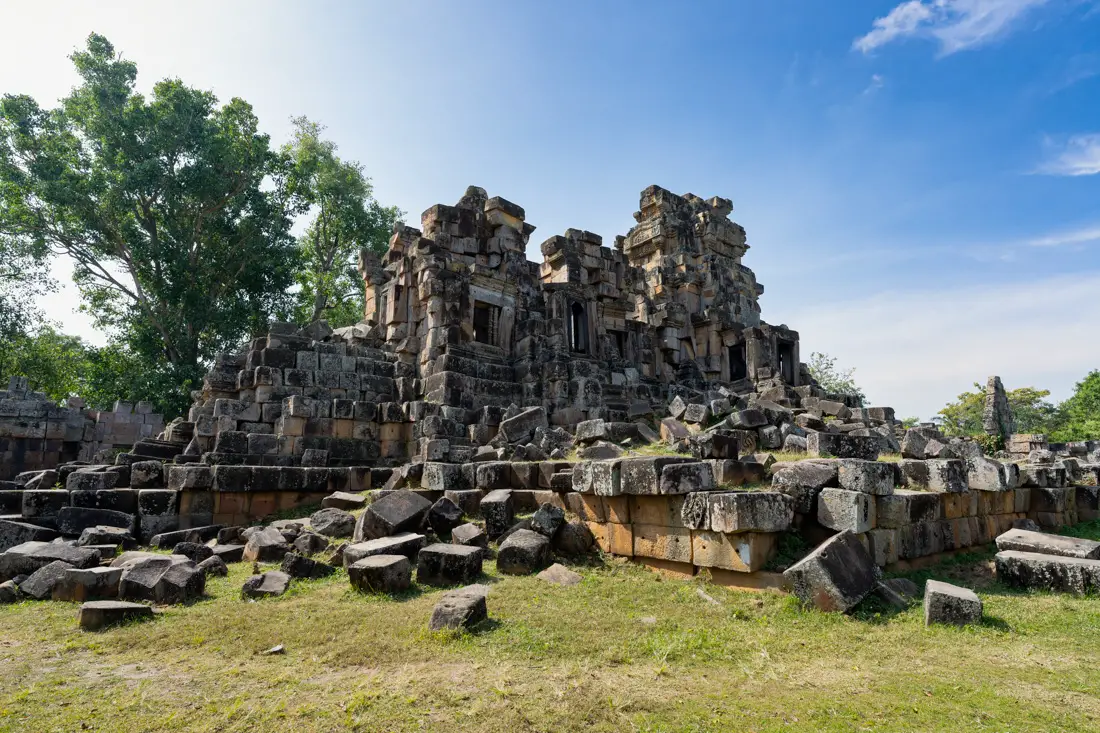
Wat Ek Phnom.
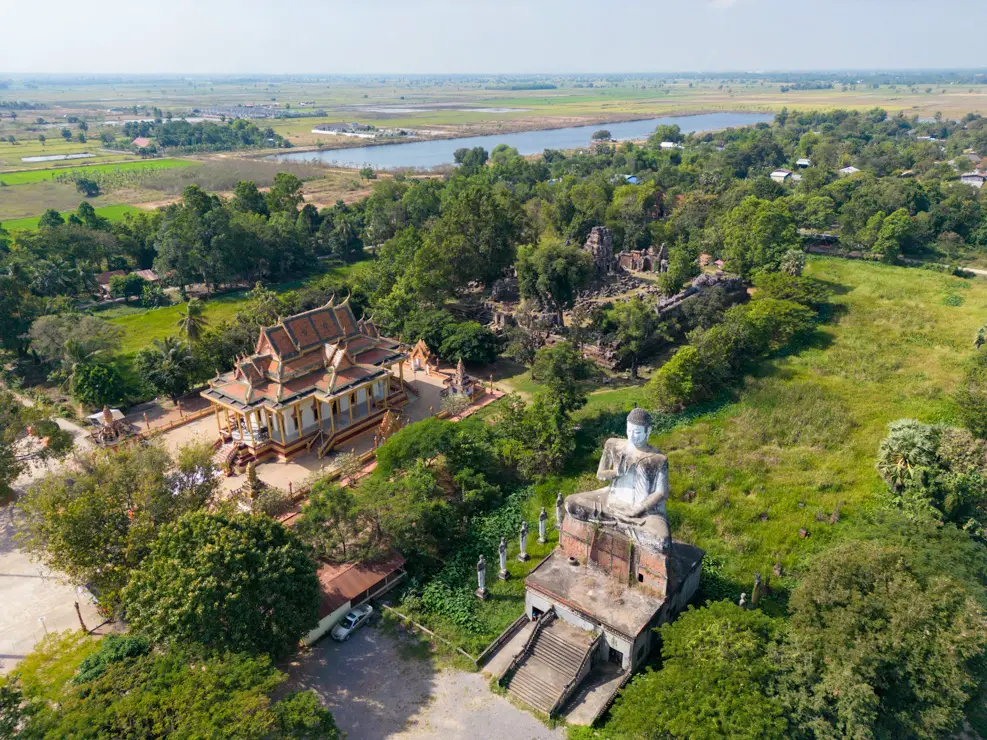
Wat Ek Phnom.
Wat Samrong Knong
Wat Samrong Knong (Google Maps, Maps. me) is a modern temple located about 5 km outside the city whose visit can easily be combined with Wat Ek Phnom. It is a significant site because, during the Khmer Rouge era, the original temple and its surroundings were used as a prison and killing field; over ten thousand people lost their lives here. There is a small museum that is not particularly interesting and a monument where you can read some information about how the prisoners were killed. A donation of 2,000 reals is requested to access the area where the memorial is located.
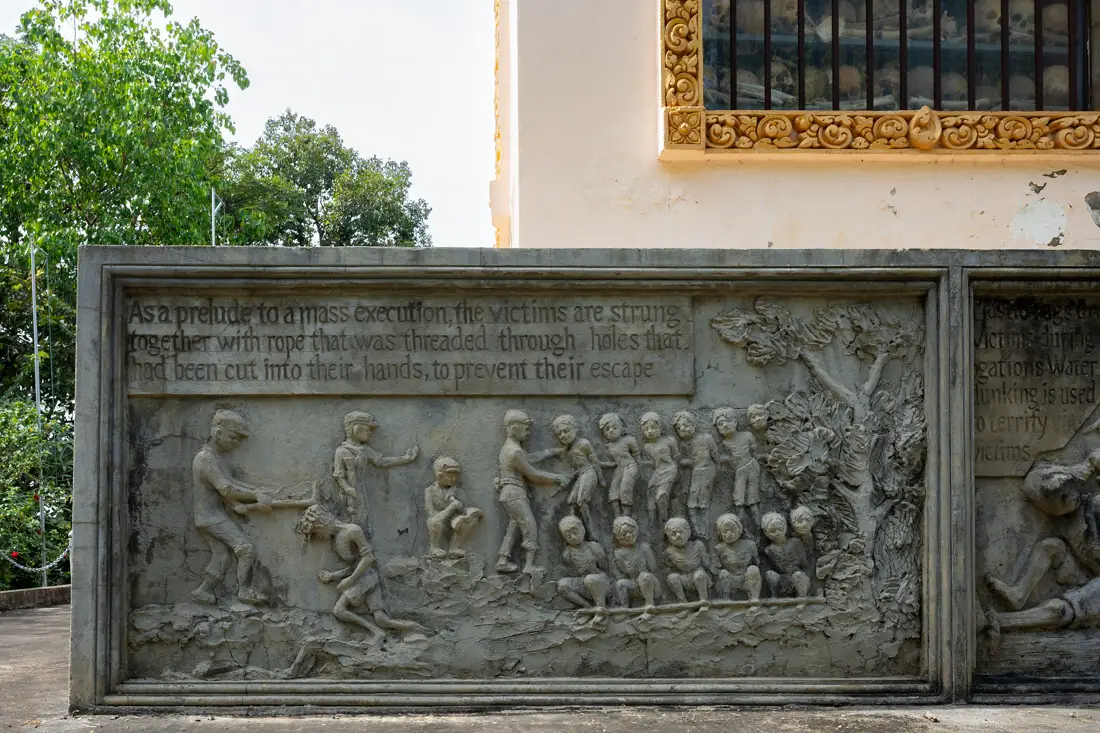
Wat Samrong Knong.
Baset Temple and Pagoda
Baset Temple (Google Maps, Maps. me) and the adjacent pagoda are slightly more inconvenient to reach. I have been there but don’t think it is worth it. The temple ruins are unimpressive, and the pagoda is also nothing much, but you can include it in your itinerary if you have the time and inclination. I was not asked for anything, but I read about someone being asked to pay a $1 entrance fee. Don’t do it. Admission is free.
Phnom Banan Temple
Dating back to the 11th century, Phnom Banan Temple (Google Maps, Maps. me) is considered the best preserved Khmer temple around Battambang. Located on top of a hill, it is reached at the end of more than 350 steps. Friendly and, at least during my visit, absolutely not crowded. The entrance fee is $2. I have not been there, but if you want, there are caves to visit at the mountain’s base.
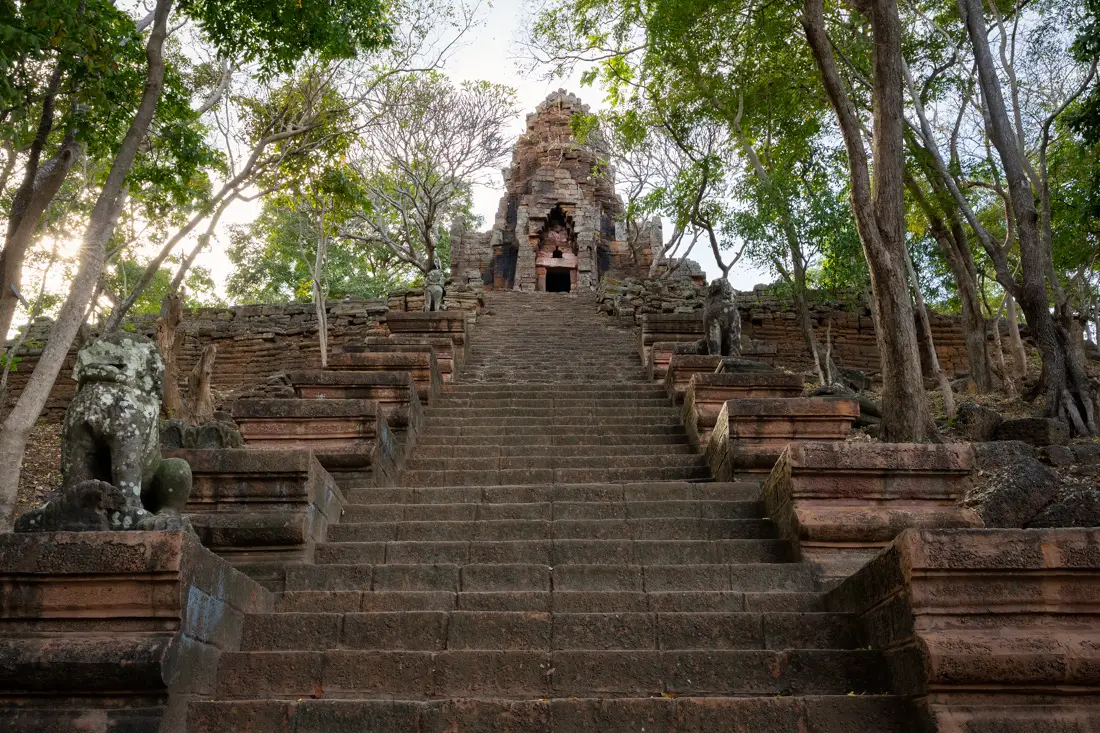
Phnom Banan Temple.
Killing Cave, Phnom Sampov and Bat Cave
About ten kilometres south of Battambang is a mountain on top of which is the Phnom Sampov Temple (Google Maps, Maps. me), where you have excellent views of the surrounding countryside and Battambang. You can also visit the Killing Cave (Google Maps, Maps. me), where thousands of victims were dumped during the Khmer Rouge era and whose remains can still be seen inside the memorial. Finally, be sure to go down to the base of the mountain before sunset to see the millions of bats that come out of Bat Cave every night (Google Maps, Maps. me), which is an awe-inspiring sight.
The police had a checkpoint at the beginning of the climb leading to the Killing Cave/temple and charged me $2 for entry without giving me any kind of ticket. I paid without thinking much about it, but shortly afterwards, I got a question, and there was an excellent pin on Maps. that said “scam police officer.” Once I got off, I managed to get my money back, but clearly, I recommend not paying.
In conclusion, to visit all the sites just described, I recommend renting a scooter for the day and visiting Wat Ek Phnom, Wat Samroung Knong, Phnom Banan, Phnom Sampeau and Bat Cave in that order so you can see the bats coming out at sunset before heading back to Battambang. I paid $8 for the scooter directly to the guesthouse. The roads throughout Cambodia are not exactly in perfect condition. Alternatively, some hostels organize shared tuk-tuk tours but are usually limited to visiting Phnom Banan Temple, Phnom Sampeau (Killing Cave) and the Bat Cave. Finally, you could simply contract a private tour with some tuk-tuk on the street.
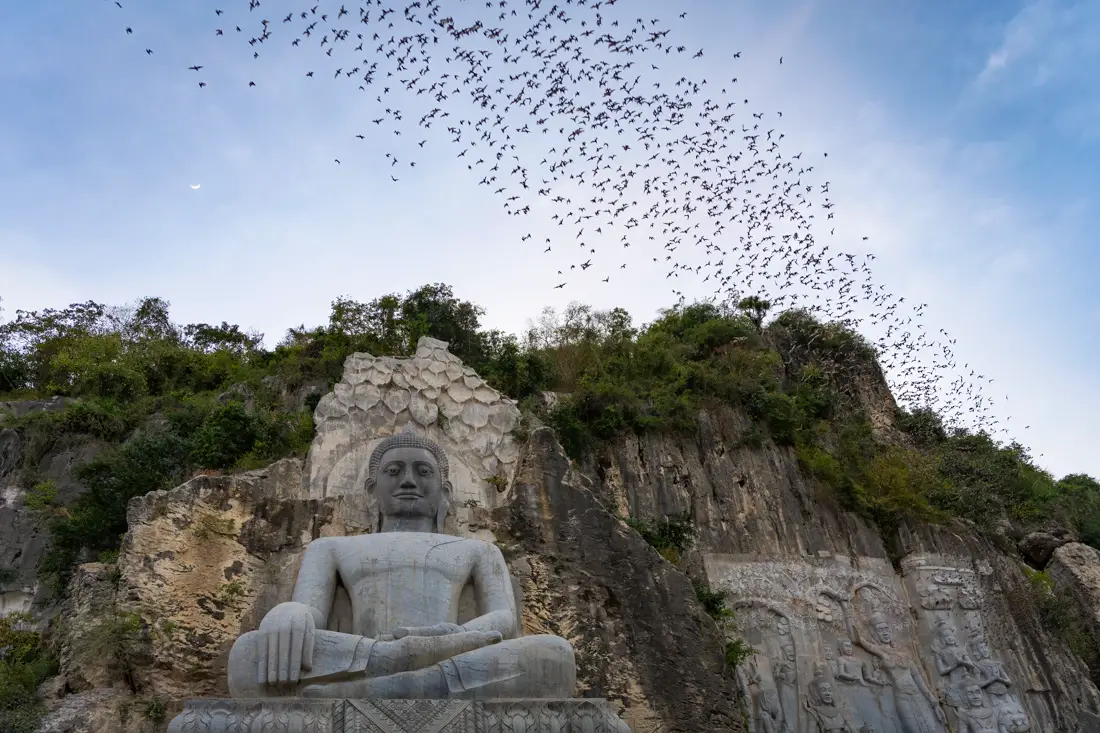
Batcave.
Battambang Circus
The Battambang Circus (Google Maps, Maps. me) or Phare Ponleu Selpak (official website) was a pleasant surprise. Students from the nonprofit art school in Battambang perform, and the performance is top-notch. Admission costs $14, which is not cheap, but the money goes directly to support a good cause. The performance lasts about an hour and is done every Monday, Wednesday, Thursday and Saturday at 7 pm (I recommend confirming dates and times on the official website), but you can enter the school grounds from 6 pm. There are a couple of rooms with exhibits to visit and a small café/restaurant. Recommended. I walked to it from downtown Battambang, but most people prefer to take a tuk-tuk.
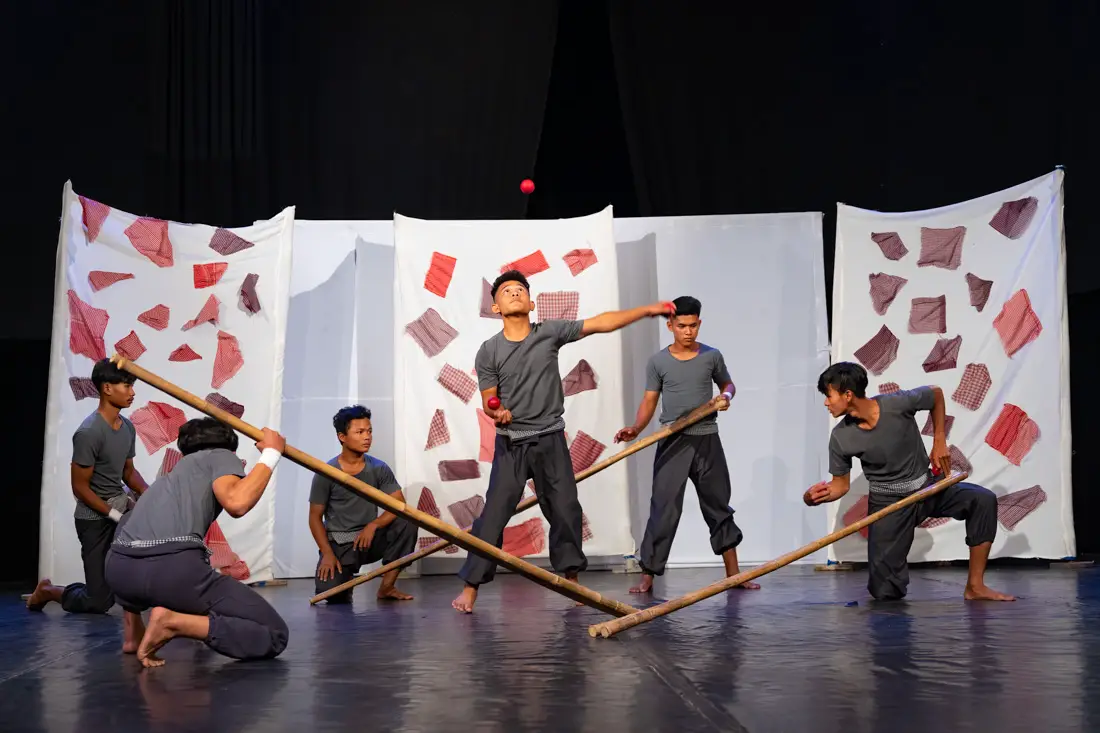
Battambang Circus.
Bamboo Train
The Bamboo Train (Google Maps, Maps. me) is considered one of the city’s most famous attractions; some guidebooks consider it a must-see. Initially, it was a form of transportation used by locals today. Still, I think it can be regarded as, for all intents and purposes, a tourist trap, so much so that I decided to skip the experience altogether. You can read this article or just take a look at some reviews on Google Maps and draw your conclusions, but basically, you pay $5 for a 40-minute or so round trip aboard some bamboo “carts” with a short break in a village where people hassle you to buy something.
Crocodile Farm
The crocodile farm (Google Maps, Maps. me) is undoubtedly another attraction that divides travellers. For some, it is excellent; for others, it is a disgrace. I have not been there, but this is the place to visit if you want to observe hundreds of crocodiles up close and hold a baby crocodile. Admission is $2.
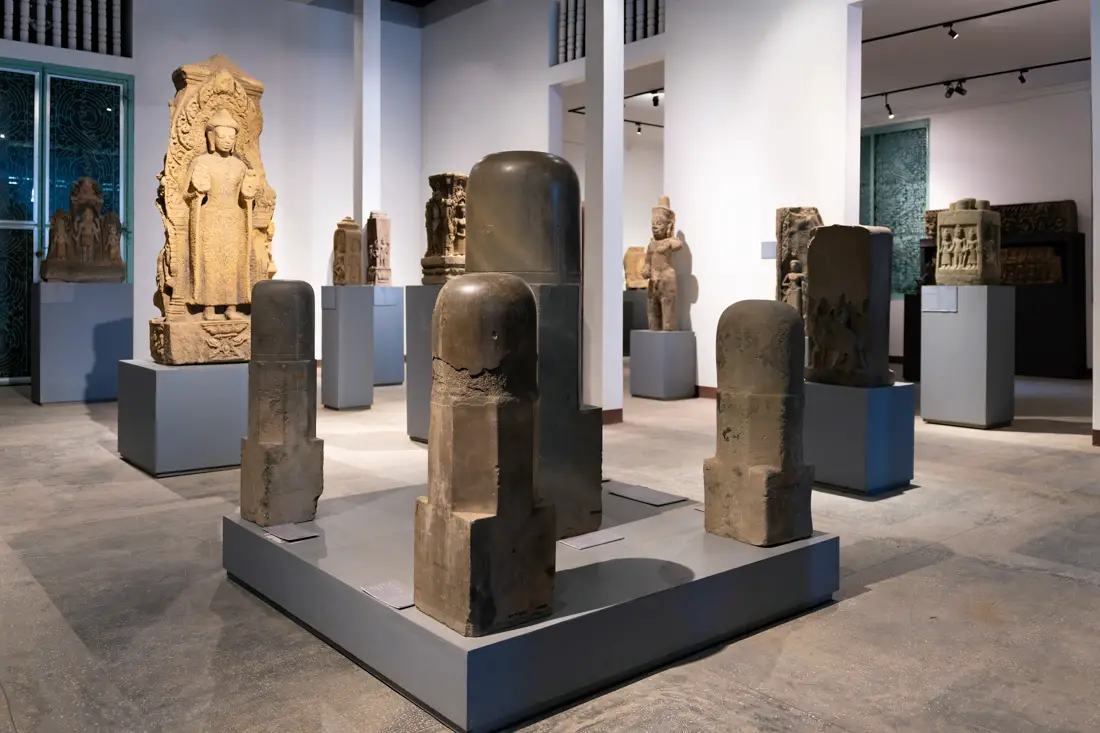
Battambang Museum.
Where to sleep in Battambang?
I got a private room at The Blue Guest House, paying about $5 a night; if you want something more social, some guys told me THE PLACE Hostel & Rooftop Bar is not bad.
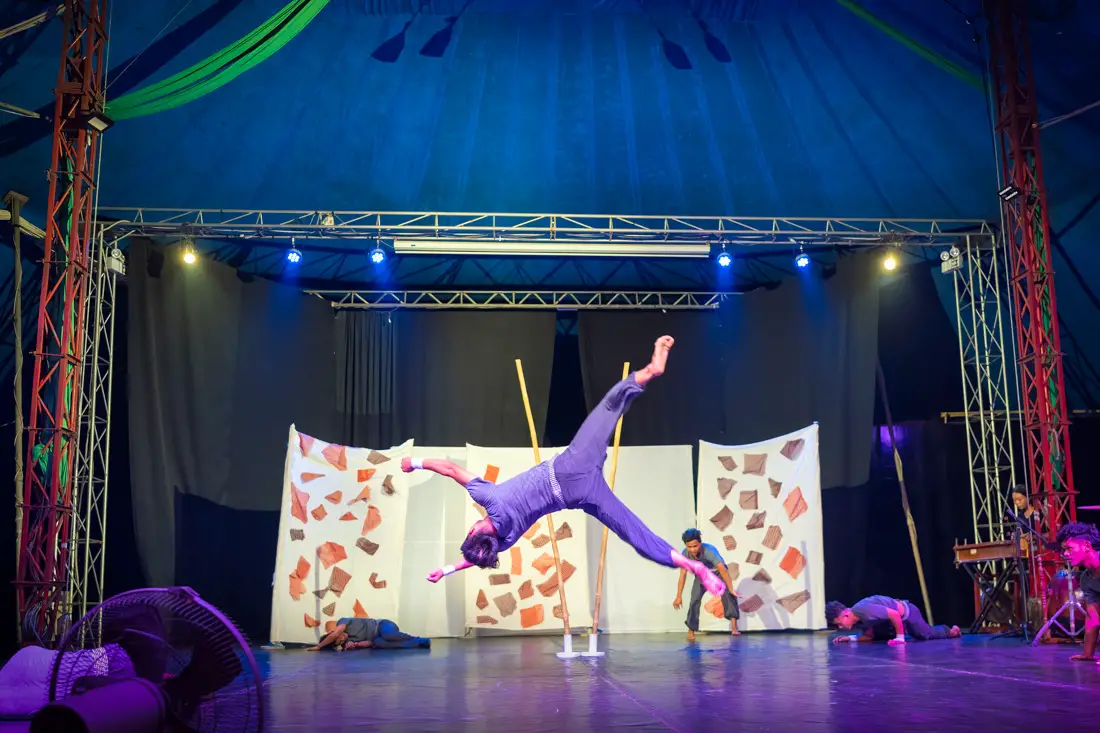
Battambang Circus.
How to reach Battambang?
From Chanthaburi in Thailand, there are four daily departures: 8:00 a.m., 11:00 a.m., 2:00 p.m., and 5:00 p.m. to Bae Lem border; from here, a shared cab to Battambang costs about $10 or 300 Baht. From Siem Reap and vice versa, there are frequent van connections to Vireak Buntham, and shared cabs cost about $10, about 3-4 hours. Similarly, there are frequent connections to Phnom Penh, about 6-7 hours long, including some night buses. Finally, there is an option to take the boat with Angkor Express that covers the Battambang – Siem Reap route and vice versa for $30 in about 6-7 hours. If you want, you can book directly on their website, and pick-up is included. I just took the van, but it is an experience that some travellers have recommended to me, especially if you are not planning to visit any floating villages in Siem Reap since by taking the boat, you would get to see some along the way since the first part of the trip is sailing on Tonle Sap Lake.
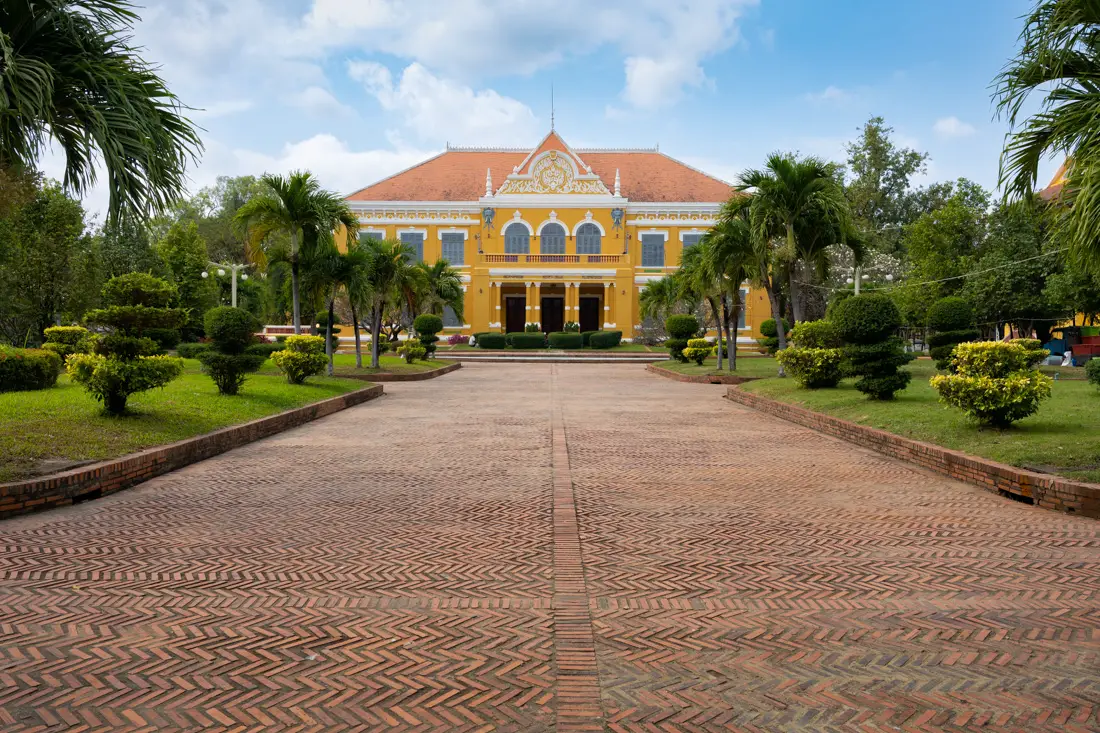
Governor’s Residence.
Siem Reap
Siem Reap is the crossroads for anyone visiting the Angkor Wat temple complex. The city is only a few kilometres from the entrance to the archaeological park, making it an ideal base for what is undoubtedly Cambodia’s number one attraction.
What to do and see in Siem Reap
As anticipated, for many, Siem Reap is synonymous with Angkor Wat, which is absolutely a must-see for anyone in Cambodia. Still, there are other sites around the city for those with time. For those interested, Siem Reap has a noteworthy nightlife, especially along the infamous Pub Street (Google Maps, Maps. me).
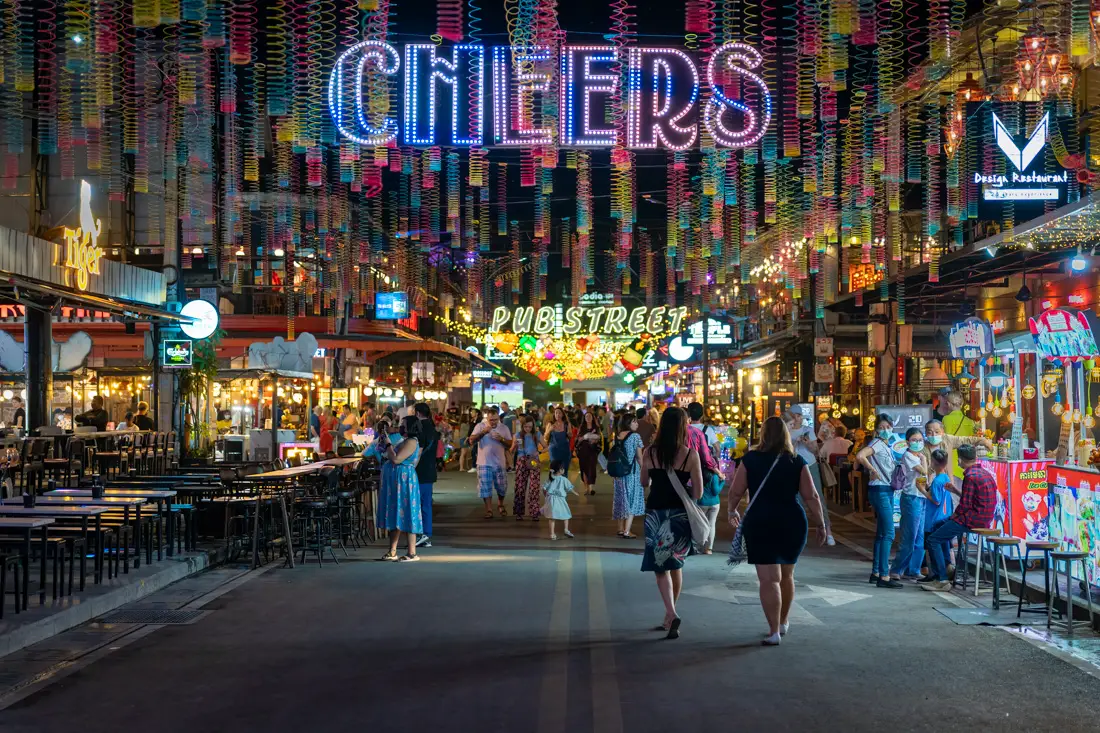
Pub Street.
Angkor Wat
After completing 3D aerial laser scans in 2016, it was realized that the archaeological site was the largest religious monument in the world and a massive city in the heart of the Khmer Kingdom. Three hundred thousand workers and 6,000 elephants were considered involved in its construction. Angkor Wat is indeed a vast site. The main temple that appears in most photos and from which the entire archaeological site takes its name is, in fact, only a tiny part of the site that covers an area of more than 400 square kilometres. Of this gigantic city to this day, almost exclusively, impressive temples remain- that is, the only buildings built of stone.
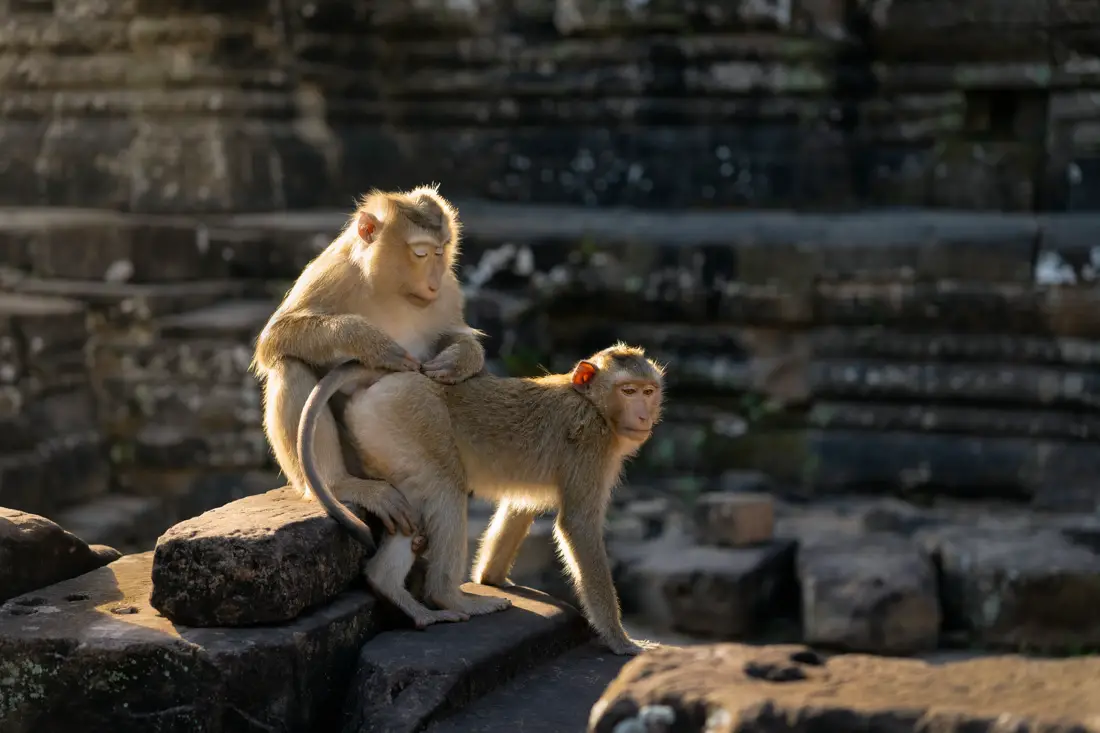
Monkeys at Bayon Temple.
Where to buy tickets for Angkor Wat?
Three passes are offered for park admission: one day for $37, three days for $62 and seven days for $72. I strongly recommend buying the ticket online at the official website; you do not pay any fees if you use a card without currency exchange fees. You then just download the ticket to your phone and show it digitally at the various checkpoints. If, for any reason, you want to buy a physical ticket or pay cash, the ticket office is located here.
I think the three-day pass is the right compromise. I spent five days inside the park and honestly wouldn’t have minded staying a few more days, but as mentioned above, I think three days is more than enough for most people. If you don’t have time or travel extremely economically, spending just one day inside the park is not the end of the world. I would also like to point out that the passes do not have to be used consecutively. The three-day pass is valid for ten days, while the one-week pass can be used over an entire month.

Sunrise at Angkor Wat.
How to visit Angkor Wat?
Once you have purchased your ticket, there are several options for visiting the archaeological park, the most popular being tuk-tuk, scooter and bicycle. I did two days by tuk-tuk, two by bicycle and one by scooter. Especially if you are travelling alone, I recommend joining the various tuk-tuk tours organized by the hostels. The two “standard” tours are the sunrise and sunset tours; the price varies depending on the participants. I did both with three other guys, paying only $5 for the sunrise and $6 for the sunset. By completing these two tours, you visit all the main temples. If you must choose between either, I recommend the sunrise tour. You have to wake up early, but it is worth it! If you only have one day and want to make the most of it, a private tuk-tuk from sunrise to sunset should cost you about $30.

Ta Prohm Temple.
If you’re willing to put in some effort, biking is a fantastic option; from Siem Reap to the entrance of Angkor Wat is about 25 to 30 minutes, but be aware that even at the turn of January and December, i.e. the “coldest” time, of the year around 10:00 to 11:00 a.m. it starts to get quite warm. I opted for the bike only after doing the two tuk-tuk tours, and basically, I would go out at dawn, spend a few hours inside the park, return to town in the late morning and only go out again in the late afternoon for sunset. Although the roads are in excellent condition and flat, and there is plenty of shade, deciding to spend the whole day on a bike can be taxing, especially if you don’t have a minimum of training.
The last option is to rent a scooter. I did it on the previous day to find a way to explore some of the temples that are far from the main complex, but no one forbids you from using them, even just for the classic tour.
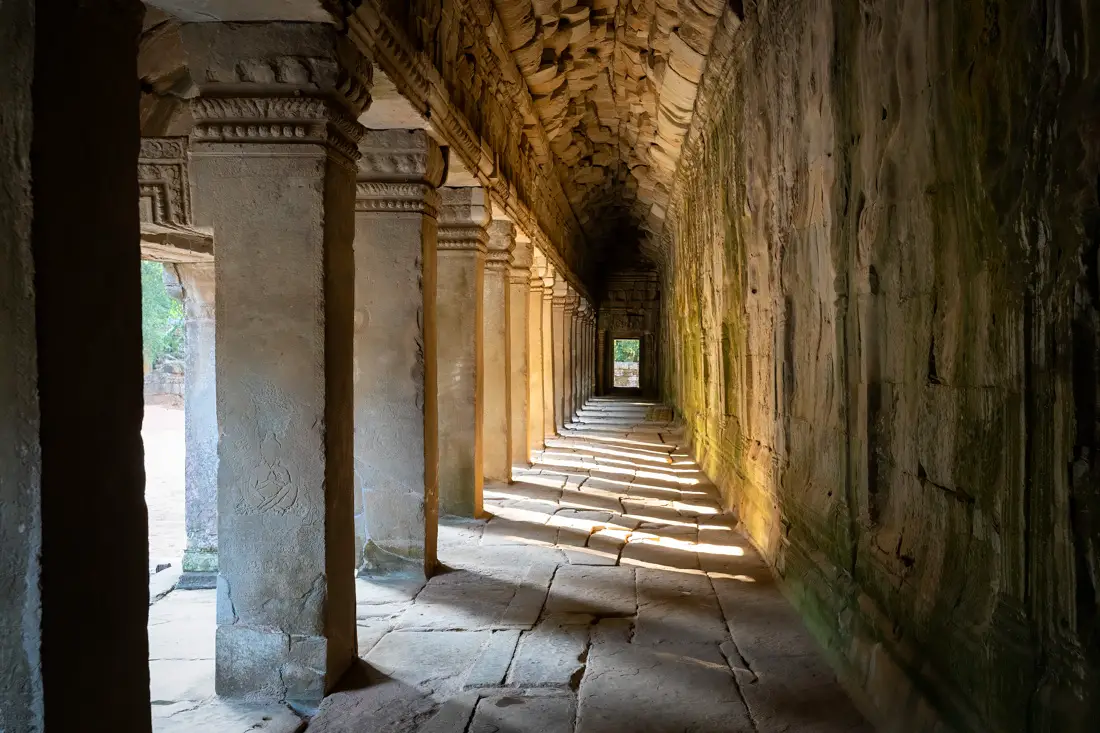
What are the main temples in Angkor Wat?
Suppose you want to make your visit more enjoyable. In that case, I recommend reading online articles about the history of the various temples or perhaps taking advantage of one of the many guides who offer services near the more prominent temples.
Let’s start with the main temple, i.e. Angkor Wat itself (Google Maps, Maps. me), which, at least during my visit, was the only one to open at dawn from 5:00 in the morning. If you want to secure a front-row seat along the pond at this spot (Google Maps, Maps. me), from where you can take the photo with the reflection, you have to enter at that time, especially if you want the picture with the towers not covered by the palm trees.
All other temples are open from 7:30 a.m. to 5:30 p.m. except for Phnom Bakheng, which closes at 6:30 p.m.
The Bayon temple(Google Maps, Maps. me) dates back to the 12th century and is famous for the many smiling faces of Brahma carved into the stone walls. This is probably my favourite temple.
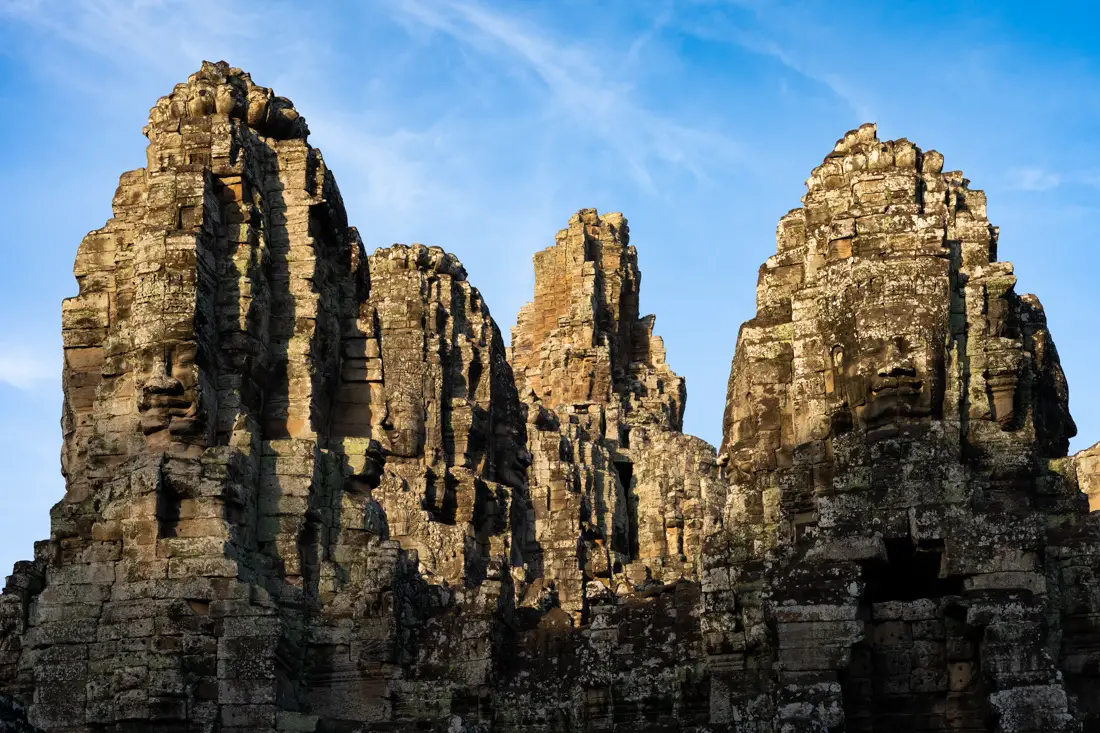
Bayon Temple.
Ta Prohm Temple (Google Maps, Maps. me) is often called “Tomb Raider Temple” because it was here that some scenes from the movie “Lara Croft: Tomb Raider” were filmed. Some trees here have wrapped around part of the temple, creating some fascinating views.
Banteay Kdei Temple (Google Maps, Maps. me) has an architectural style similar to Bayon but less complex and smaller.
Ta Keo Temple (Google Maps, Maps. me) has a particularly massive appearance due to the absence of external decoration. It is considered an example of the so-called Khleang style.
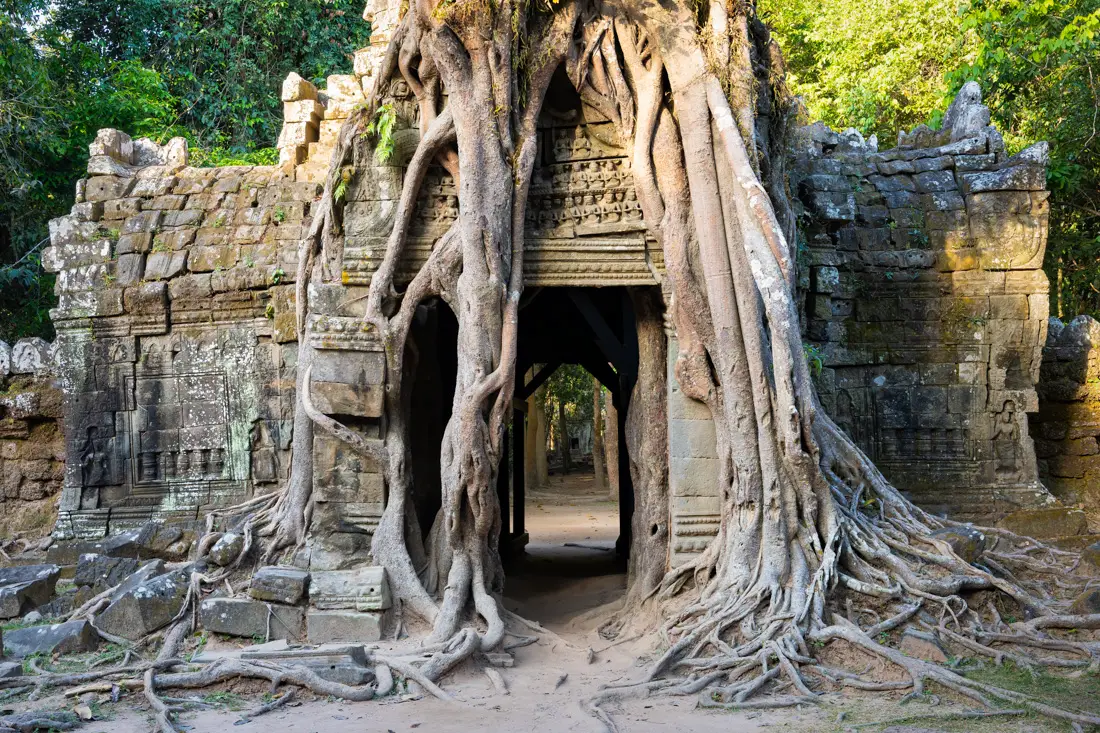
Ta Som Temple.
So far, these are the temples commonly visited on the sunrise tour, while the following are those on the sunset tour.
Like Ta Prohm, the Preah Khan temple (Google Maps, Maps. me) is mainly unrestored, with numerous trees and other vegetation growing among the ruins.
Neak Poan Temple (Google Maps, Maps. me) is an artificial island with a Buddhist temple on a circular island, which is not particularly impressive, in my opinion.

Neak Poan Temple.
The Pre Rup temple (Google Maps, Maps. me) was built as the state temple of Khmer King Rajendravarman. It is a temple mountain made of brick, laterite and sandstone.
The Ta Som temple (Google Maps, Maps. me) is a single shrine surrounded by laterite walls. Like nearby Preah Khan and Ta Prohm, the temple is largely unrestored.
The Eastern Mebon Temple (Google Maps, Maps. me) was dedicated to the Hindu god Shiva. Its location reflects Khmer architects’ attention to orientation and cardinal directions. The holes that formerly anchored the stucco are visible.
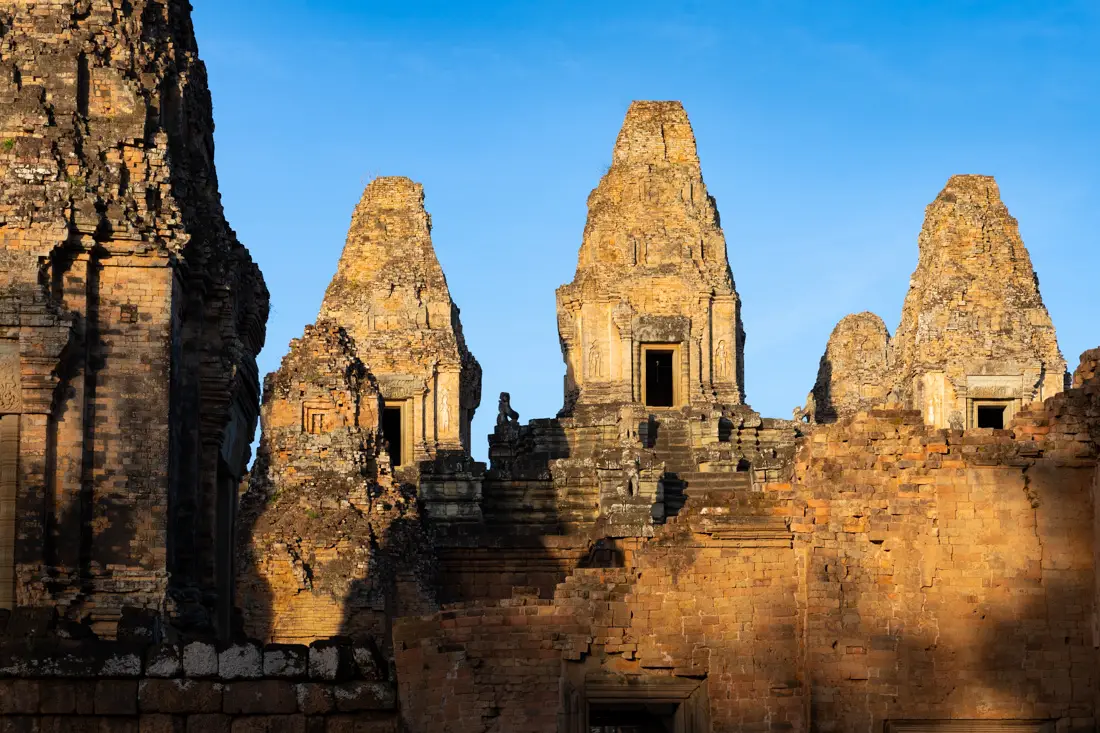
Pre Rup Temple.
Phnom Bakheng (Google Maps, Maps. me) is the temple where you are taken to watch the sunset. It is trendy, and there are a lot of people there. It is not bad, but if you have other sunsets available, I strongly recommend seeing it near the bridge leading to Angkor Wat at this spot (Google Maps, Maps. me). With any luck, the last light of the day will illuminate the temple, resulting in a unique sight, in my opinion, much better than an anonymous sunset from the top of Phnom Bakheng.
In conclusion, be aware that the food prices within the park’s confines are highly inflated, and you don’t have to play along. On the sunset tour starting around 11:00 a.m., we stopped for lunch; instead of $7 to $8 per meal as per the menu, it took us two seconds to drop to $5, whatever we wanted. I’m sure you can pay even less; all the tuk-tuk drivers you see eating around don’t spend that much.
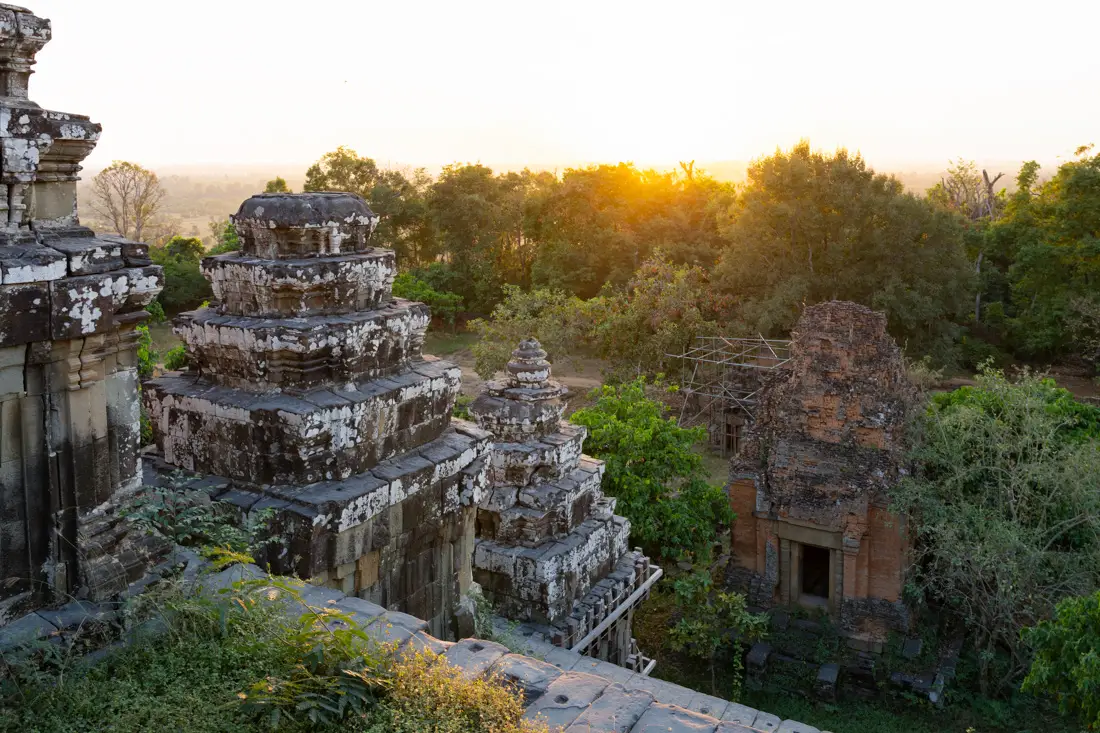
Sunset at Phnom Bakheng temple.
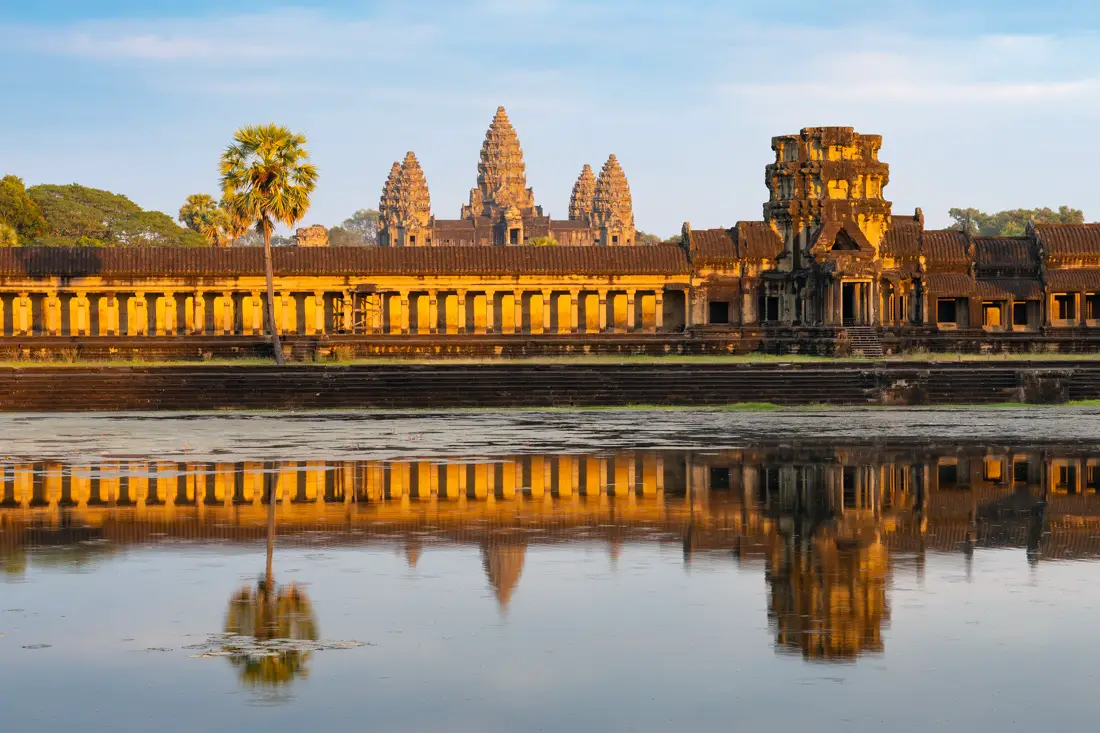
Last light of the day hitting Angkor Wat.
Other temples to visit
As anticipated, several temples are worth exploring besides the main complex. Therefore, these temples are often ignored and an excellent option for anyone who wants to escape the crowds that characterize Angkor Wat.
The Banteay Srei temple, also known as “Lady Temple” (Google Maps, Maps. me), is a 10th-century Hindu temple dedicated to Shiva. It is considered the “jewel of Khmer art” because of its intricate carvings. Located just under an hour from Siem Reap, I recommend combining the visit with the landmine museum I discuss below. Admission is included in the pass to Angkor Wat.
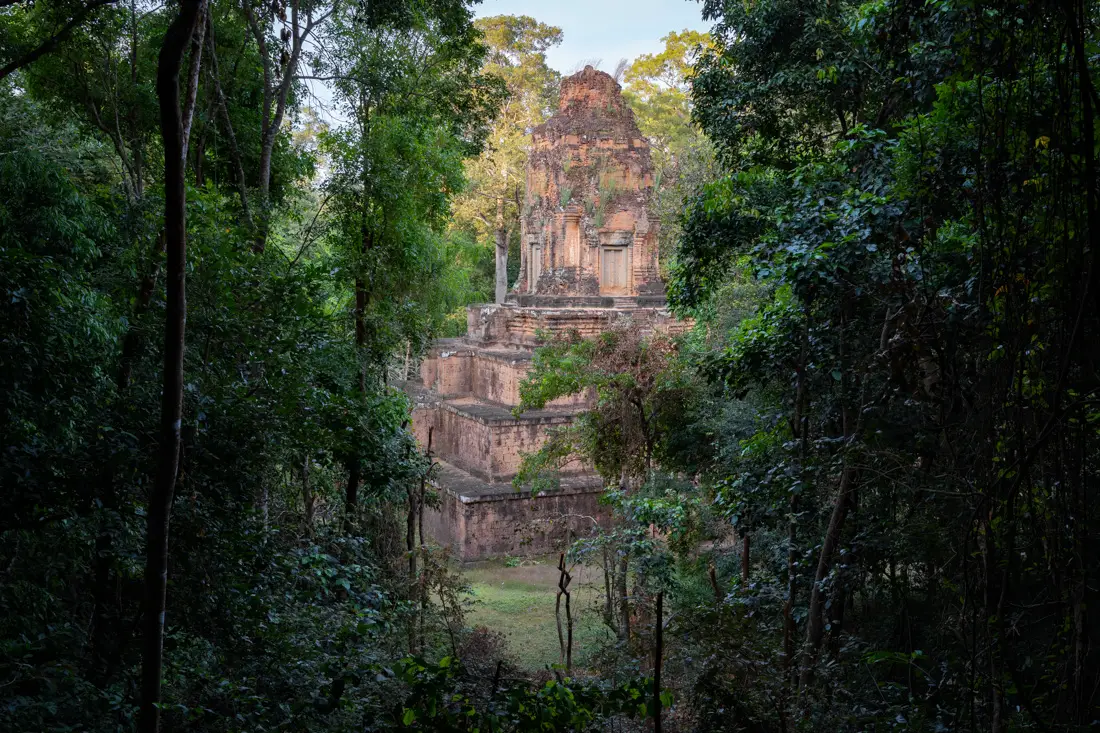
Baksei Chamkrong Temple.
Bakong Temple (Google Maps, Maps. me) and Preah Ko Temple (Google Maps, Maps. me) are within walking distance of each other and are some of the notable temples included in the most accessible pass from Siem Reap. If you decide to go to Beng Mealea, they are literally on the street, and I think it is worth a stop.
The Beng Mealea Temple (Google Maps, Maps. me), also known as the “Jungle Temple”, is about an hour’s drive from Siem Reap. As the nickname suggests, the jungle has slightly taken over, and from what I have been told, only recently have the walkways been built that make it easy to explore its interior. Still, it remains an impressive work and is one of the largest Khem temples ever built. Again, admission is included in the Angkor Wat pass.
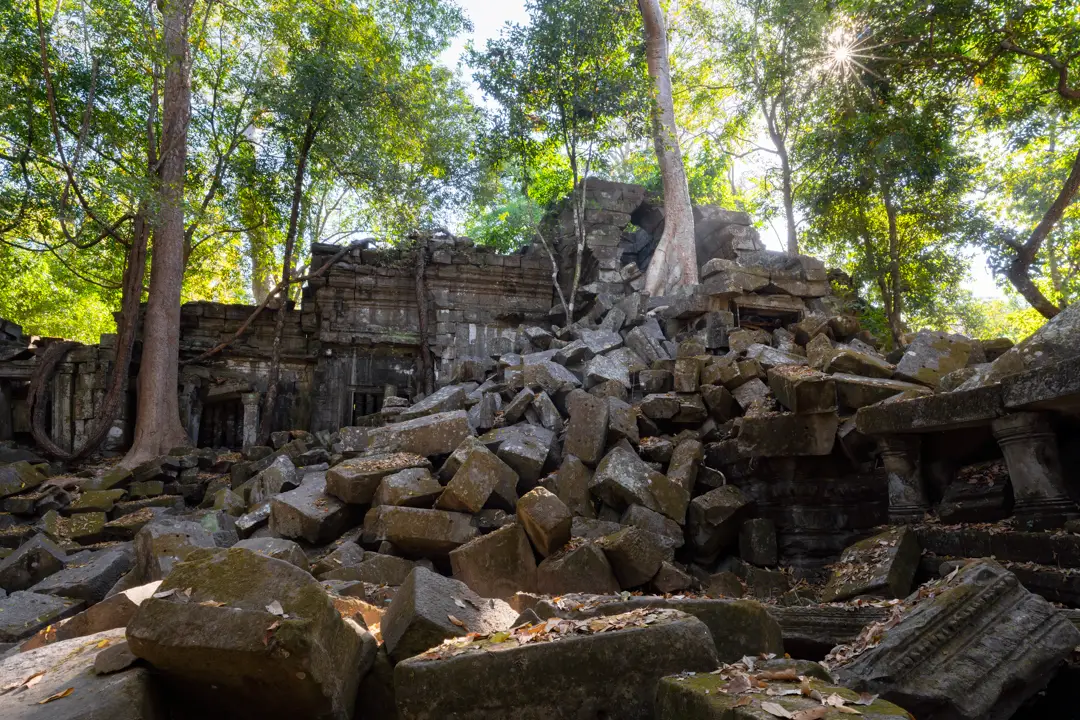
Beng Mealea Temple.
The Koh Ker temple (Google Maps, Maps. me) is more than an hour’s drive from Siem Reap, but being on the same road that leads to Beng Mealea (an hour further north), you can easily combine the visit. It is an impressive 30-meter-high pyramid nestled in the jungle. Still, even though I was already at Beng Mealea, I could not justify the additional two-hour drive there and back, not counting the fact that you must pay a separate $15 entrance fee. If interested, you can buy your ticket online at the official website. From Siem Reap, you can join a minivan tour for about $50 per person, which includes a visit to Koh Ker and Beng Mealea.
The Preah Vihear temple (Google Maps, Maps. me) is located even further north, about a four-hour drive from Siem Reap, literally on the border with Thailand, so much so that for years, there was a dispute over which country was the rightful owner. It seems fascinating, located atop a 525-meter-high cliff, but I could not justify the long drive. If interested, there are organized minivan tours that leave from Siem Reap; the price varies depending on the number of participants, and admission costs are $10.
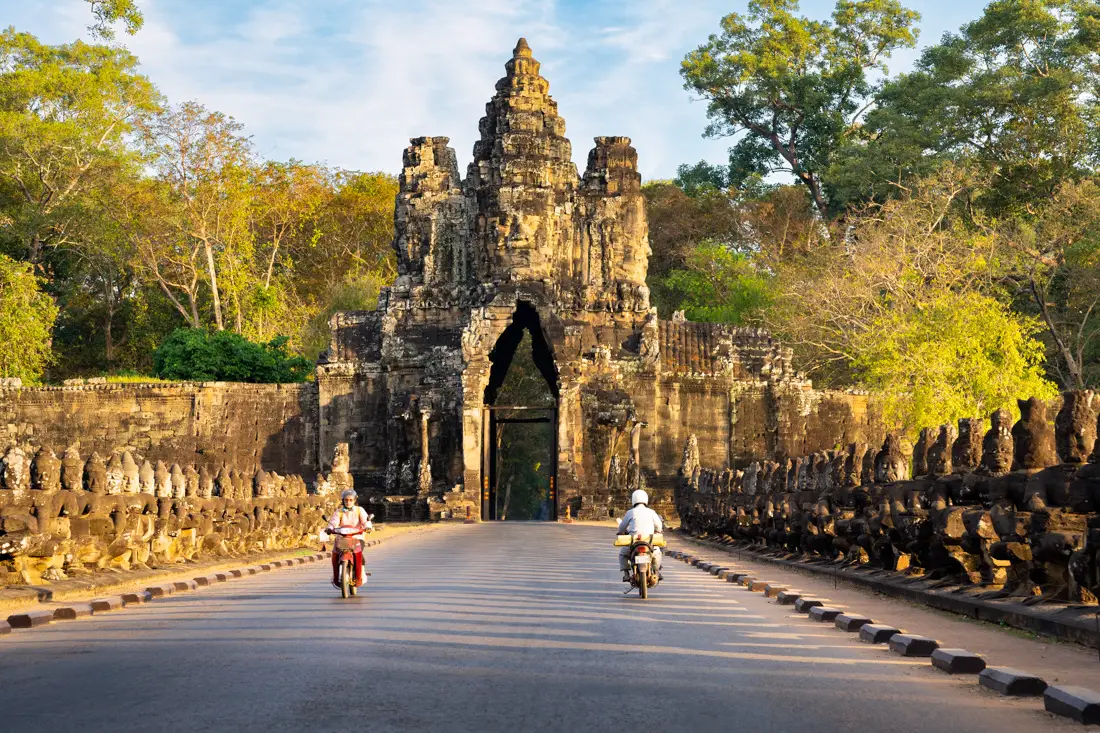
Tonle Om Gate.
Landmine museum
Especially if you decide to visit the Banteay Srei temple, I strongly recommend stopping at the Landmine Museum (Google Maps, Maps. me), whose official website is on this page. Admission costs $5, and funds raised go directly to support an NGO that cleans up landmines and other projects such as school construction (official website).
The museum first tells the story of the conflict, how landmines came to Cambodia, what is being done to remove them, and the story of its founder, Aki Ra. Snatched from his family by the Khmer Rouge at the age of 5, he spent nearly 35 years fighting for the various factions of the war in Cambodia to survive before dedicating his life to land reclamation.
I arrived at the museum in the afternoon; Aki Ra had just returned from his daily outing cleaning up mines and offered all present a guided tour of the museum. A unique experience. Should I not be as lucky, besides the various explanatory panels, there is the option of listening to the audio guide in English. There are a series of QR’s to scan with your phone, and they make Wi-Fi available. If you don’t have a sim, I recommend bringing a pair of headphones.

Kompong Khleang floating village.
Tonle Sap Lake and floating villages
An excursion to Tonle Sap Lake and one of its many floating villages is another popular excursion from Siem Reap. According to what I have read and reported from other travellers, most people visit the village closest to town, namely Chong Kneas, which has become a tourist trap. The houses have become souvenir stores, and the authentic atmosphere is long gone. If you are interested, hostels arrange shared tuk-tuk for about $10 depending on the number of participants, and once in the village, you can take a boat ride for $20.
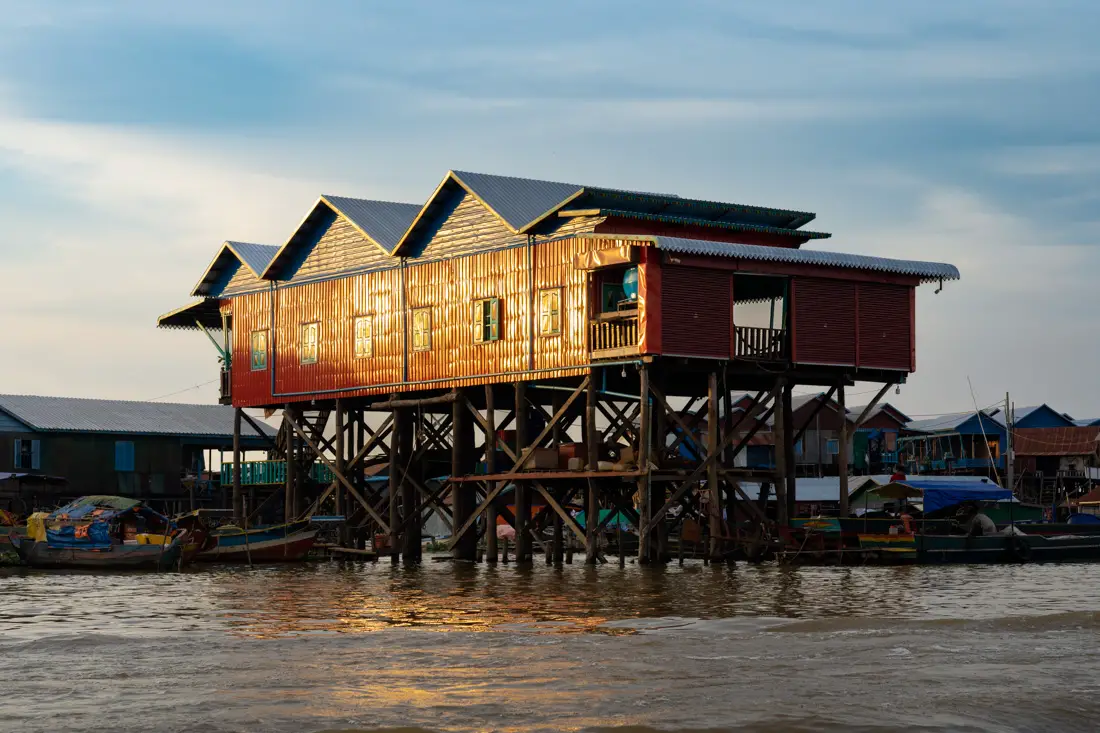
Kompong Khleang.
I participated in the Kompong Khleang floating village tour organized by an agency whose profits go directly to fund a school in the village and other charitable projects. We saw locals drying fish, visited the school, walked around the town and then went to watch the sunset over the lake. Overall, it is a good experience, but I don’t think it is worth spending $35 if you travel cheaply. In any case, you can find the official website with all the relevant information on this page. If you want, you can also contact them on WhatsApp. If you are heading to or coming from Battambang, you don’t want to spend the money for a tour, and you want to see the lake, a good compromise could be the boat trip.
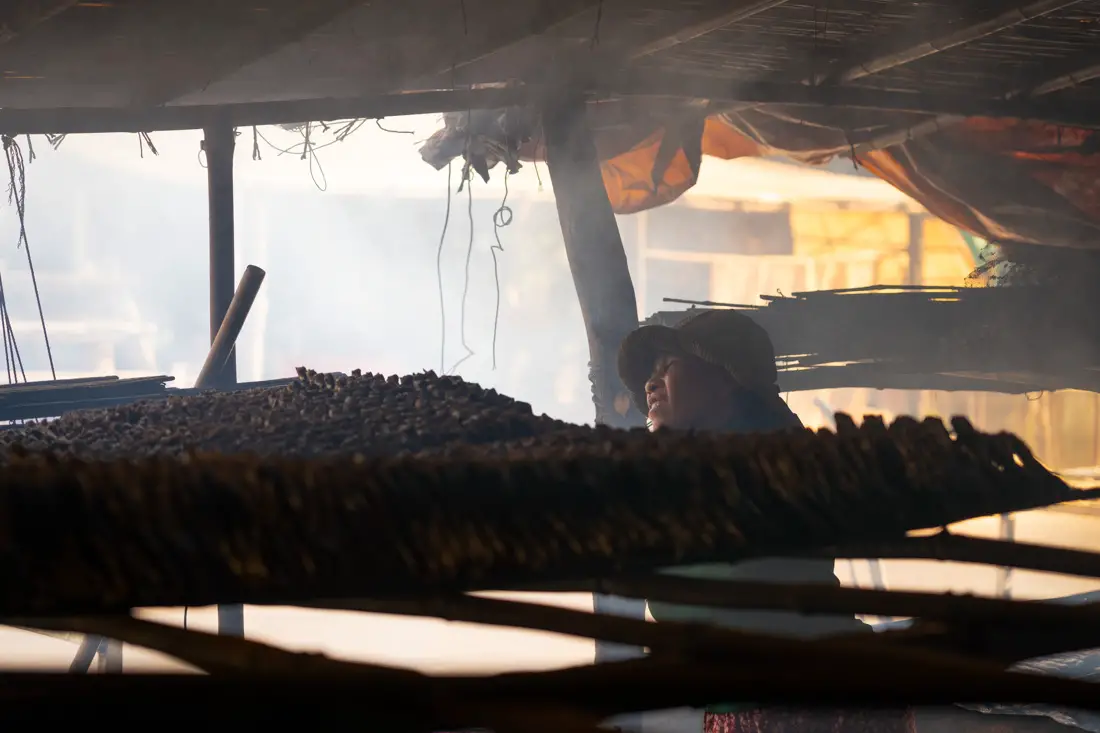
Kompong Khleang.
Phnom Kulen National Park
Phnom Kulen National Park is about an hour and a half from Siem Reap. The entrance fee is $20. The reviews did not convince me at all, and given the cost of entry, I would prefer to pass on, but I encourage you to do your research. You can find an interesting article here. The main attractions are the two waterfalls, a viewpoint, some temples, and a giant statue of a reclining Buddha.

Phare Circus
Phare Circus (Google Maps, Maps. me) is being performed by students from the Battambang school I mentioned earlier. It is the same project. You can find the official website here. Having been to the Battambang circus before, I have moved on, but I think it may be an exciting experience for those who are not planning to go to Battambang. The show is every night at 8 p.m., and admission starts at $18.
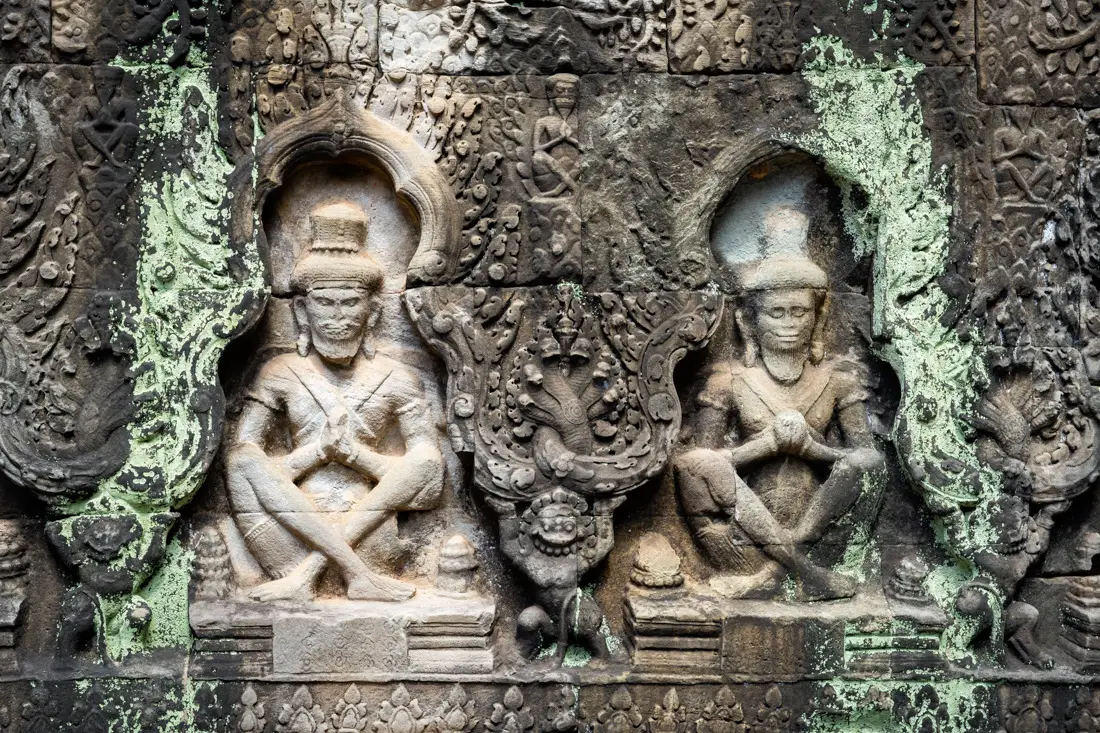
Angkor National Museum
Finally, some travellers strongly recommended the Angkor National Museum (Google Maps, Maps. me), but I have not been there, so I will not comment. The museum takes you through the history of Buddhism, Cambodia and its people from ancient times to the present day. Admission costs $12, and the audio guide $5.
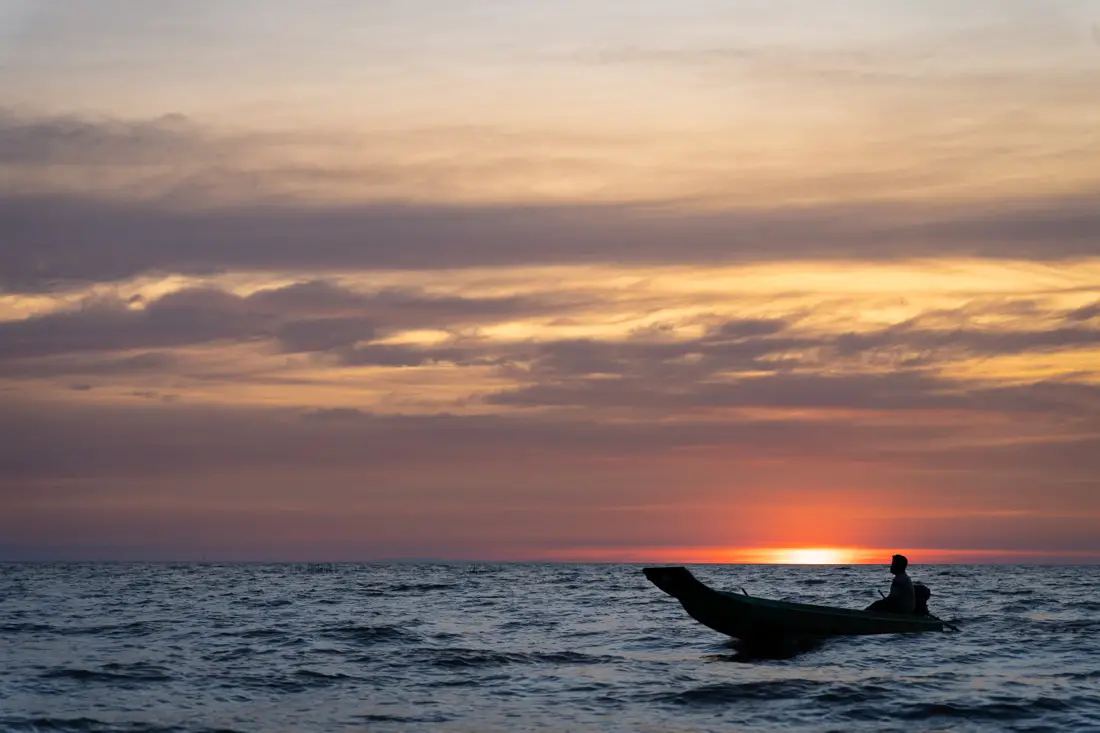
Lake Tonle Sap.
Where to eat in Siem Reap?
Some cheap restaurants that serve good food and I would recommend are My Little Cafe (Google Maps, Maps. me), Khmer Taste Restaurant (Google Maps, Maps. me) and The Red And Green Curry Angkor Restaurant (Google Maps, Maps. me).
Where to sleep in Siem Reap?
I spent a few nights at THE PLACE Hostel & Pool Bar, which was unremarkable but functional since they organised shared tuk-tuk for visiting Angkor Wat. However, this is common practice in most hostels, so I don’t think it is a discriminating factor. I spent the rest of my stay at Baahu Villa, one of the few remaining options around New Year’s Eve, and it turned out to be a perfect “hostel.” They only have one dorm, and the rest are private rooms, so by no means expect a social atmosphere, but the dorm itself is comfortable and friendly, and the staff is amiable. Finally, Onederz Siem Reap (booking on the official website is often cheaper) was recommended to me by more than one person. Noni Tree Hostel, though more expensive, had been recommended to me by a close friend.

How to reach Siem Reap?
Siem Reap has frequent connections to Phnom Penh; I particularly recommend LarryTa Express, but all major bus companies, including Giant Ibis, Virak Buntham, and Mey Hong, serve the route. The latter is probably the cheapest option. To and from Battambang, there are minivans with Virak Buntham and the option to take the boat with Angkor Express, which covers the Battambang – Siem Reap route and vice versa for $30 in about 6-7 hours. There are also night buses to Sihanoukville and Kampot. You can look at sites like 12go and Bookaway to understand the various options.
In addition to land connections, Siem Reap has attractive direct air connections to many Southeast Asian cities, which will only increase with the construction of the new airport.
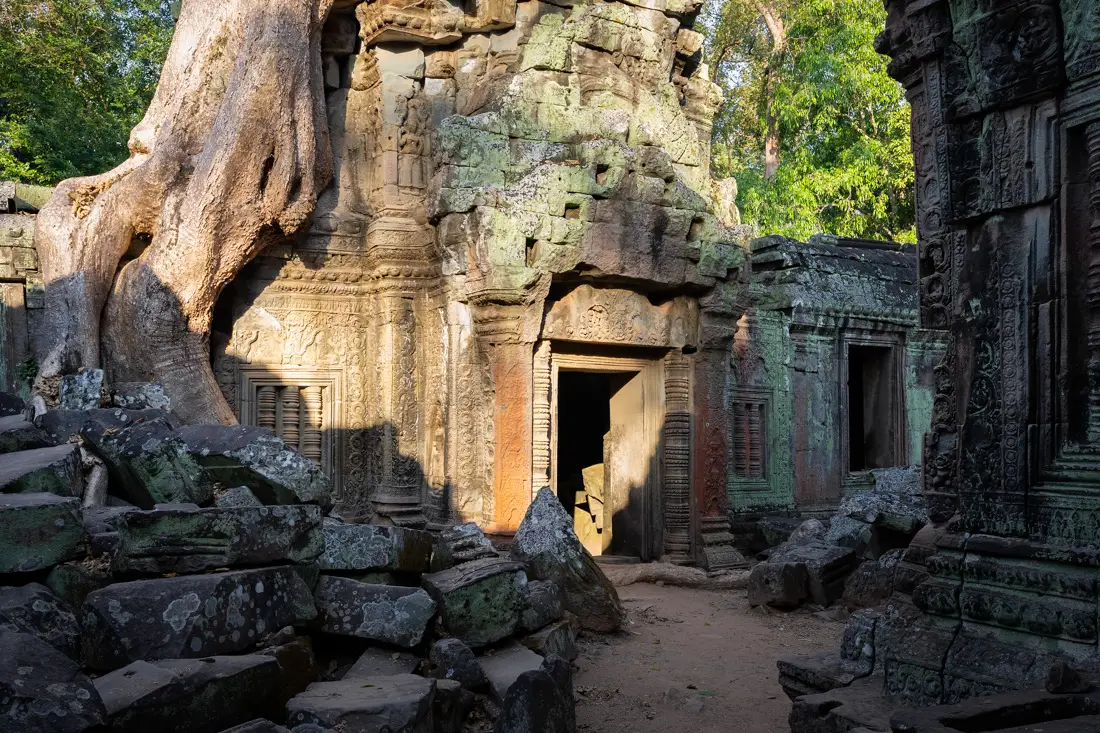
Ta Prohm Temple.
Sihanoukville
Sihanoukville has long been a popular destination for travellers. Still, unfortunately, in recent years, there has been a massive boom in Chinese investment, particularly in casino construction, and many of these facilities have not even been completed because of the pandemic. It is a big construction site that is dirty and lacking charm.
What to do and see in Sihanoukville
I think you’d be better off skipping Sihanoukville altogether and pulling straight for the islands, but if you want to stay a few days, Otres Beach (Google Maps, Maps. me), what was once a favourite destination for backpackers seems to have remained the best option anyway.
Where to sleep in Sihanoukville?
I haven’t spent the night in Sihanoukville, and you probably shouldn’t either, but as always, I think Onederz Sihanoukville is a safe bet. Booking on the official site is often cheaper.
How to reach Sihanoukville?
There are frequent connections to and from Phnom Penh with all major bus companies, including Giant Ibis, Virak Buntham and LarryTa Express. I usually do not recommend booking transportation through your lodging, but at least in the case of Onederz Hostel Phnom Penh, the minivans, in addition to the hostel pick-up, take you directly to the pier, where you can take the boat to Koh Rong and Koh Rong Samloem which is convenient. There are also night buses from Siem Reap. As always, you can check out sites like 12go and Bookaway to get an idea of the various options. You can also take the train from Phnom Penh to Kampot. Finally, it is possible to reach the city from Thailand. There are, in fact, direct buses from Trat to the border (Had Lek Thai side and Koh Kong Cambodian side) and then direct buses to Sihanoukville.
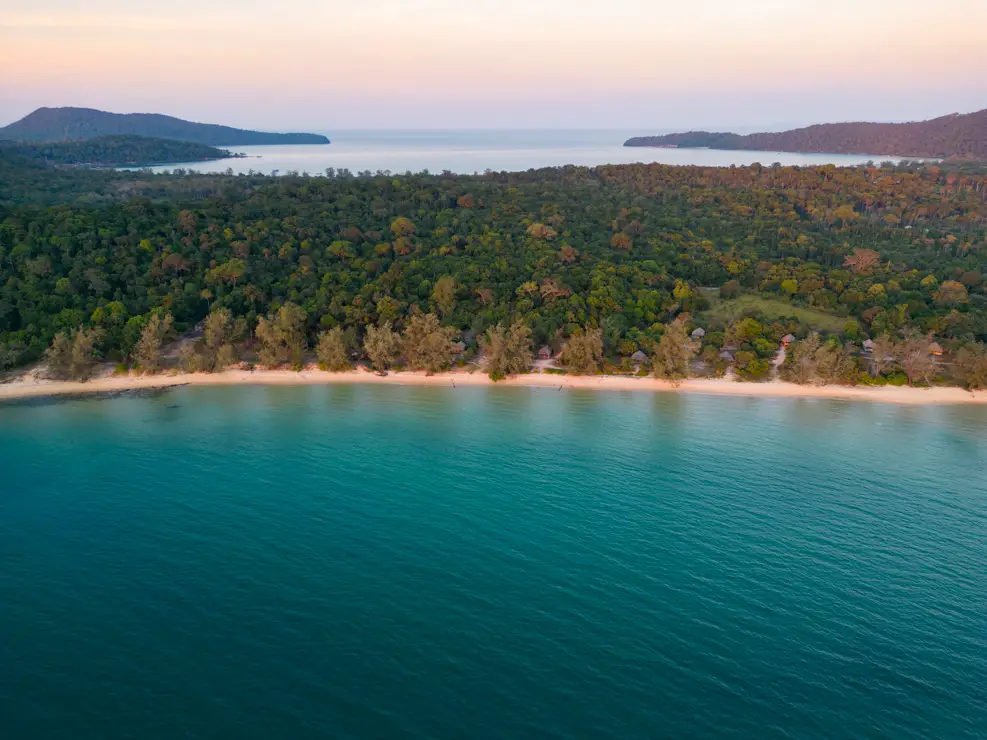
Lazy Beach, Koh Rong Samloem.
Cambodia’s most popular islands
People often associate Cambodia with Angkor Wat alone. Still, the reality is that the country has more than a few island paradises to offer anyone who wants to spend a few relaxing days at the beach.
N.b. No ATMs are on the islands, so stock up on cash before leaving the mainland!
Koh Rong Sanloem
Koh Rong Sanloem is considered the favourite island for backpackers visiting the country. Honestly, I also really liked the larger and more developed Koh Rong, but without a doubt, the smaller island retains a more authentic atmosphere and is certainly less developed.
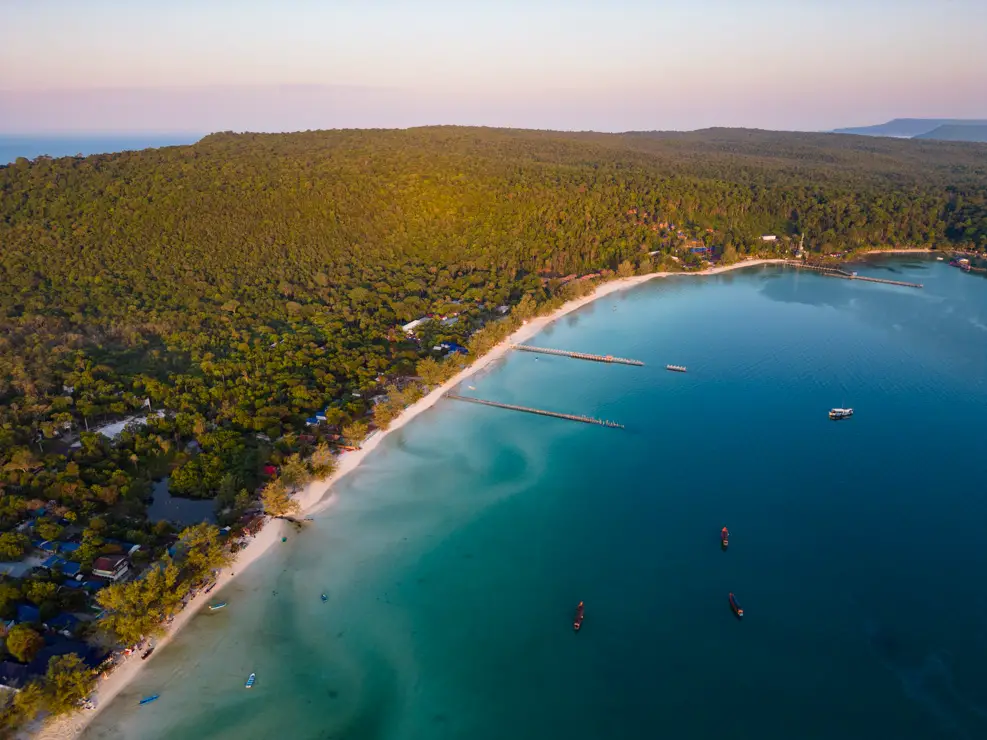
Saracen Bay.
What to do and see in Koh Rong Sanloem
I list several activities and excursions assuming you decide to sleep in Saracen Bay, but as I will discuss in the where to sleep section, it is not the only option.
Boat tours
For $10 to $15, it is possible to take part in a reasonably excellent boat tour. The program may vary depending on who organizes it, but at least in our case, we started by snorkelling and fishing and then went to M’Pai Bay to watch the sunset. On the way back, we stopped at a bay without light pollution to swim with glowing plankton, which was excellent.

M’Pai Bay.
M’Pai Bay
M’Pai Bay is a small fishing village on the island’s north side. Some travellers prefer its more authentic atmosphere, but the beaches around it are certainly not the most beautiful on the island. I was there briefly when I participated in the boat tour and then spent a few days there before continuing to Koh Rong. Some travellers go there in the day by taxi boat, and similarly, I met someone in M’Pai Bay who went to Saracen Bay in the day by taking a taxi boat in the morning and returning by supply boat in the evening.
At M’Pai Bay, you could rent a kayak and go snorkelling in nearby Koh Koun (Google Maps, Maps. me); the northeast side is where they took us on the boat tour. I walked to Clear Water Bay (Google Maps, Maps. me); the trail is mapped out on Maps. Me, and the beach is lovely and semi-deserted. It takes a little over an hour. Finally, at the beach just outside the village (Google Maps, Maps. me), you can see the plankton without taking any tour.
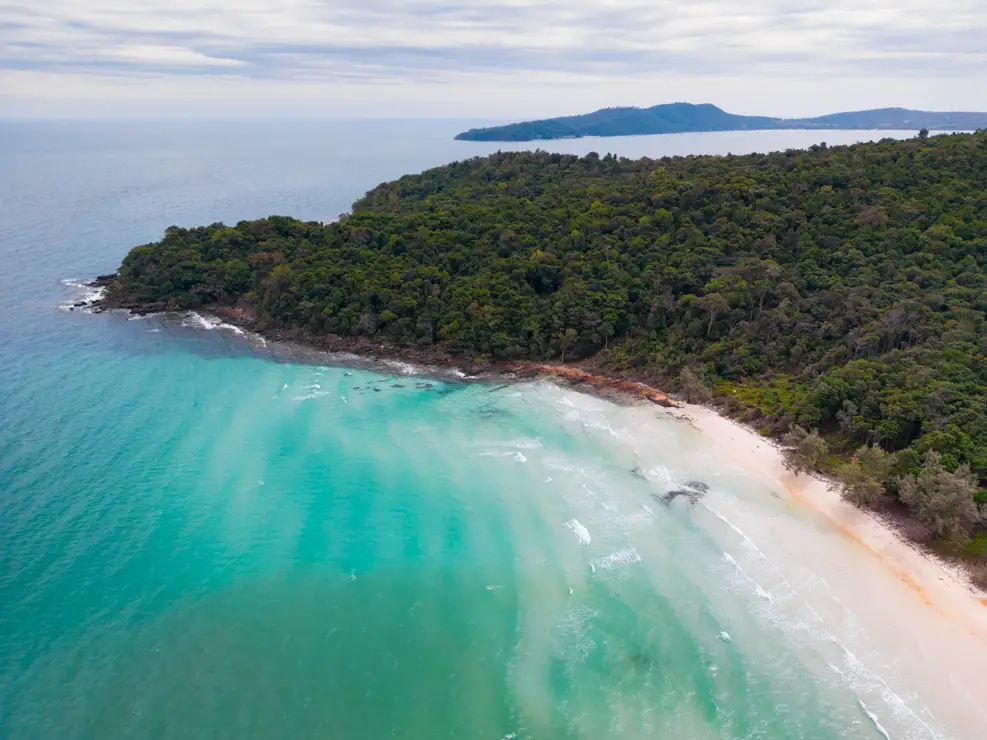
Clear Water Bay.
Sunset Beach
To get to Sunset Beach (Google Maps, Maps. me) from Saracen Bay, you have to walk for about half an hour; at one point, the dirt road turns into an absolute path through the forest. I did it in flip-flops with no problem, but I’m sure someone would prefer to have a pair of shoes, especially if you decide to stop for sunset and then come back in the dark. If you have a headlamp, bring it, or at least ensure you have enough battery on your phone. There are at least a few bars and restaurants on-site where you can get drinks or food. In my opinion, the beach is not as beautiful as Saracen Bay, but it is much quieter and, as the name suggests, the perfect place to watch the sunset.
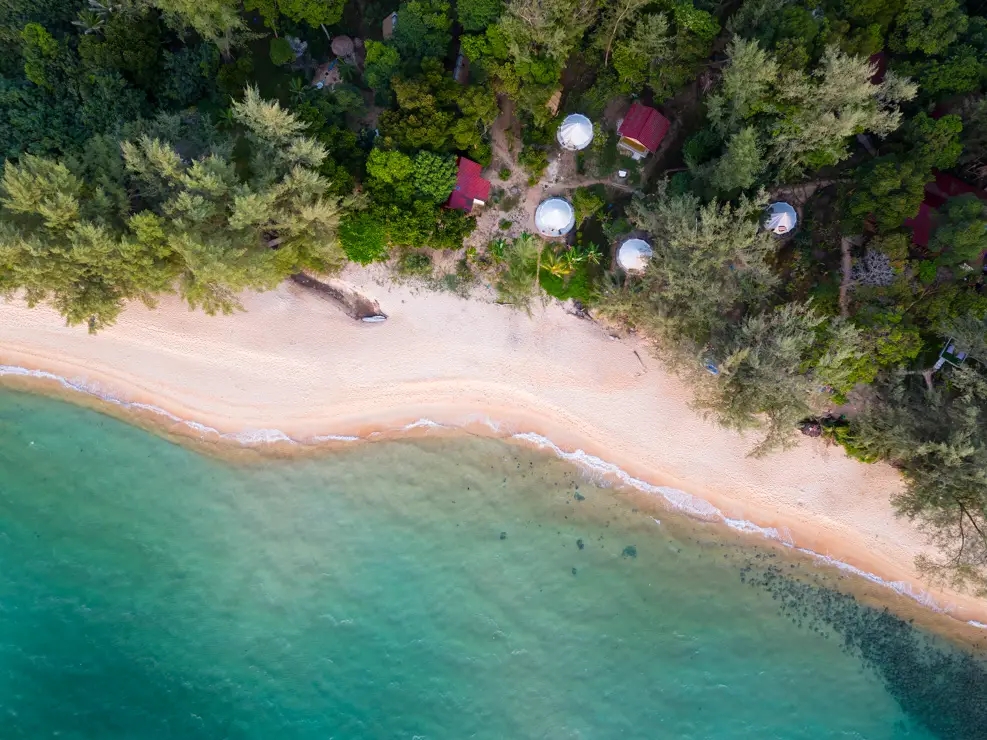
Sunset Beach.
Koh Rong Sanloem Lighthouse and Lazy Beach
Reaching the lighthouse (Google Maps, Maps. me) starting from Saracen Bay takes just over an hour; once on site, the keeper charges $1 to go up. The view is beautiful. I recommend continuing along the coast toward what Google Maps calls Twilight Beach while on Maps. It is called Military Beach. Walk to the end of the beach, where there is a path through the forest that leads to some lovely stone carvings (Google Maps, Maps. me), and if you continue further, there is an excellent viewpoint at this location (Google Maps, Maps. me). From here, you can turn around and head down to Lazy Beach. Together with a group of guys, we slowly left around 2:30 p.m. and arrived at Lazy Beach just before sunset. Leave early in the morning to avoid the heat while walking and spend the afternoon at Lazy Beach (Google Maps, Maps. me). I think it’s a great way to spend the whole day.
If you don’t feel like doing the whole circuit, I recommend riding to Lazy Beach; it only takes about 20 minutes from Saracen Bay. The beach is lovely, and you can see the sunset there.
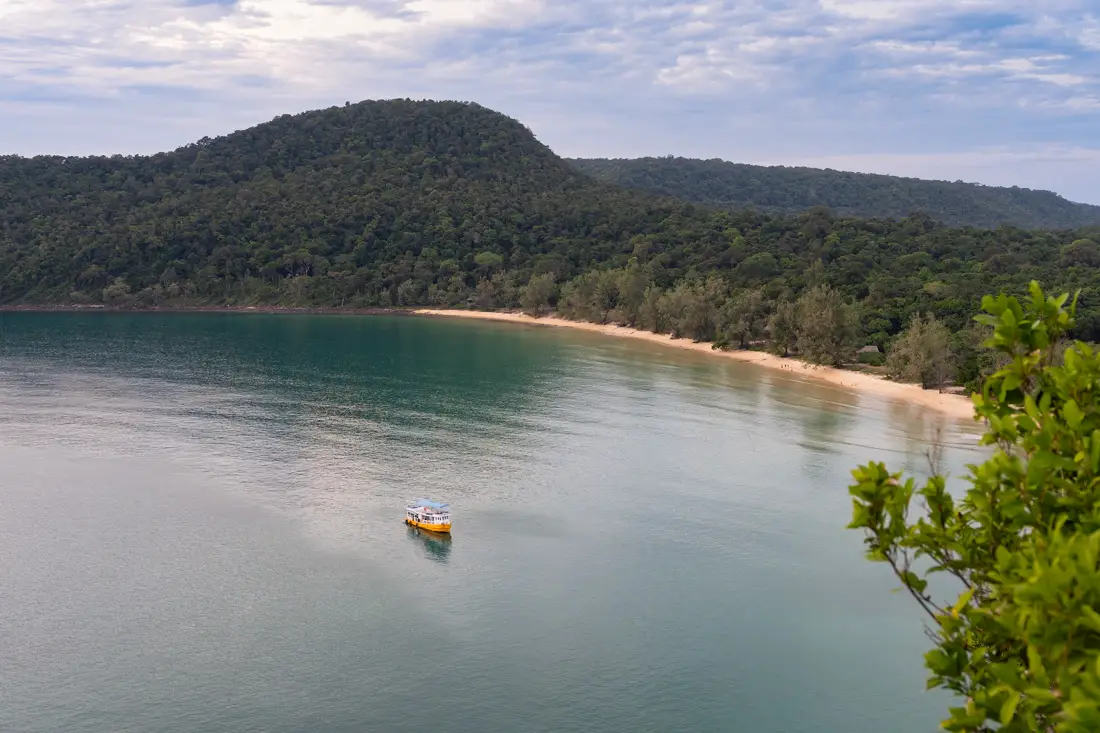
Lazy Beach.
Freedom Waterfall
Freedom Waterfall (Google Maps, Maps. me) is the waterfall at the side of Saracen Bay. Officially, they charge a dollar to go up the short path and use the man-made pool built at the base, although when I went, no one asked me for anything. In early January, as you can see from the photo, the waterfall was unimpressive, but it’s not that bad if you’re looking for a place to cool off.
Diving in Koh Rong Samloem
Finally, if you want to dive around the island, a friend did a couple of them with The Dive Shop Saracen Bay and all in all, he was satisfied, but don’t expect to see big fish; the unregulated fishing has pretty much wiped them out.
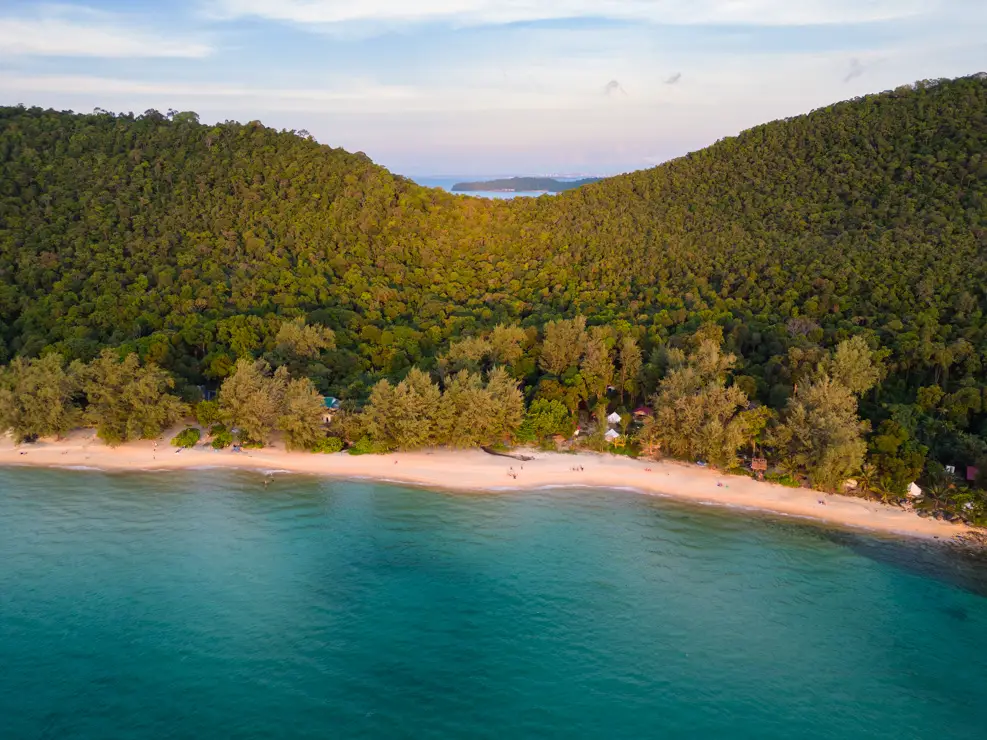
Sunset Beach.
Where to sleep in Koh Rong Samloem?
Saracen Bay is by far the most popular choice among travellers. It is a wide bay of white beach and shallow water, and besides being pretty (in my opinion, the most beautiful beach on the island), it is also the most convenient location to reach since all speed boats stop here at one of the two piers.
For a change, I slept in Onederz Koh Rong Sanloem. There are slightly cheaper options in Saracen Bay, but I think it is worth spending a few more dollars on. This is a perfect hostel. Booking on the official website is often cheaper. They have a party every Thursday, so plan accordingly.
If you are looking for a quieter location, you could sleep at Sunset Beach, where there are more than a few exciting options: Sleeping Trees, KAMAKU Bungalows and SunBoo Beach Bungalows. If you are travelling light, getting off at Saracen Bay and continuing on foot is feasible, but as written above, the last stretch is a natural trail through the jungle. Alternatively, you could arrange a cab from Saracen Bay or M’Pai Bay and ask for the best accommodation.
Lazy Beach has a similar atmosphere, but at least at the time of writing this guide, there are no hostels. MadMonkey has a hostel on a secluded cove north of Saracen Bay; I have never been to a MadMonkey (it is a chain of party hostels), but if that is what you are looking for, it might be an option to consider for a few days. If I’m not mistaken, they hold a “big party” once a week.
The last popular option is M’Pai Bay. I spent a couple of days at The Cliff Hostel, M’Pay Bay; the hostel is in a location that is as cool as it is “inconvenient” to get to. It wasn’t a problem for me, but honestly, you could just go there and spend a few hours in the day since the ordinary area/bar is open to everyone and sleep in one of the two hostels that are located in the centre of the small village: Bonsai and Lazy Bones. If you decide to sleep in M’Pai Bay, you should go to the Seapony Cafe for breakfast.
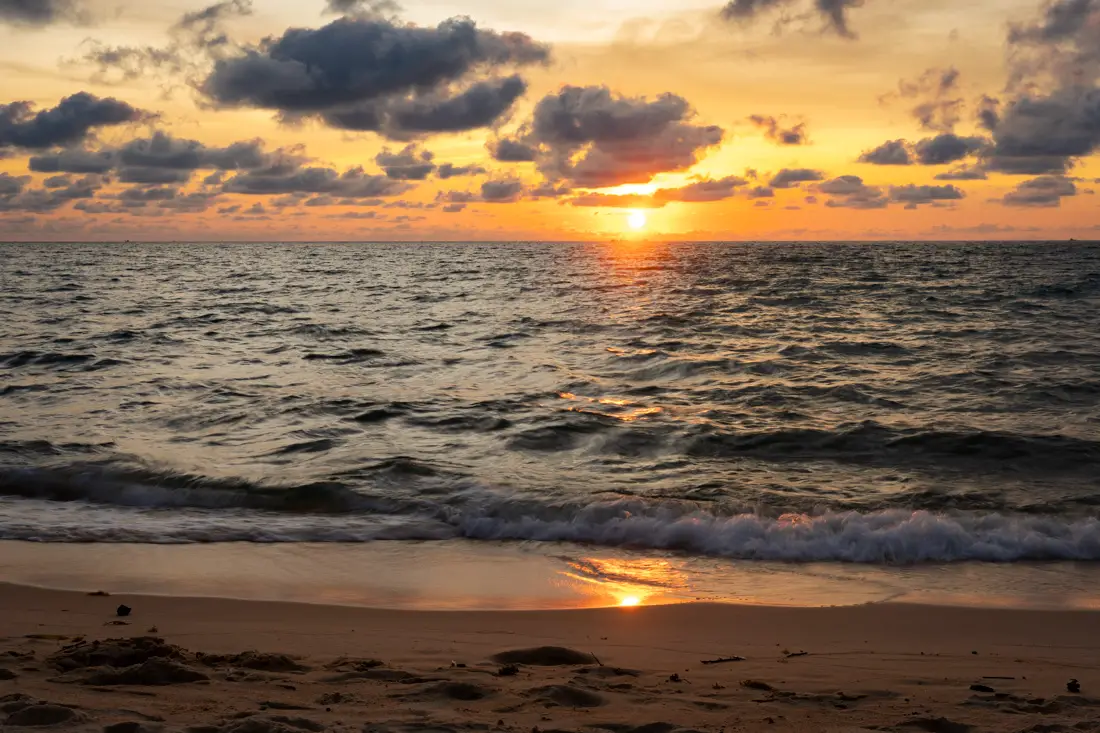
Sunset Beach.
How to reach Koh Rong Samloem?
To reach Koh Rong Samloem, you must go through Sihanoukville, which has several daily departures from the port. In the past, boats departed from the pier near the centre, but this has not been the case for a few years, and some guidebooks are outdated. This is the location of the harbour entrance (Google Maps, Maps. me) from where GTVC, Island Speed Ferry and Buva Sea operate. Generally, one company is worth the other; the round-trip ticket costs $25 and 45 minutes, and you don’t have to return to the mainland from the same island/dock or choose a return date. I, for example, did Sihanoukville – Saracen Bay one way but then returned from Long Set Beach Koh Rong almost three weeks later. Be careful, however, because not all companies make the same stops; some go only to Saracen Bay, while others also stop at M’Pai Bay. Similarly, some companies only go to Khao Touch Beach on Koh Rong while others also stop at Long Beach. GTVC seems to be the company that offers the most comprehensive choice, but to be safe, ask the ticket office for confirmation based on where you decide to stay and confirm return times because they vary daily.
A cheaper option is to take the supply boat (supply boat) that shuttles between the mainland and the two islands every day. It is a yellow boat, so you can’t go wrong. I’m not sure about the departure time, but it should be in the early afternoon since it takes 2-3 hours to reach the pier on the north side of Saracen Bay (Google Maps, Maps. me) around 5 pm before continuing to Mpay bay and finally Koh Rong. There is no need to bake in the sun; from when it arrives to when it departs, at least half an hour has passed (they have to unload the cargo) so you can safely wait on the beach. The supply boat is the cheapest way to get from one bay to another or from one island to another, especially if you travel alone. I paid $5 from Saracen Bay to Mpay Bay and another $5 a few days later for the Mpay Bay Koh Rong leg (6 p.m. departure). I strongly recommend confirming times once on site. Alternatively, cab boats can be arranged; group travel may be more convenient and practical. From Samloem to Koh Rong, they charge $20, so in 4, it costs as much as the supply boat.

Koh Rong Samloem lighthouse.
Koh Rong
Backpackers often snub Koh Rong, but there is no shortage of heavenly beaches. That said, if you must necessarily choose between the two, I can only join the chorus of voices recommending Koh Rong Sanloem.
What to do and see in Koh Rong
I spent much of my day on the island lazing on the beach, and below I will try to list the ones that are the best, but if interested, I know that a boat tour is offered similar to the one provided on Koh Rong Samloem that includes some snorkelling and plankton.
White Beach
White Beach or Kaoh Touch Beach (Google Maps, Maps. me) is the island’s main village beach where the supply ship arrives, and all the speed boats also stop. It is the busiest area, with many bars and restaurants, but the northern part of the beach is not that bad.
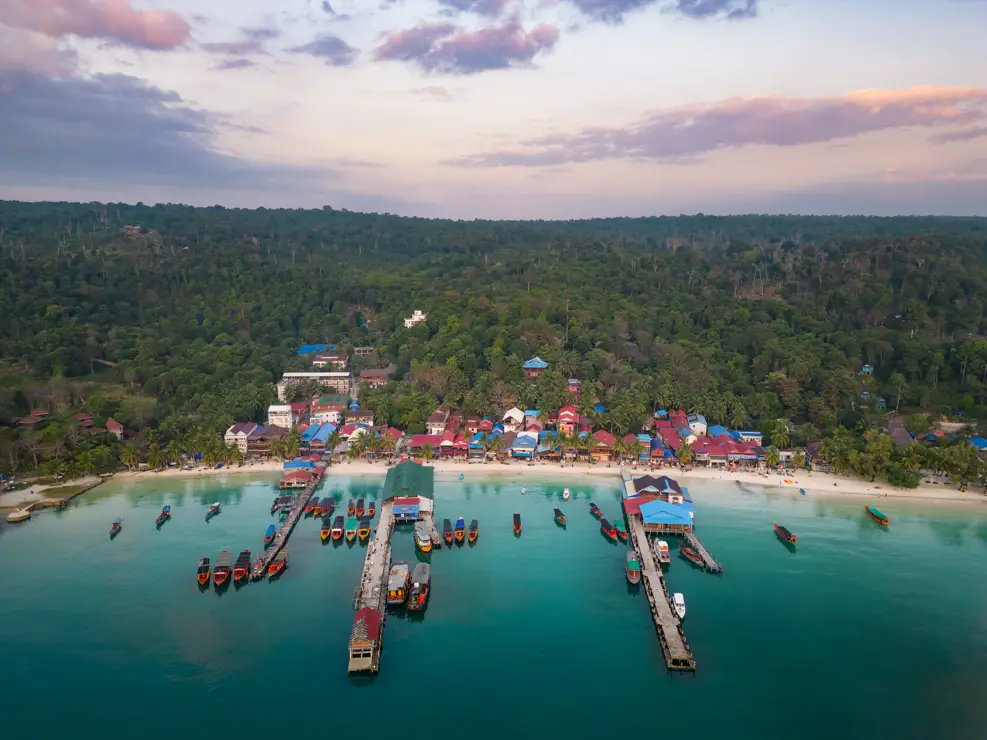
White Beach.
Long Beach
As the name suggests, Long Beach (Google Maps, Maps. me) is a long beach on the island’s west side. White beach and crystal clear water. Perfect location for watching the sunset. There are a lot of resorts, and you can walk along the beach but don’t place your towel; whether this is legal or not, I don’t know, but the southernmost stretch is considered a “free beach.” I walked there one of the days I stayed at White Beach, but if you want, you can take a tuk-tuk or rent a scooter.
If you’re feeling adventurous, I took one of the trails plotted on maps. That connects White Beach to Long Beach via the forest. I got lost a couple of times, and the GPS track is not 100% reliable. In places, yellow ribbons are marking the trail. However, it is by no means obvious. It took me about an hour. I strongly recommend shoes, even though I did it in flip-flops. On the way back, I walked along the road.
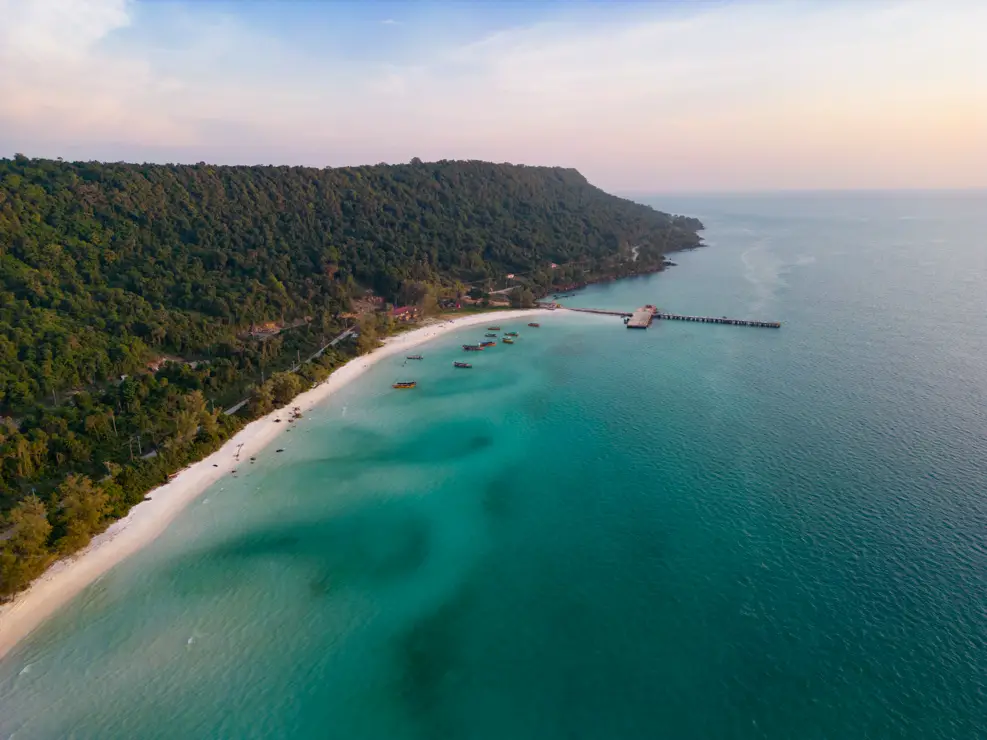
Long Beach.
4K Beach
4K Beach or Long Set Beach (Google Maps, Maps. me) is, in my opinion, the most beautiful beach on the island and where I recommend staying, as written earlier in the where to sleep section. If you decide to stay at White Beach, you can walk to 4K beach. I did it with my backpack when I changed hostels, but be aware that at some point, you have to cross the estuary of a small coastal lagoon at a high tide. It can be tricky because the water level can safely reach your chest. I had to cross with my backpack over my head.
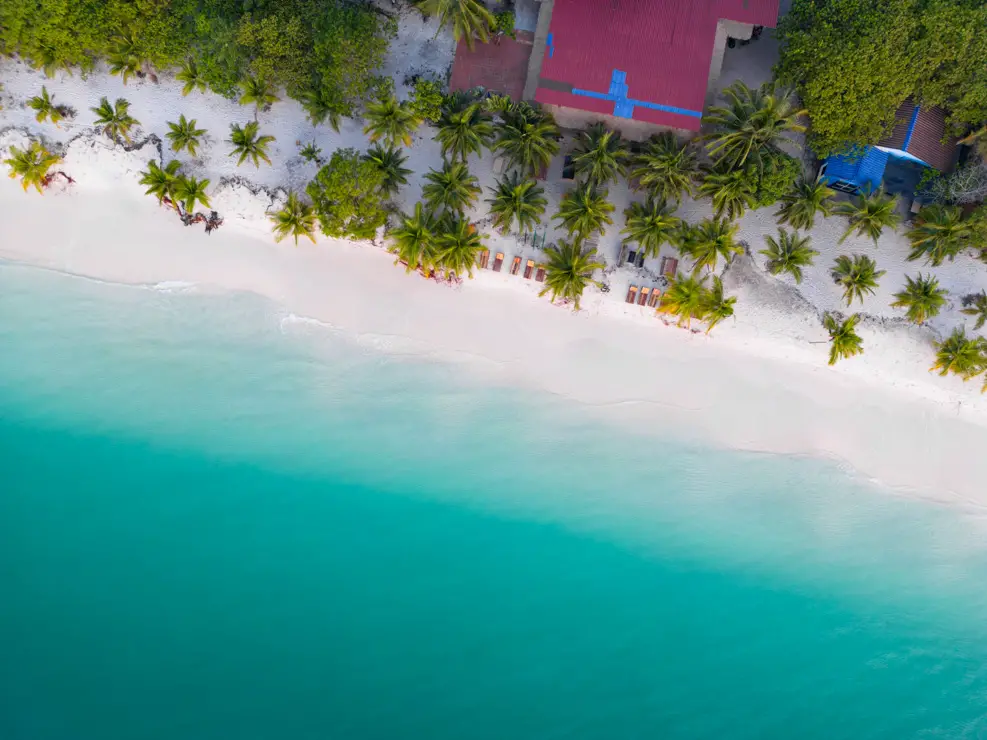
4k Beach.
Coconut beach
Coconut Beach (Google Maps, Maps. me) is a secluded beach on the island’s east side. It is within walking distance if you stay at 4K Beach. It took me about an hour and a half; the route, well or poorly, is as plotted on maps. But you have to go by intuition in a couple of places. It is an excellent way to spend half a day. Coconut Beach Bungalows has an expensive restaurant; the snorkelling in the northern part of the beach is not bad.
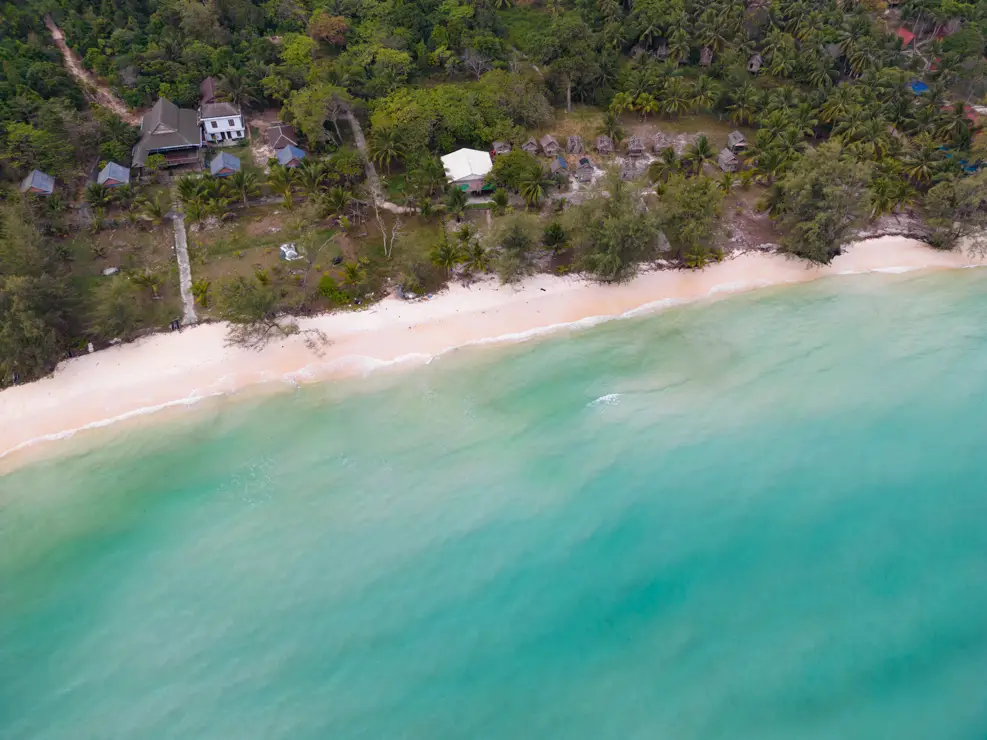
Coconut beach.
Lonely beach
Lonely Beach (Google Maps, Maps. me) is far north of the island. I have not been there because I would have had to rent a scooter; the last stretch has to be done on foot. They charge $15 a day, including gasoline. I didn’t need to see another beach, but renting a scooter can be an excellent way to spend the day, especially if you don’t feel like walking and can combine visiting multiple beaches.
Where to sleep in Koh Rong?
I spent a few nights at Lost Boys but I do not recommend it. Nest Beach Club and especially Funky Beach Hostel are located on the most beautiful beach on the island (4K Beach or Long Set Beach). I slept at Funky as soon as it opened and would have recommended it with my eyes closed, but from what I read, unfortunately, they seem to have some cleanliness issues. I encourage you to read and evaluate some recent reviews, but it would be a spectacular location if they were to fix the problem. If you want a more relaxed atmosphere, consider spending a few nights at Coconut Beach Bungalows or Lonely Beach.
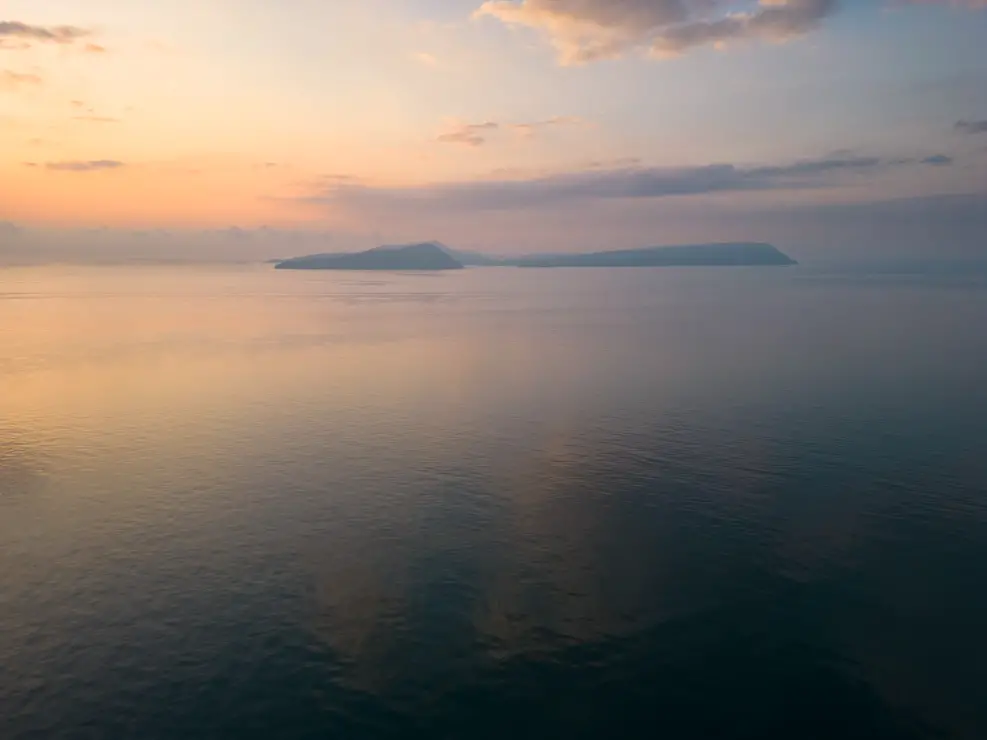
Koh Rong Samloem.
How to reach Koh Rong?
What was discussed in the “How to get to Koh Rong Samloem” section applies. I will only add that, as far as I know, the two piers where the speed boats stop are White Beach and 4K Beach. If you decide to stay somewhere else, you will likely have to arrange another transportation once you arrive. Again, ask the ticket office for confirmation based on where you decide to stay and confirm your return times.

Koh Ta Kiev
Koh Ta Kyiv was undoubtedly one of the highlights of my trip to Cambodia, and while I also really liked Koh Rong and Koh Rong Samloem, virtually every traveller I met on Koh Ta Kyiv, who was coming from the two most famous islands, much preferred it.
Although the island is close to the coast, it retains that desert island atmosphere that the other two islands have long since lost. There are no picture-postcard white beaches, but if you are looking for a place to escape from civilization for a few days or weeks, look no further.
Part of the enjoyable experience was staying at Kactus, a facility surrounded by nature with basically a beach since there are no other buildings around and a nice common area that serves as a bar/restaurant. There are no other options to eat nearby, and meals cost $4-$6, so they are not cheap, but the atmosphere is unique, and free activities like yoga are organized.
To get around the island, there are several well-marked and maintained trails; you can reach a fishing village on the island’s north side and walk for about an hour and a half. There is a cliff where you can dive in and, with some imagination, see the silhouette of an Elephant Rock (Google Maps, Maps. me). If you are interested, a boat tour is offered every evening to see the plankton, but if you want, you could simply walk along the beach away from the lights to have just as good or bad an experience. Should you feel particularly active, the staff is more than willing to recommend various activities, but I’m sure you’ll spend your days on the island in total relaxation. It is a little gem that deserves to be visited; take advantage of it before it’s too late.

The Beach where Kactus is located.
How do I reach Koh Ta Kyiv?
There is no public transportation to the island, but the various accommodations have a boat that shuttles people to and from Ream Beach daily. As anticipated, I slept at Kactus, and at least during my visit, their boat would leave the island at 11:30 a.m. and depart from the mainland at 12:30 p.m. Their pier is located at this spot (Google Maps, Maps. me). The cost is $15 round trip. If you come from Sihanoukville, you must take a tuk-tuk to and from Kampot. Shared cabs can be arranged; I paid $15 when I left the island. In any case, when you book, you are sent all the relevant information. The other popular option among backpackers, Crusoe Koh Takiev Island, operates similarly and is not far away.
Where to sleep in Koh Ta Kiev?
As anticipated, I slept at Kactus and cannot recommend it highly enough. Don’t expect a luxurious experience, but it is a special place you will have difficulty leaving. I recommend booking in advance because they are often fully booked except for the tents, which are not the most comfortable. The alternative is Crusoe Koh Takiev Island, which has excellent reviews, but I was not particularly impressed when I went there for the day.
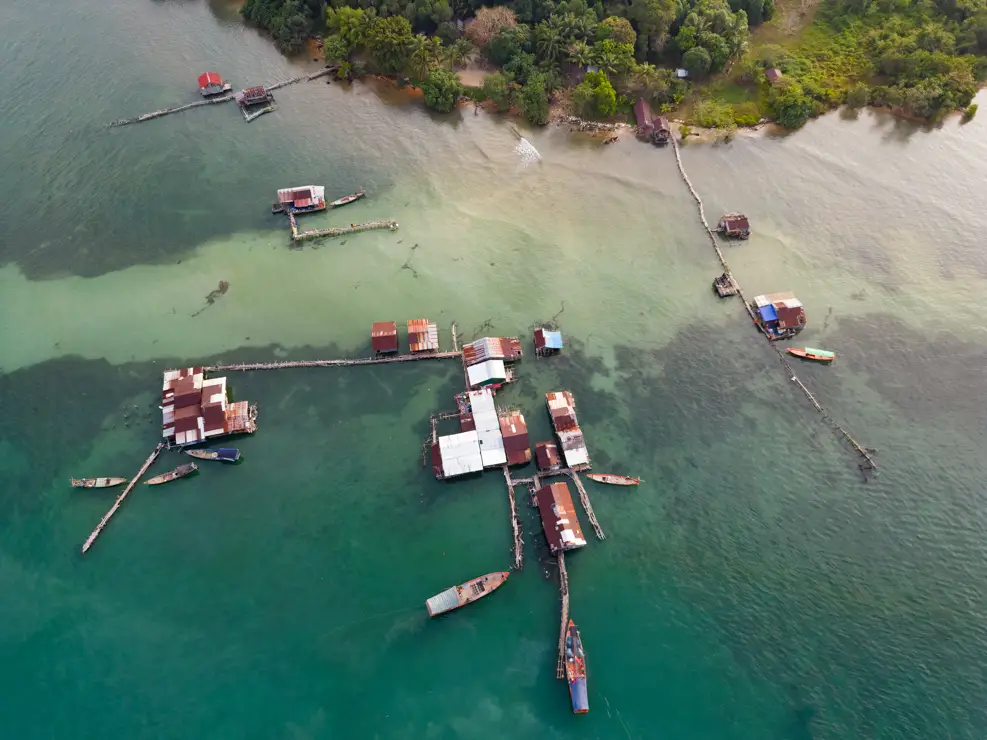
Koh Ta Kiev floating village.
Koh Russei (Bamboo Island) and Koh Tonsay (Rabbit Island)
I have yet to go to either island, but you might consider them if you want to get even further off the classic tourist track. Koh Russei is located not far from Koh Ta Kyiv. In the past, there was at least one budget accommodation suitable for backpackers, i.e. Koh Ru Bungalows, which does not seem to have reopened after the pandemic. There are exclusively high-end accommodations to date, but things may change.
Koh Tonsay, on the other hand, is only a 25-minute boat ride from Kep and offers at least a couple of inexpensive options to stay, such as Simone Rabbit Island and Khim Vouch ay Bungalow; the island looks nice.
Chi Phat (Cardamom Mountains)
This is another destination I have not personally visited but have been recommended by a few travellers. It could be an exciting option if you want to immerse yourself in nature and support an excellent ecotourism project. The Cardamom Mountains occupy a mountainous region with many protected natural areas, including one of the last unfragmented rainforests in Asia.
If you want more information, I recommend checking the official website, where you will find detailed directions to the village. Another exciting project in the region that you might consider is Cardamom Tented Camp. Still, many other entities operate within Botum Sakor National Park and the Phnum Samkos Wildlife Sanctuary. Often, these are not cheap experiences, but at the same time, you will support some lovely conservation projects.
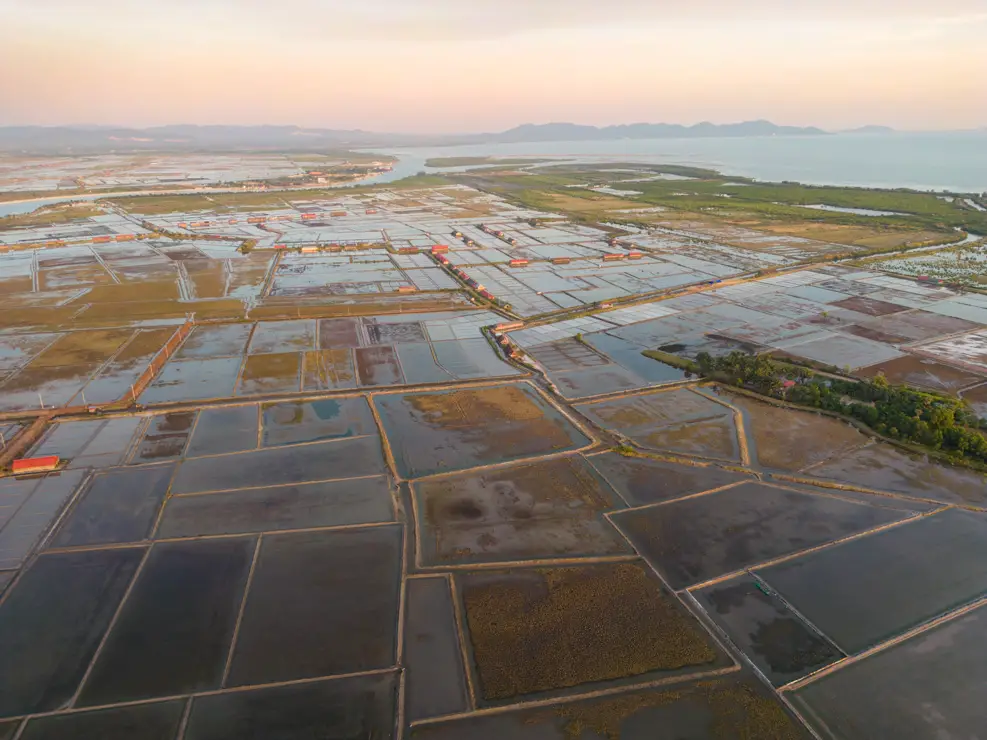
Kampot salt flats.
Kampot
Kampot is a relaxed river town in southeastern Cambodia. It is an ideal base for Bokor National Park and many other attractions, including the famous plantations where the well-known Kampot pepper is harvested.
What to do and see in Kampot
The city itself does not have much to offer except a relaxed atmosphere. There are a few lovely colonial buildings here and there. Still, most attractions are outside the city except for the Kampot Museum (Google Maps, Maps. me), which is often recommended but closed during my visit, so I won’t comment. Admission costs $2.
For everything else, I strongly recommend renting a scooter for $5 a day. It is the most practical way to explore Kampot and its surroundings, but if you don’t know how to drive, you can quickly join one of the many organized tours. I rented the scooter here. The staff was friendly, and the vehicle was in good condition. Be aware, however, that many of the roads around Kampot are unpaved and not in good condition.
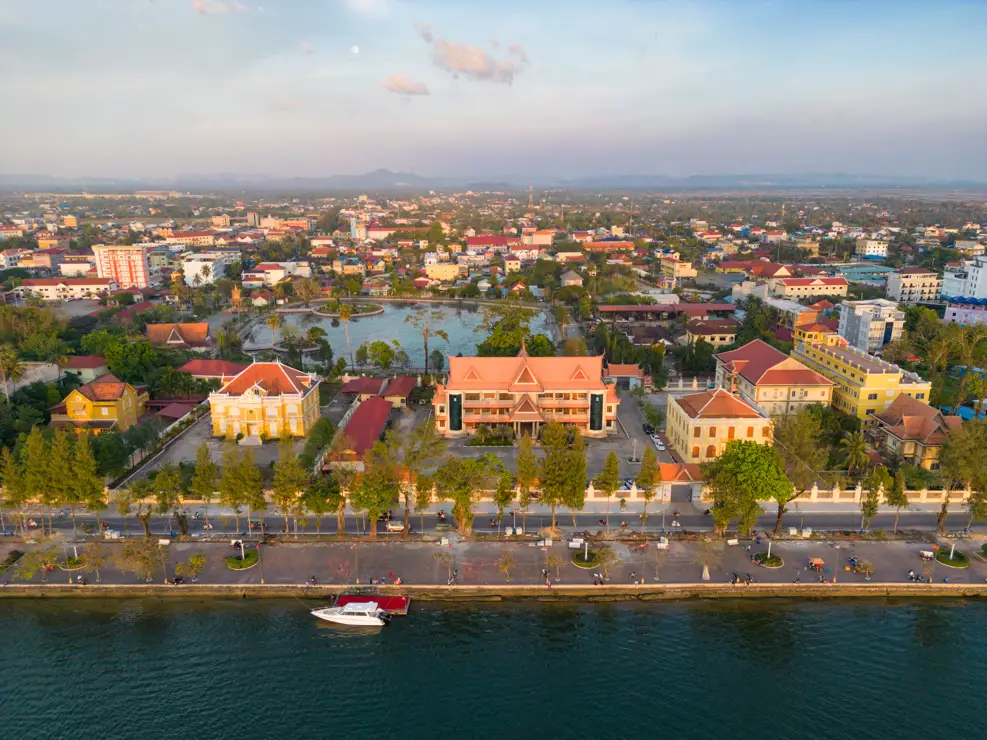
Kampot river side.
Explore the caves
The karst landscapes around Kampot are rich in caves, some of which are worth a special visit.
Phnom Kbal Romeas Cave (Google Maps, Maps. me) is the most accessible in the city. You can explore it independently or rely on the local guides you find at the entrance. Climbing is also possible. The guys at the entrance have all the appropriate equipment. Free.
Phnom Chhnork Cave (Google Maps, Maps. me) is a little further away, and the last stretch of the road is extremely bumpy. Inside is a brick Hindu temple dedicated to Shiva that was built in the 7th century. A flight of steps quickly explores this part of the cave, but you can go into the inner chambers if you wish. I went down on my own but turned back at some point. Local guides offer a “full tour.” Admission costs 5,000 reals.
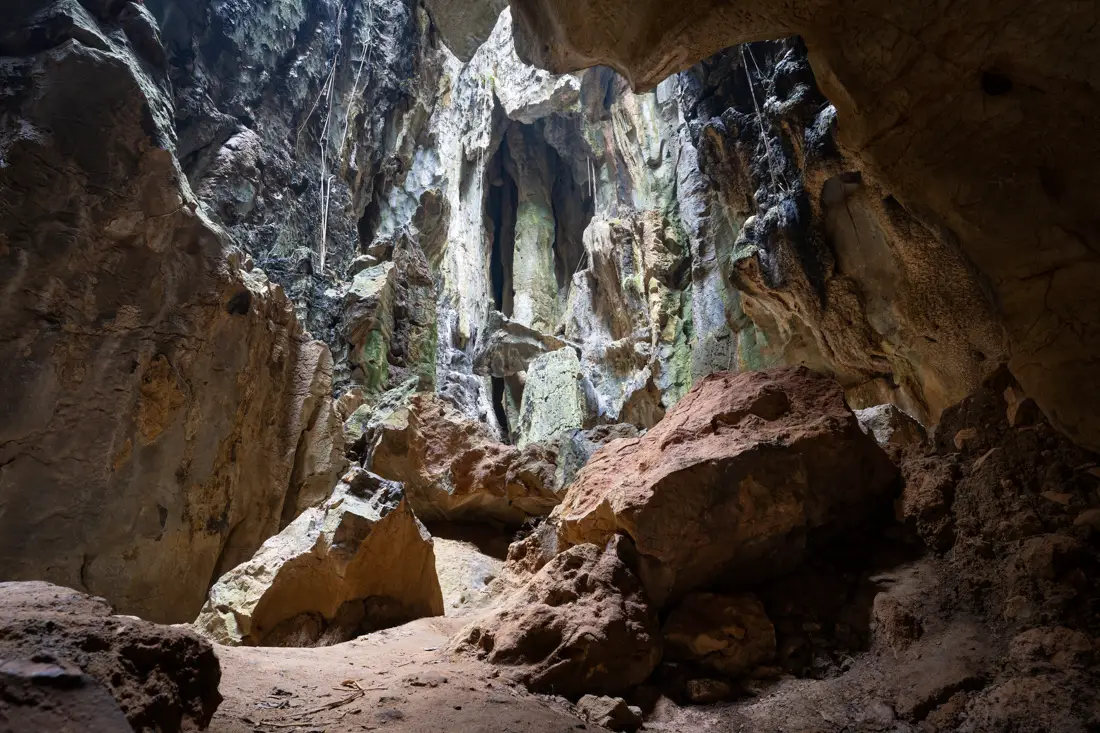
Phnom Kbal Romeas.
Phnom Sorsia Cave (Google Maps, Maps. me) is part of a small Buddhist complex with a temple and stupa. There are two caves you can easily explore, but as usual, local guides are willing to be your guide. Free.
Water Pond Cave or Kampong Trach Water Cave (Google Maps, Maps. me) is about an hour’s drive from Kampot. At the base of the mountain, a small natural pool inside the cave is not inviting. What is worthwhile are the views from the top of the steep stairs that lead inside another cave where there is also a stupa. That said, I don’t think it’s worth the hour-long drive.
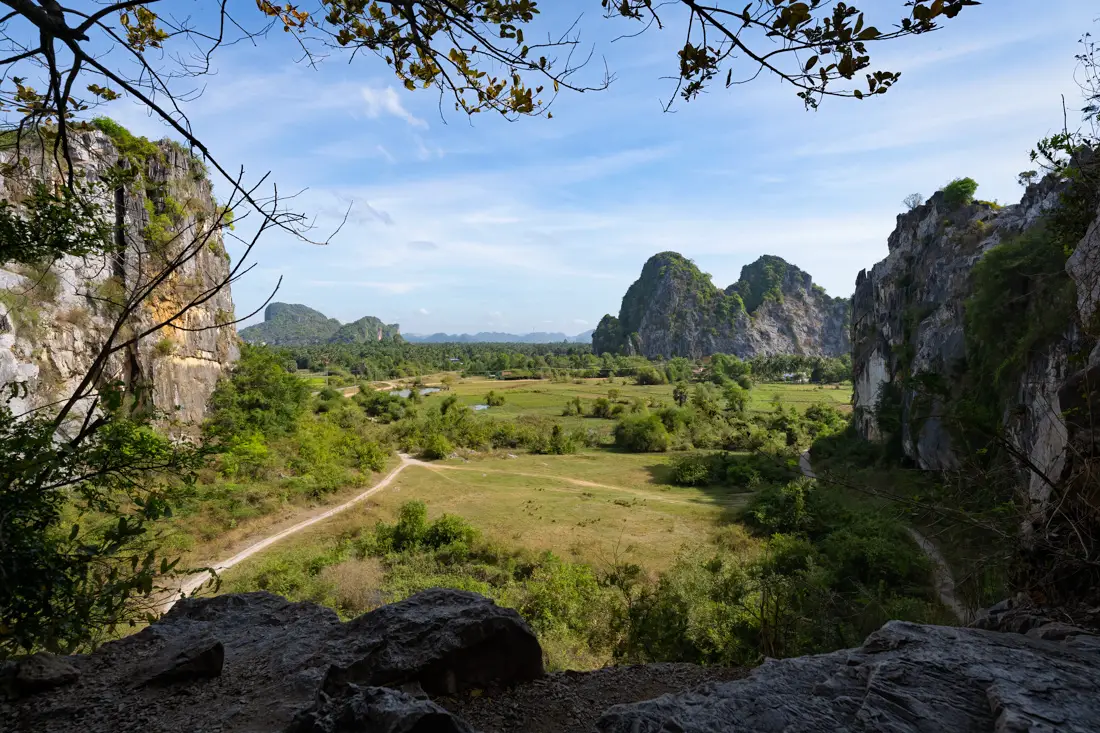
The cave at the top.
What I recommend doing within a day is visiting Phnom Kbal Romeas, Phnom Chhnork, and then continuing to Brateak Krola Lake, often called “Secret Lake.” It is nothing much, but I think it is an excellent place to have lunch and take a break. I stopped at Lake Restaurant before continuing to pepper plantations and, finally, Phnom Sorsia Cave. If you want a less dense itinerary, skip one between Phnom Chhnork and Phnom Sorsia.
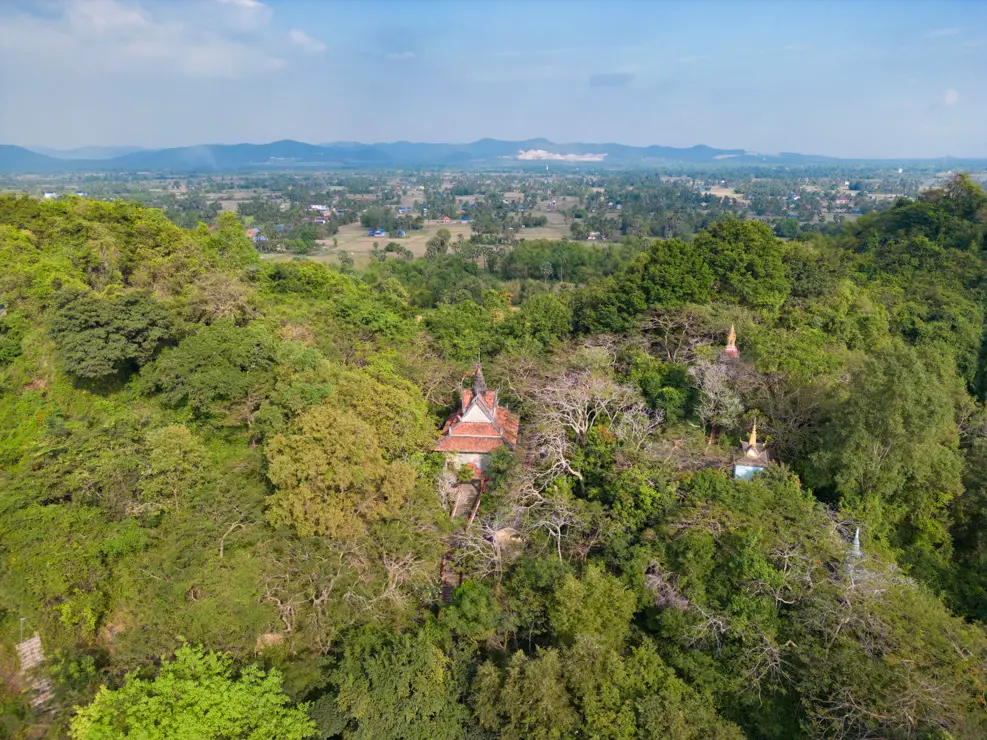
Phnom Sorsia.
Pepper plantation tour
Pepper has been grown around Kampot for hundreds of years, but it is not just any pepper; many chefs claim it is the best in the world.
Many plantations in the area offer guided tours to the plantations. I have been to La Plantation (Google Maps, Maps. me) and recommend it. They offer free tours in both English and French, complete with included tasting and a small snack. The whole thing takes about an hour, and the tours seem to start frequently. I waited about half an hour. The on-site restaurant was slightly expensive for my taste but had good reviews.
Salt Flats
There are a lot of Salt Flats around Kampot; for convenience, I recommend visiting the ones south of the city as they are the most accessible. I drove toward this spot (Google Maps, Maps. me) but stopped first when I felt the view was pretty enough. Sunset is undoubtedly the best time!
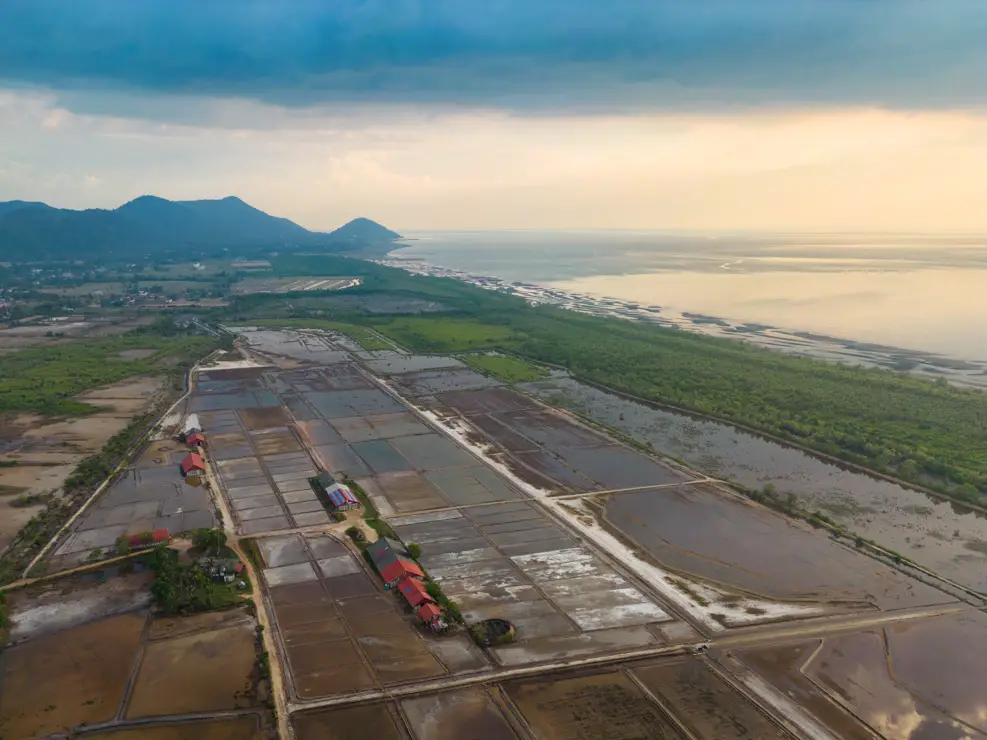
Kayaking on the river and the green cathedral
An excellent way to spend a few hours is to rent a kayak and explore the so-called Green Cathedral, a waterway not far from the city whose name comes from the foliage that lines the waterway.
I rented the kayak at Bopha Prey Kampot (Google Maps), a guesthouse at the canal entrance, so the location is convenient. They wanted $5 but immediately dropped to $3 when I turned my nose up at it. It takes an hour or so to complete the circuit, and the route is almost always obvious, but when in doubt, you can always use maps. Me. You can always paddle back up the river if you haven’t had enough paddling.
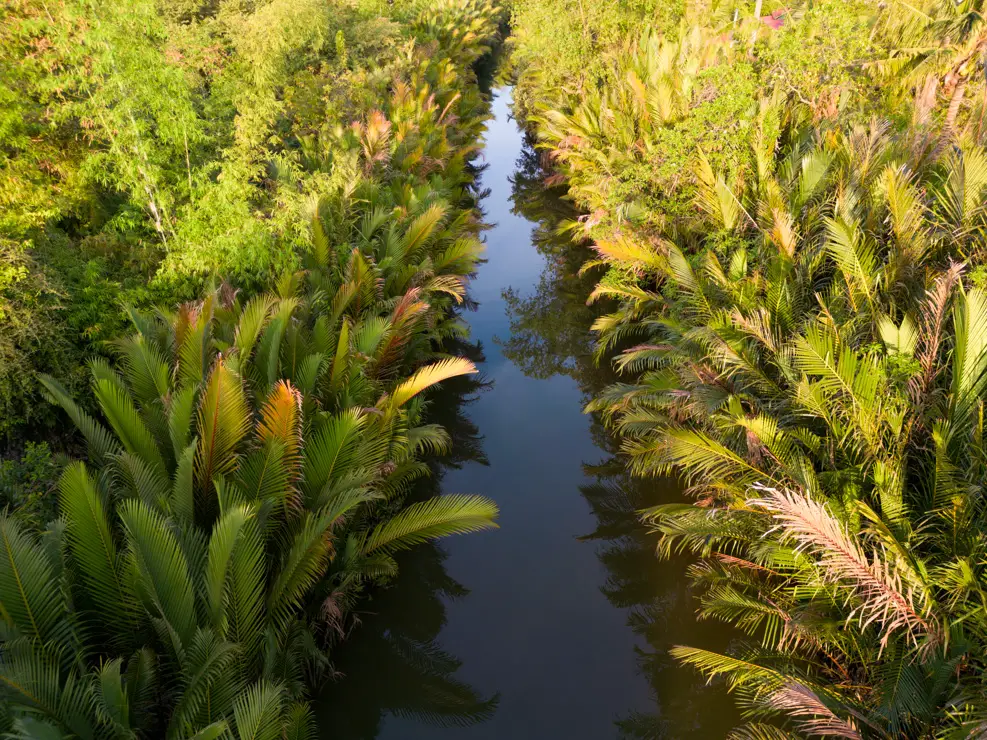
Green Cathedral.
Bokor National Park
Exploring Bokor National Park on a scooter is a great way to spend a day in Kampot. The journey will take you over 1000 meters above sea level to the national park’s top. The road is nice and in excellent condition. There are some lovely views, and you will likely see several monkeys. Given the altitude, I recommend putting a sweatshirt in your backpack; the air can get chilly.
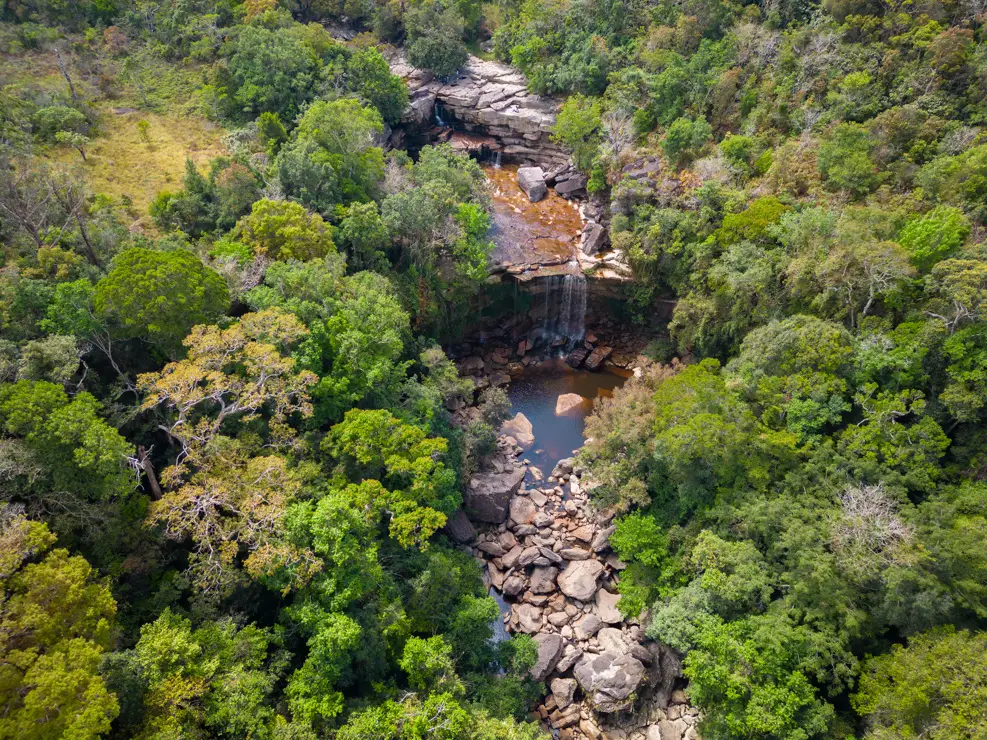
Popokvil Waterfall.
Before arriving at the summit, I recommend stopping at the Lok Yeay Mao Statue (Google Maps, Maps. me); on the other side of the road is the Black Palace (Google Maps, Maps. me); instead, it is entirely in ruins but was once the summer palace of King Sihanouk. On the actual summit, I recommend taking a tour of Le Bokor Palace (Google Maps, Maps. me), a luxury hotel built in 1925 as a summer retreat for French settlers in Cambodia that was renovated and reopened in 2018. The Catholic Church (Google Maps, Maps. me) built in 1919 by Catholic missionary Father Bernard, and the Buddhist temple Wat Sampov Pram (Google Maps, Maps. me) offers extraordinary views of the coast below, including the Vietnamese island of Phu Quoc, haze permitting. Finally, you might visit the Popokvil Waterfall (Google Maps, Maps. me) before heading back downstream. Admission costs 2,000 reals and includes a bottle of water. Keep in mind that it was practically dry in late January.
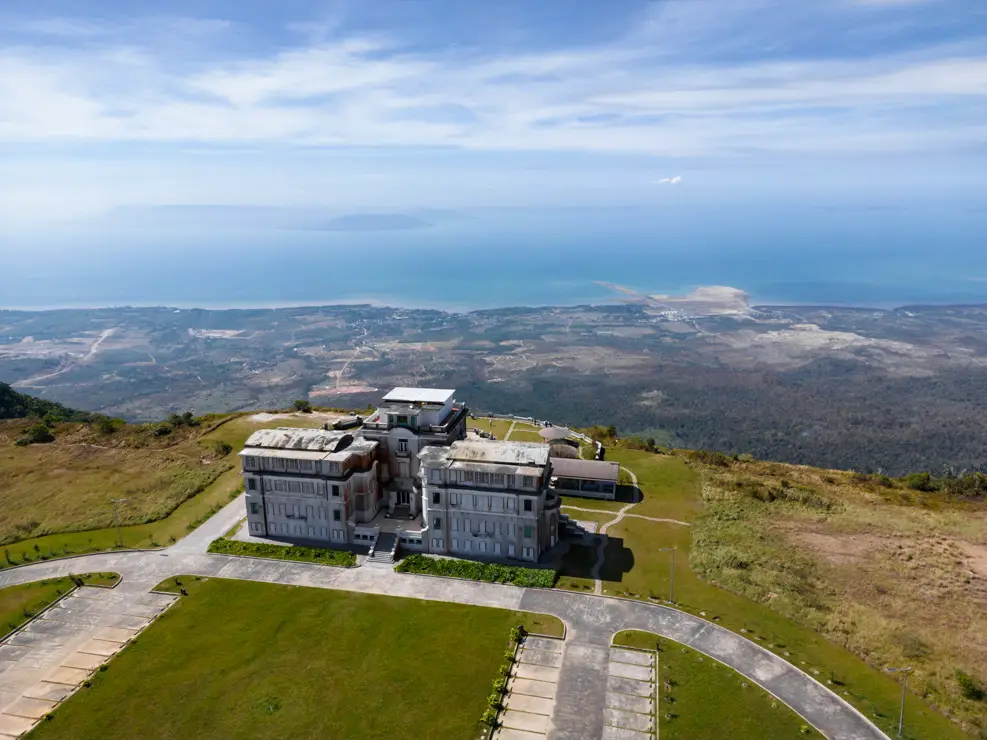
Le Bokor Palace.
The Waterfall Veal Pouch
The Veal Pouch waterfall (Google Maps, Maps. me) is beautiful and is at the end of a short walk of about half an hour. I left the scooter in a hotel parking lot for free by asking permission, and the “public” options asked for 2000 reals. Unfortunately, at least during my visit, the amount of garbage along the route was fascinating, but I hope the situation will improve.
The road leading to the beginning of the trail is not in good condition, but if you have some experience with a scooter, you should have no problems. If possible, avoid the middle hours of the day as it can be crowded, and remember that there may be very little water in the late dry season.
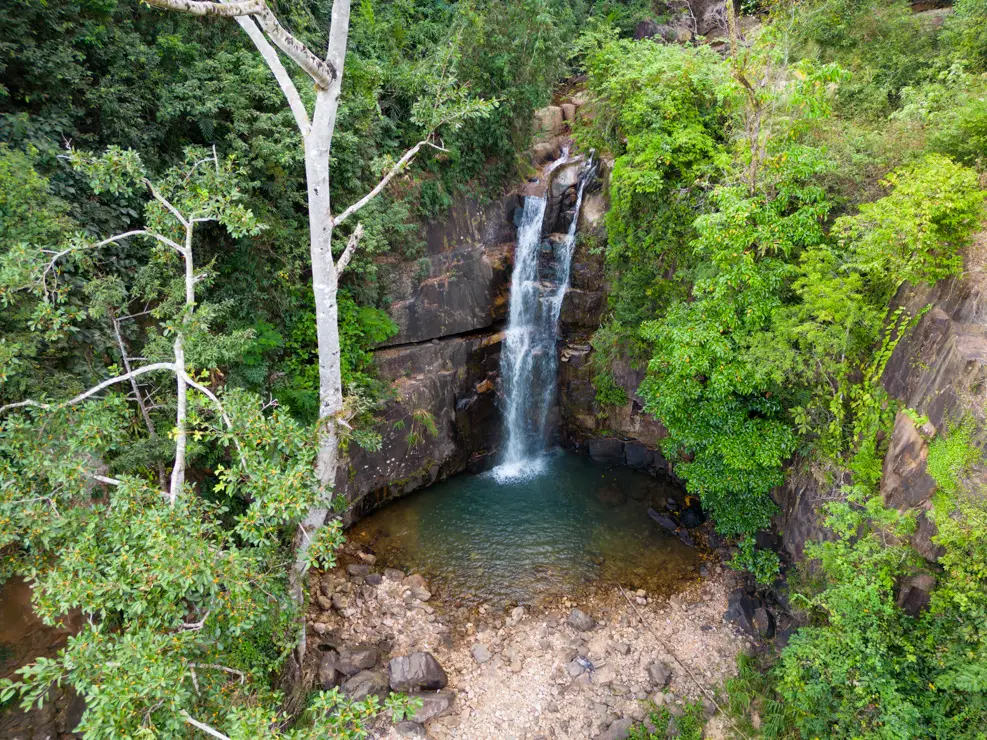
Veal Pouch waterfall.
Kep
Kep’s number one attraction is its famous crab market (Google Maps, Maps. me). The dish to try is undoubtedly crab seasoned with Kampot pepper.
Many travellers, myself included, just visit the market, but if you want, you could also explore the small national park on the edge of town. Admission costs $1, and you can complete a circuit of about 10 km, which is described in detail on this page. According to the reviews, it doesn’t look exceptional and is not well preserved, but it can still be an excellent way to spend half a day.
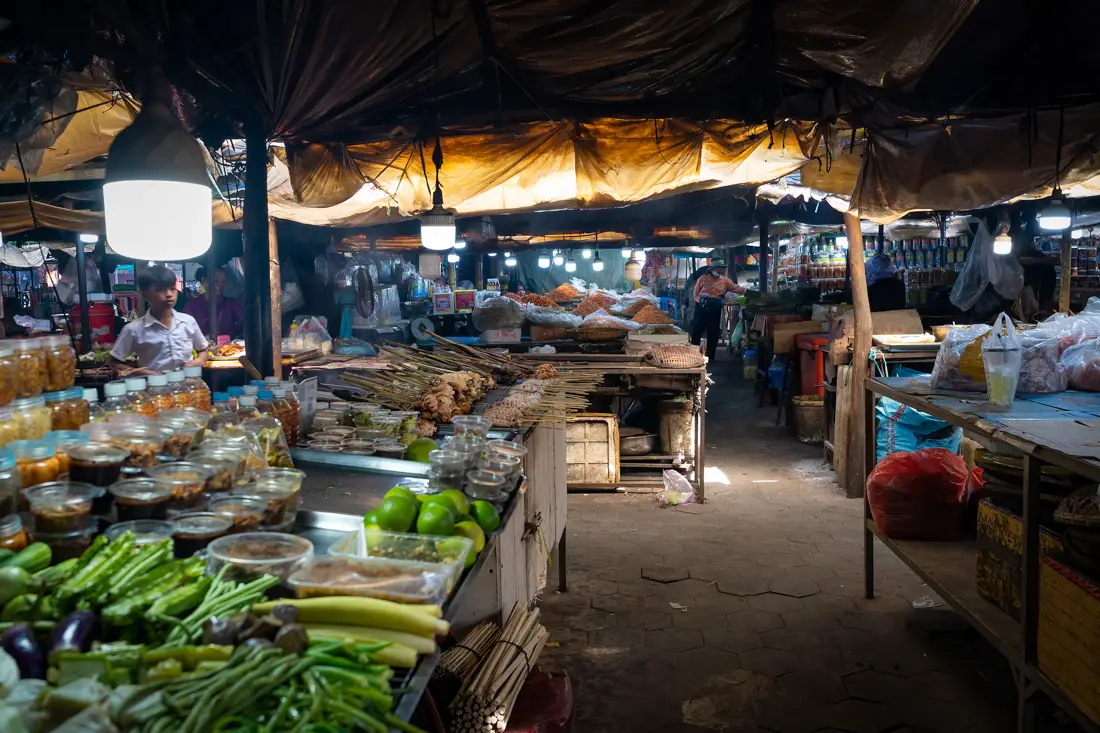
Kep market.
River cruise
River cruises are offered just about everywhere. I have not participated, but it could be an excellent way to spend a few hours, especially at sunset. Some options include a few drinks and dinner.
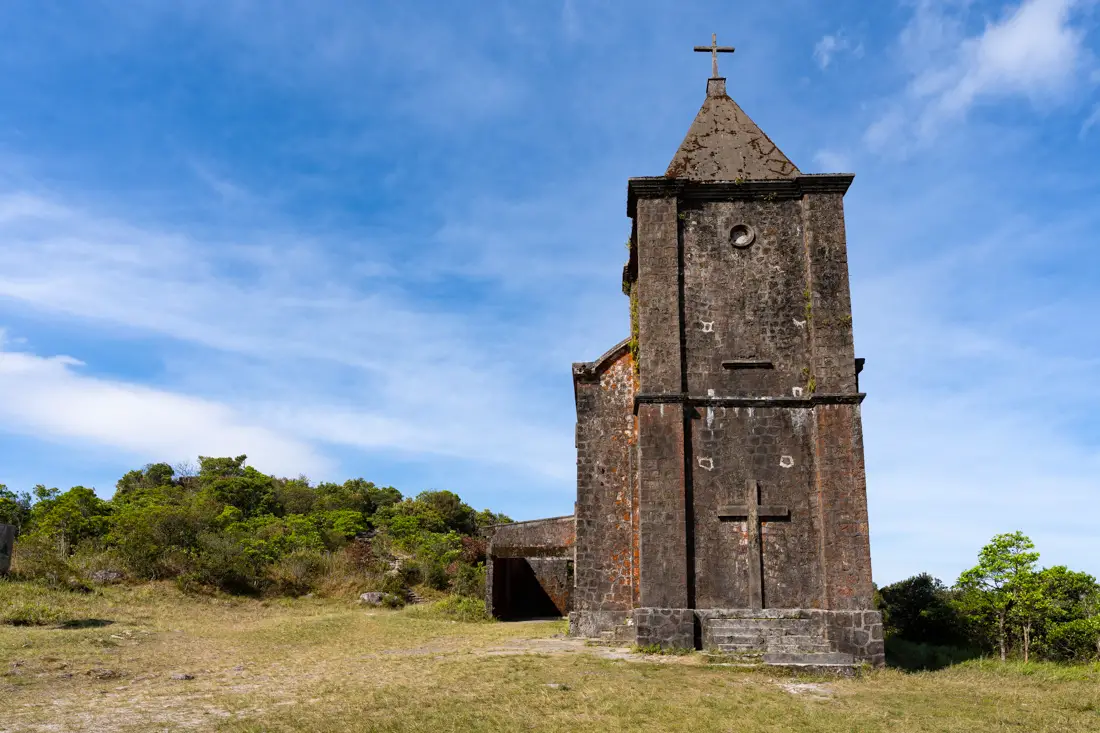
The Catholic church within Bokor National Park.
Where to eat in Kampot?
Nom Tom Bakery (Google Maps, Maps. me) is a street bakery/bakery run by a Belgian girl. They are the best-baked goods I have ever had in Southeast Asia. Recommended. If possible, try to go early in the morning when all the options are available.
Drop by Ciao (Google Maps, Maps. me) if you miss good Italian food. Homemade pasta, pizza and lots of hospitality.
Where to sleep in Kampot?
Also, in Kampot, I chose to sleep at Onederz Kampot, and as always, it did not disappoint. Another popular option that is often recommended is Monkey Republic Kampot.
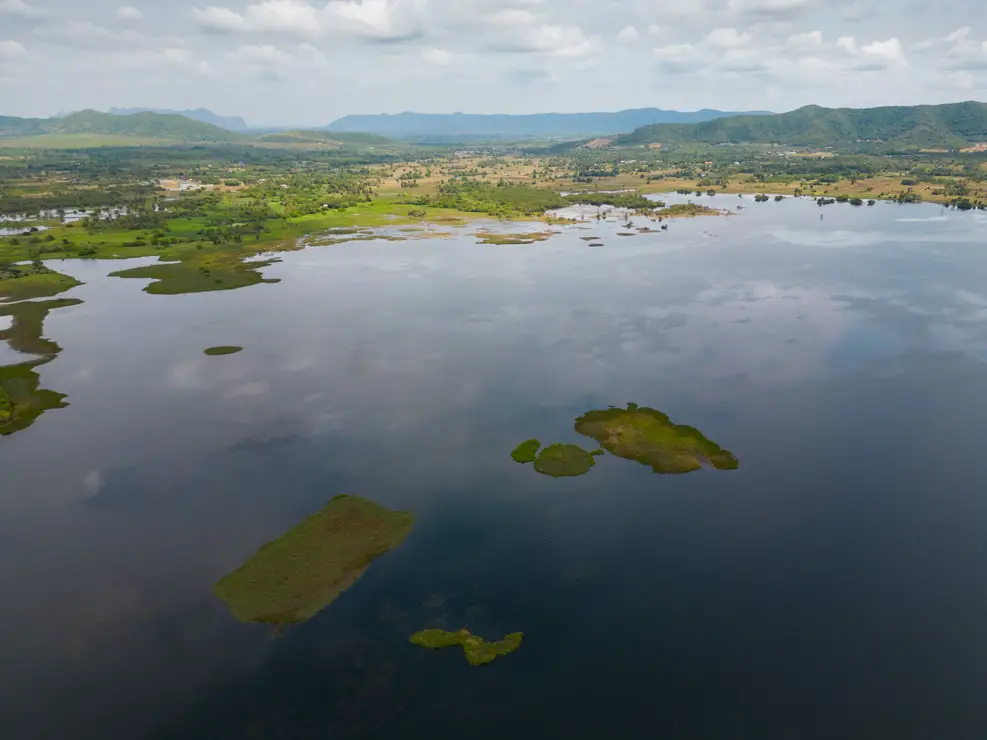
Lake Brateak Krola aka“Secret Lake”.
How to reach Kampot?
Kampot is well connected to the rest of the country. There are frequent buses to and from Phnom Penh and Sihanoukville; a slower train can also cover these routes. If desired, there are night buses to Siem Reap. You can check out sites like 12go and Bookaway to understand the various options.
To and from Vietnam, there should be direct connections to Ho Chi Minh, but if not, you can simply take a bus to Ha Tien (the border town) and then board the first bus to Kampot. A detailed article can be found on this page. From Ha Tien, you can take the ferry to Phu Quoc Island.
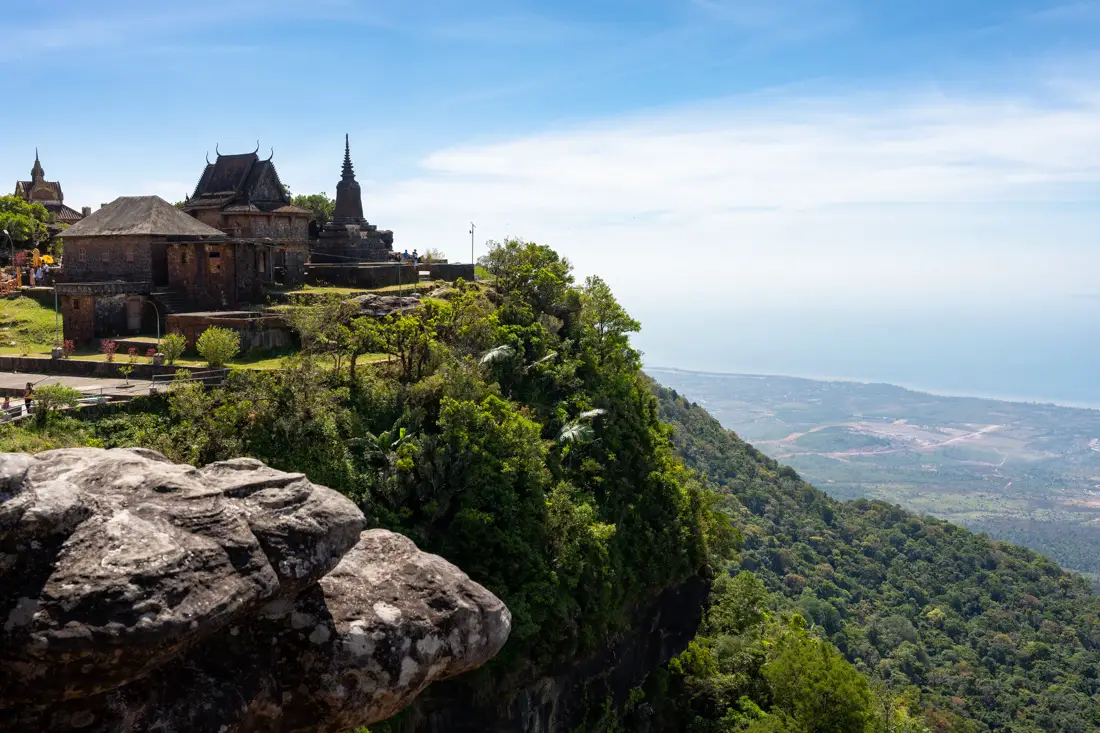
Wat Sampov Pram.
Kratie
This quiet town along the Mekong River is an excellent stop to break up the trip to other destinations in Cambodia, especially if you are coming from Laos and other destinations such as Banlung and Saen Monorom.
What to do and see in Kratie
The town has a few ruined colonial buildings, but there is nothing special to see. However, there are some exciting attractions nearby, especially the Irrawaddy dolphins.
Irrawaddy Dolphins
The Asian orcella or Irrawaddy dolphin is an endangered animal; there are less than 300 in the world, and some of them have made the stretch of river north of Kratie their home. They are timid animals, so you will likely see them in passing unless you are fortunate. However, I still think it is a good experience, particularly if you join the kayak tour offered during the dry season. This is a half-day tour that can be done either in the morning or the afternoon: you go down the Mekong for a couple of hours, take a snack break on one of the many islands that form during the dry season, and end the tour in the area where the dolphins live.
The most popular company offering the tour is Sorya Kayaking Adventures, which also runs a lovely, inexpensive guesthouse. I, however, took the tour with Dolphin Kayaking Adventures. They will take you as your first stop to a restaurant run by an Australian lady; here, you will find Lucky, a local guy who organizes the tour, which will turn out to be such and such as the one offered by Sorya. You can view the program, and there are various prices based on the number of people; I paid $23. Just contact him via WhatsApp/telegram to arrange it.
As an alternative to the kayak tour, one can take a tuk-tuk to where the dolphins are (Google Maps, Maps. me). Here, you can spend an hour in the boat watching the dolphins, $10 per person for 1-2 people, $8 for three or more.
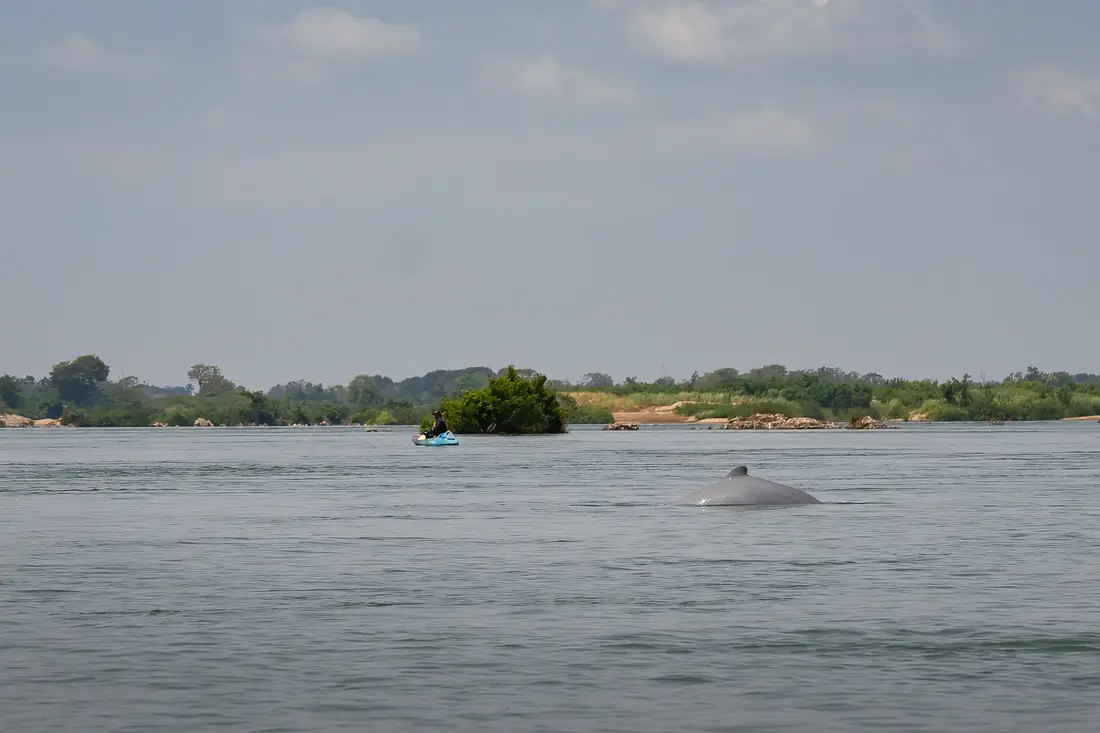
My best shot..
Koh Trong Island
Koh Trong is a quiet island located relative to the town of Kratie on the other side of the Mekong River. Known locally as the “market garden” of Kratie, Koh Trong Island offers a window into rural Cambodia and a relaxed atmosphere. The island is easily accessible and is only a five-minute ferry ride from Kratie town. The pier where you can catch the ferry is here (Google Maps, Maps. me). The cost is 1,000 reals. Officially, there are schedules, but they are very flexible. I took the ferry around 3:00 p.m.; it was supposed to return at 6:00 p.m., but we left at 7:00 p.m. Once you arrive at your destination, you can rent a bicycle for 8000 reals and ride around the island. I recommend stopping at this small bar (Google Maps, Maps. me), the perfect place to sip a coconut overlooking the Mekong.
Here i ended my visit to Kratie and the surrounding area, but there are other attractions you could visit, especially if you decide to rent a scooter.

Koh Trong island.
Kampi River Rapids
The Kampi rapids (Google Maps, Maps. me) are a popular spot with locals, especially on weekends. It doesn’t look exceptional, but it’s an option to spend a few hours relaxing and escaping the heat by lazing in a hammock.
Sambor
Sambor is located 35 km north of downtown Kratie. The Wat Sarsar Mouy Roy temple (Google Maps, Maps. me) is commonly known as the “100 Pillars Pagoda.” Built in the 16th century and destroyed by Pol Pot’s regime in the 1970s, it was rebuilt in the late 1990s with 116 pillars. Only three pillars of the original building are displayed in the pagoda.
Sambok Mountain
Twelve kilometres from the centre of Kratie is Mount Sambok (Google Maps, Maps. me), 93 meters high, at the end of 400 steps, is a Buddhist meditation centre and pagoda that offers excellent views of the Mekong River. It seems to be especially popular at sunset.

Mekong flooded forest.
Where to sleep in Kratie?
I slept at Sorya Guesthouse, and although there are cheaper options, I recommend it. Dormitory with single beds and a lovely terrace overlooking the Mekong. A more affordable alternative is Silver Dolphin Guesthouse & Restaurant, and if you book early, Nomad Guesthouse has cheap single rooms.
How to reach Kratie?
Direct bus connections are from Siem Reap, Phnom Penh, Stung Treng, and Banlung. Vireak Buntham should cover all these routes, but cheaper local minivans can also be booked through guesthouses. I, for one, took one of these minivans from Banlung.
If you want, you can get to Kratie relatively quickly from Laos. Many travellers arrive from the 4000 islands; from here, minivans are heading to the border; once you cross, more minivans are heading to Stung Treng and Kratie.

Snack break.
Stung Treng
Stung Treng is located on the Sesan River near the confluence with the Mekong River. It is a famous stopover town for travellers heading to Laos in the north, Ratanakiri in the east, and Mondulkiri and Kratie in the south.
What to do and see in Stung Treng
I have not personally been to Stung Treng, and in general, as just discussed, it is a transit town, but if you decide to stop by, you will find some pointers on activities to do in this article.
Where to sleep in Stung Treng?
The only option online seems to be the Savet Guesthouse.
How to reach Stung Treng?
There are direct connections to Phnom Penh, Kratie, Siem Reap, Banlung, and Saen Monorom. Virak Buntham covers all these routes, but there are also cheaper local minivans, making local information more accessible. As anticipated, there are also minivans to and from the Lao border.
Banlung (Ratanakiri)
Ratanakiri is a province in northeastern Cambodia. It is known for its natural beauty and ethnic diversity. Ratanakiri means “Gem Mountains” in the Khmer language. Banlung is the capital of the province.
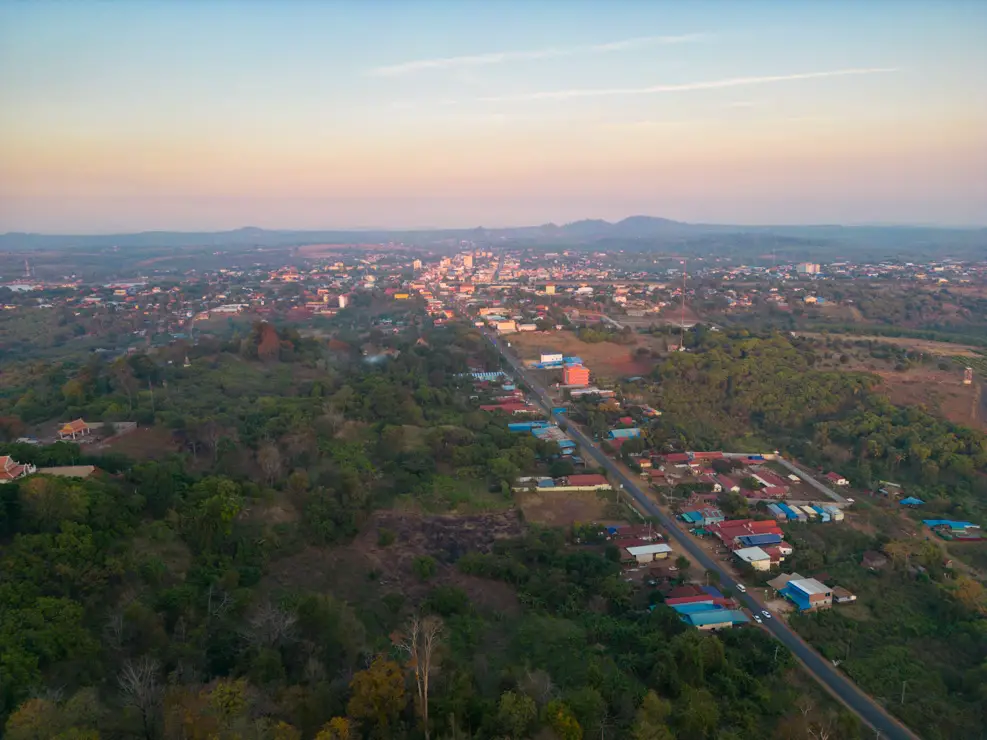
Ratanakiri.
What to do and see in Banlung (Ratanakiri)
Yeak Laom Volcanic Lake
Yeak Laom (Google Maps, Maps. me) is a crater lake formed by a volcanic eruption 4,000 years ago. It has a diameter of about 700 meters and a depth of 48 meters. The shore of Lake Yeak forms an almost perfect circle and is an ideal place for a refreshing swim within walking distance of the city. Plenty of platforms to dive on, tables, and hammocks to relax. Admission costs $2.
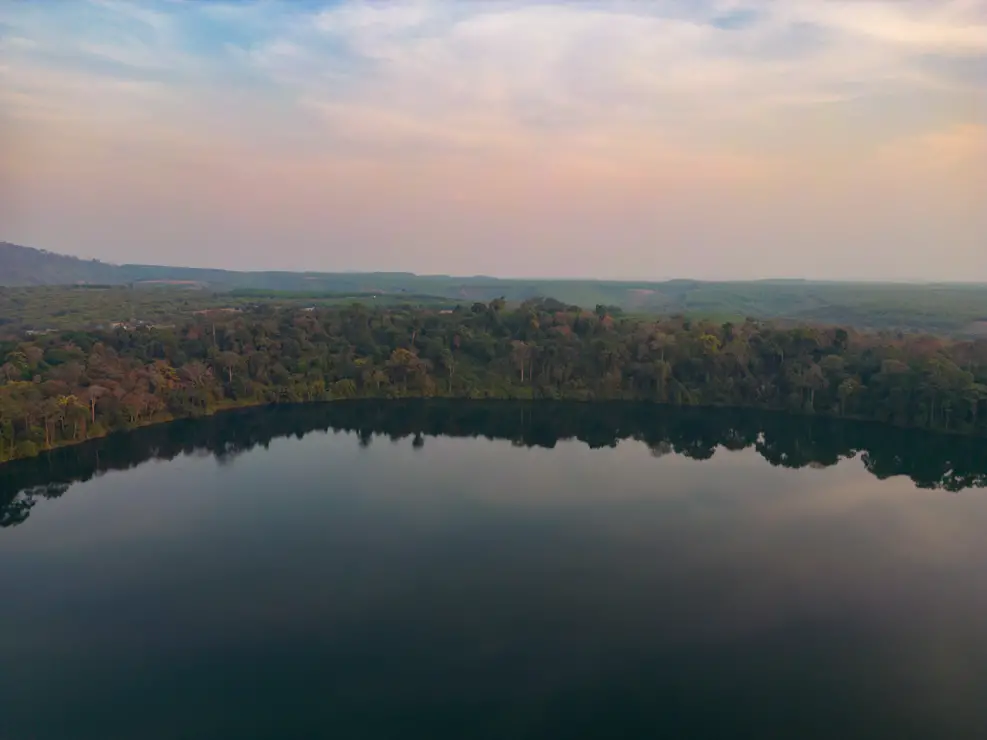
Yeak Laom lake.
Jungle Trek
Banlung is an ideal place to organize treks within Virachey National Park. For groups of 4 people or more, $30 per day seems to be the standard price. I arranged the trek directly to the guesthouse (Family house & trek) with some other guests, opting for something not too challenging.
The guesthouse provided hammocks and sleeping bags, and we spent the night not too far from civilization after walking for a few hours through the countryside first and the forest. On the second day, we stayed at a lovely waterfall and visited a local village before returning to Banlung.
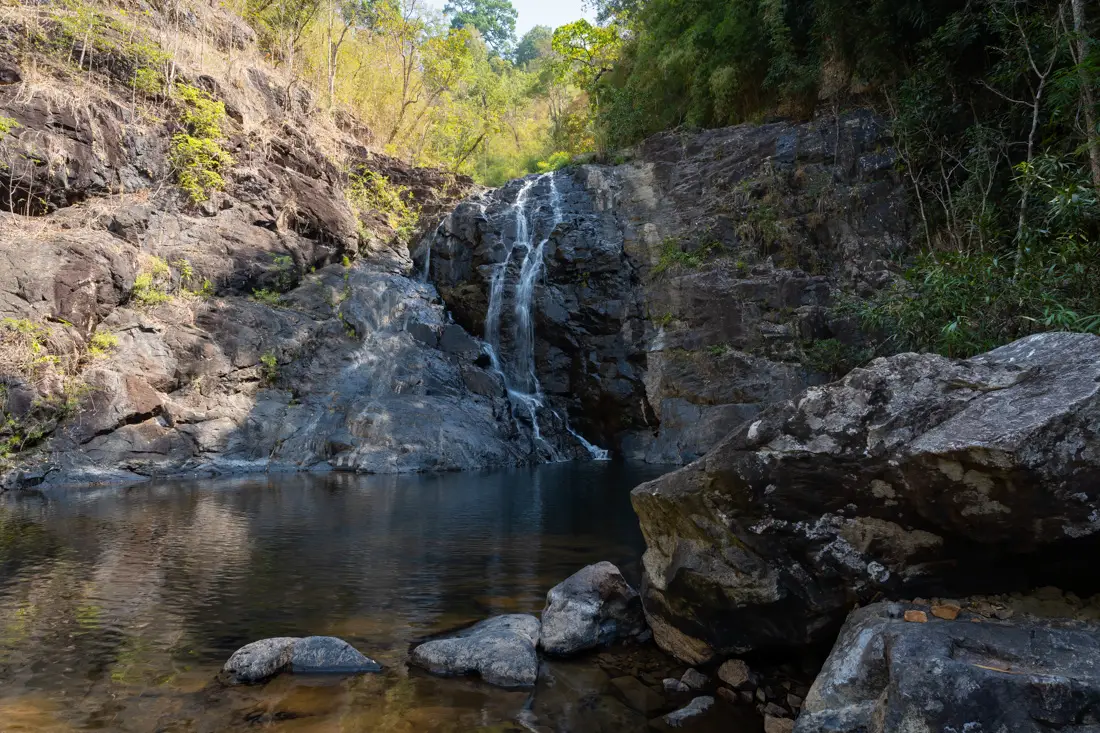
Waterfall we visited during the trek.
Two enjoyable days, but if you are looking for an authentic jungle experience, I recommend treks beyond the two days that take you further into the national park, where the chance of seeing animals is significantly increased. We didn’t see anything exciting.
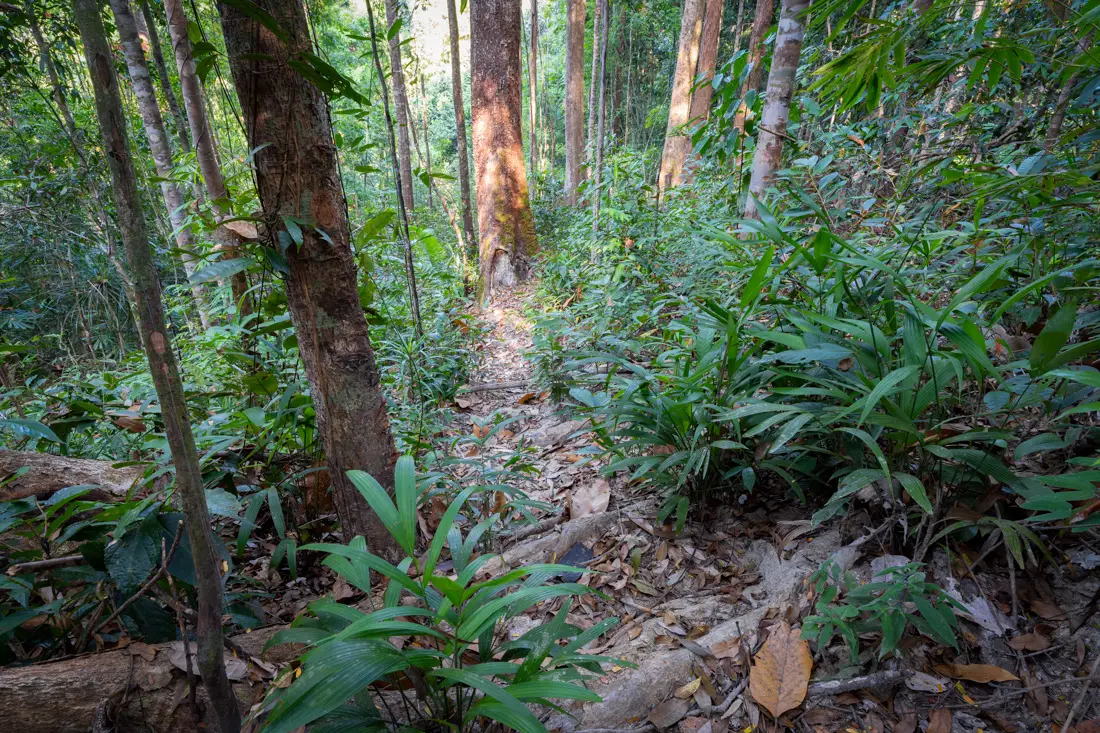
Along the trails of Virachey National Park.
Phnom Svay Mountain
The mountain (Google Maps, Maps. me) is just outside town. On the top is a giant Buddha statue with a spectacular view of the surrounding countryside. I recommend climbing it at sunset and enjoying the view with the locals. Along the way, there is also a small temple with a statue of the reclining Buddha.
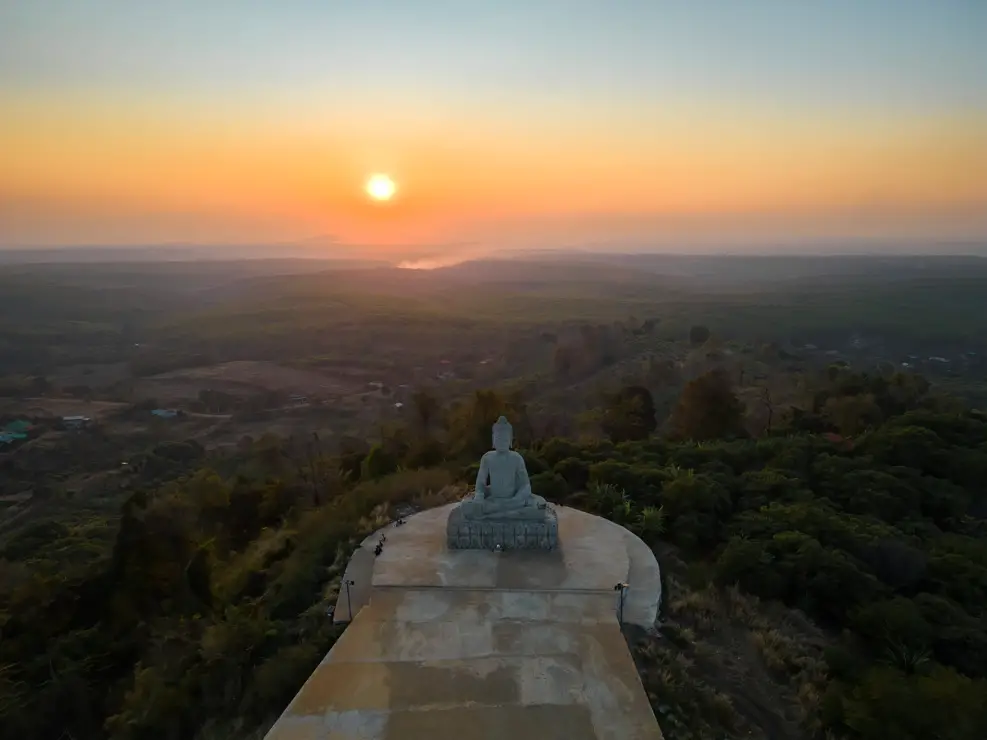
Phnom Svay Mountain.
Waterfalls
There are at least four noteworthy waterfalls around the town. I rented the scooter directly at the guesthouse with one of the guys I trekked with. I think it’s a great way to spend the day. Alternatively, you can arrange the same “tour” by using tuk tuk. The roads are partly unpaved but in good condition.
Cha Ong Waterfall (Google Maps, Maps. me), at 18 meters high, is beautiful, and there is a platform that allows you to go down to the “back” of the waterfall, but you cannot bathe there, at least not at the base. The entrance fee is $1.
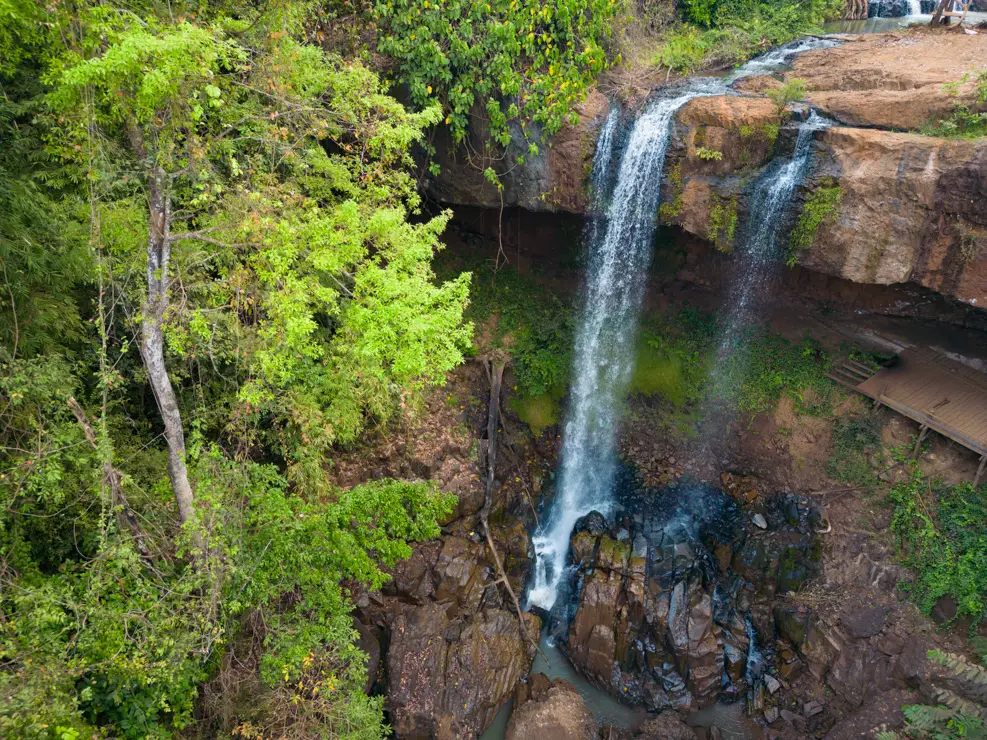
Cha Ong Waterfall.
I believe Kachanh Waterfall (Google Maps, Maps. me) is the most beautiful of the places I have visited. There is a large natural pool at the base of the waterfall for swimming. The entrance fee is $1.
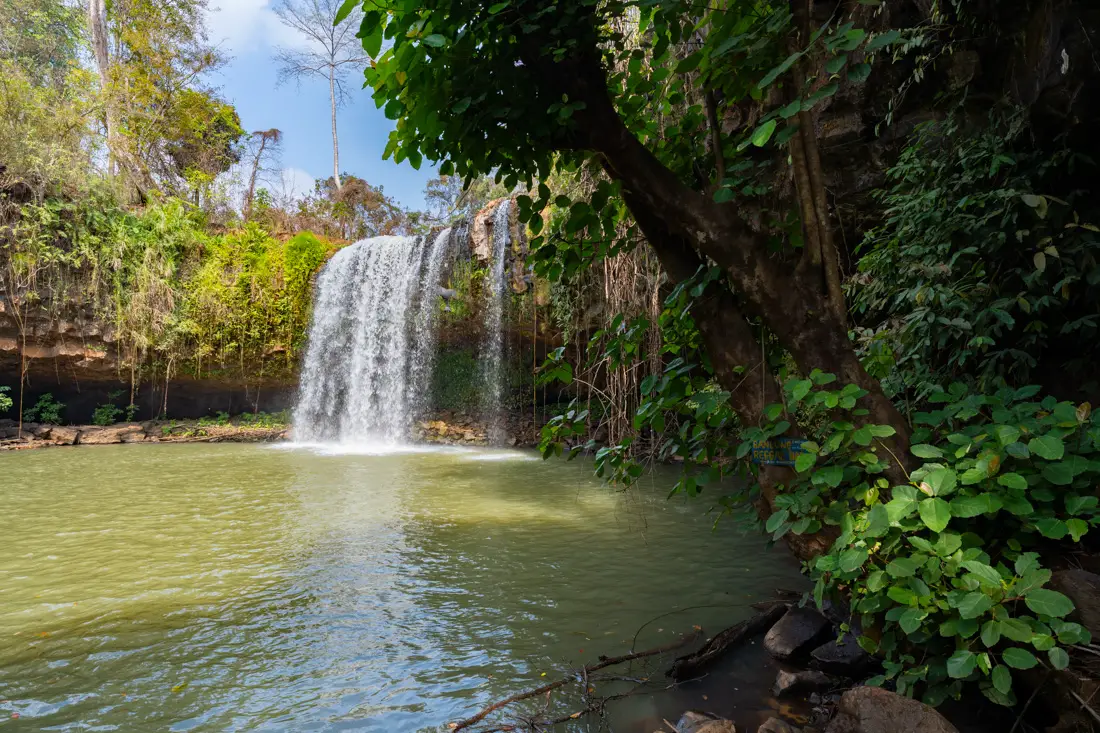
Kachanh waterfall.
Katieng Waterfall (Google Maps, Maps. me) is not far from Kachanh; swimming is also possible here. The entrance fee is $1.
Waterfall 7 Steps (Google Maps, Maps. me) is the farthest from town. It looks nice, but I have not been there because the guesthouse owner told me that the road was not in good condition, and if a local said so, I can’t imagine the situation!
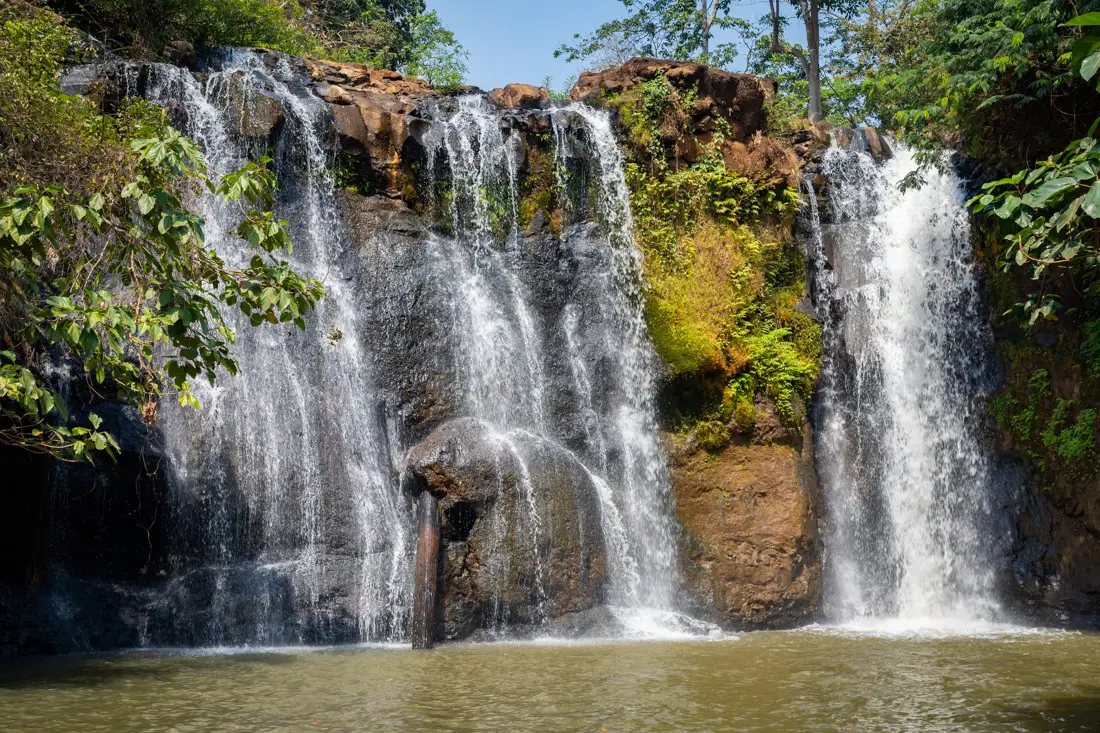
Katieng Waterfall.
Where to sleep in Banlung (Ratanakiri)?
I slept at the Family House & trekking and can only recommend it; it is a modest but clean and cosy environment; the family that runs the guesthouse is lovely. All at a bargain price. Should they be complete, a friend strongly recommended Ratanakiri Homestay & Jungle Trek to me.
How to reach Banlung (Ratanakiri)?
Direct buses are to and from Phnom Penh, Saen Monorom, Stung Treng, and Kratie. You will likely have to change buses/minivans for all other destinations. Again, Vireak Buntham should cover all these routes, but cheaper local buses can also be booked through guesthouses.

Night sky during the trek.
Saen Monorom (Mondulkiri)
If you want to get off the beaten path, northeast Cambodia, mainly Mondulkiri province, is one of Cambodia’s least visited, remote, yet most beautiful areas. Mondulkiri means “Meeting of the Hills,” with an average elevation of 800 meters, temperatures are more pleasant than in the rest of the country. Sen Monorom is the capital of the province.
What to do and see in Sen Monorom
There is not much to see in town. There is a small market next to the bus station. This is the gateway town to Mondulkiri Province, an extraordinary and unique part of Cambodia.
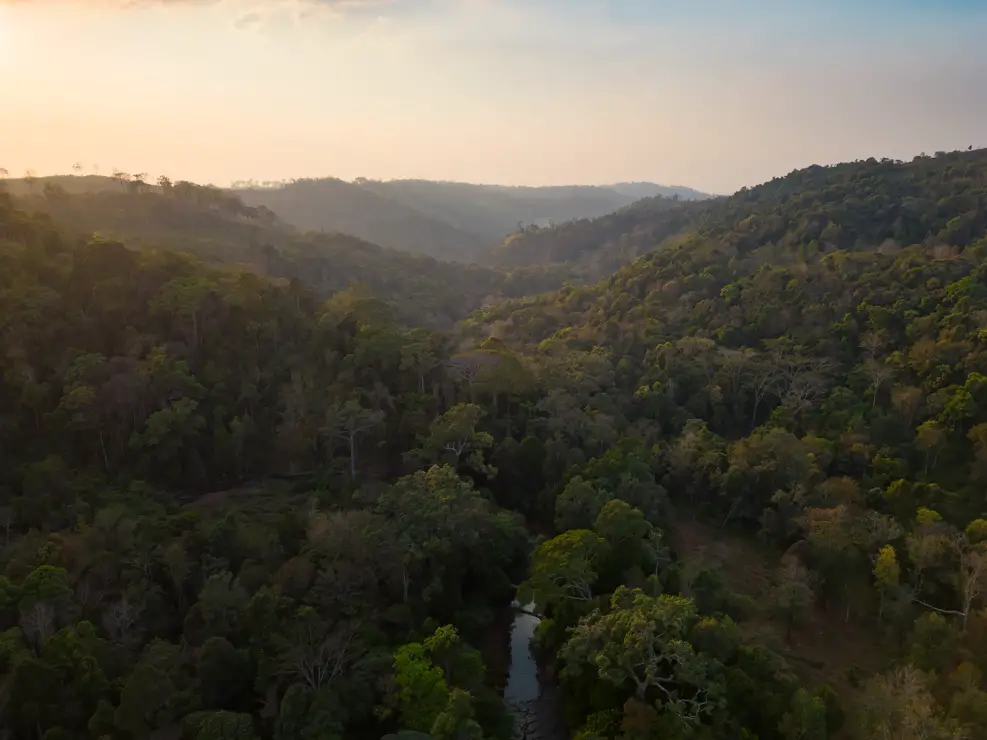
Sunset at the lodge.
Mondulkiri Project
Many people reach Sen Monorom exclusively to participate in the Mondulkiri Project, a protected forest area that offers unique encounters with elephants. Being in close contact with elephants roaming free in their natural habitat is possible. You can feed them, bathe with them and whatnot. They are all animals rescued from terrible captivity situations, and some of them still bear the physical and psychological marks.
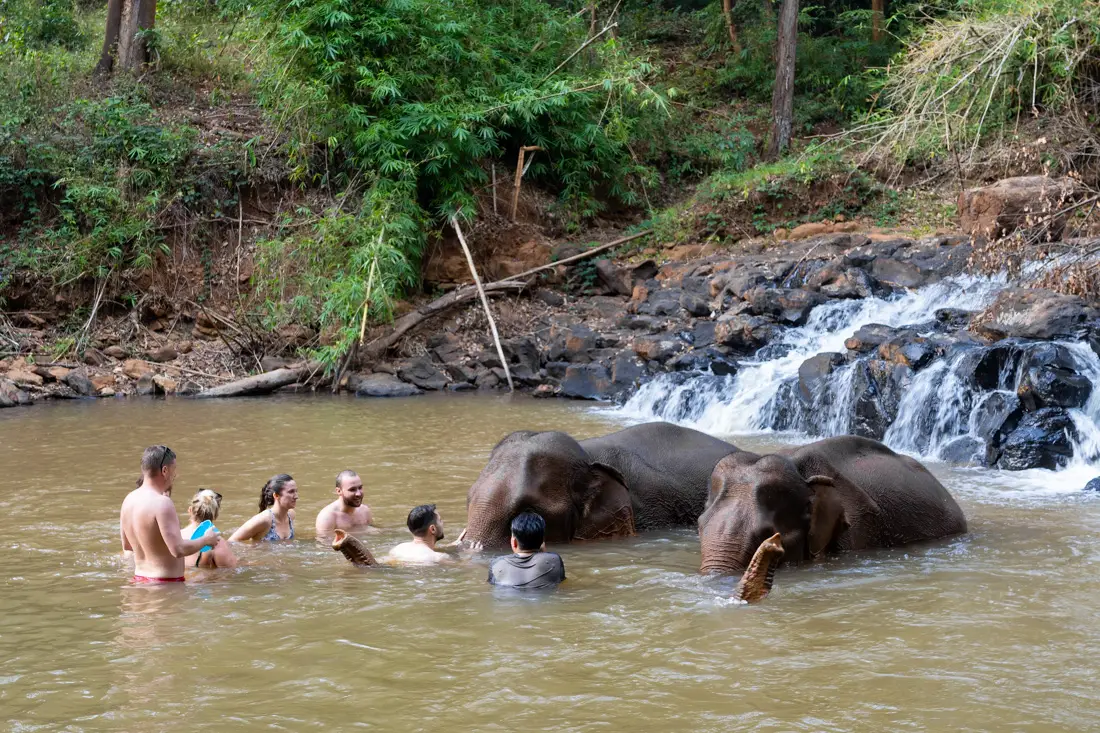
One-day or two-day tours are offered. The one-day tour costs $50 and allows you to spend the whole day with the elephants, while the two-day tour costs $80 and includes a day of trekking during which you visit some waterfalls. At night, you sleep in the lodge that serves as a base for the elephant visit. I did the two-day tour and all in all I recommend it. I know it is sometimes done the other way around, but at least in my case, we spent the first day at the lodge with the elephants together with the people doing the one-day tutor, then in the evening, they left while we slept at the inn, and the following day we started the trek. In any case, you can find all the relevant information on their website.
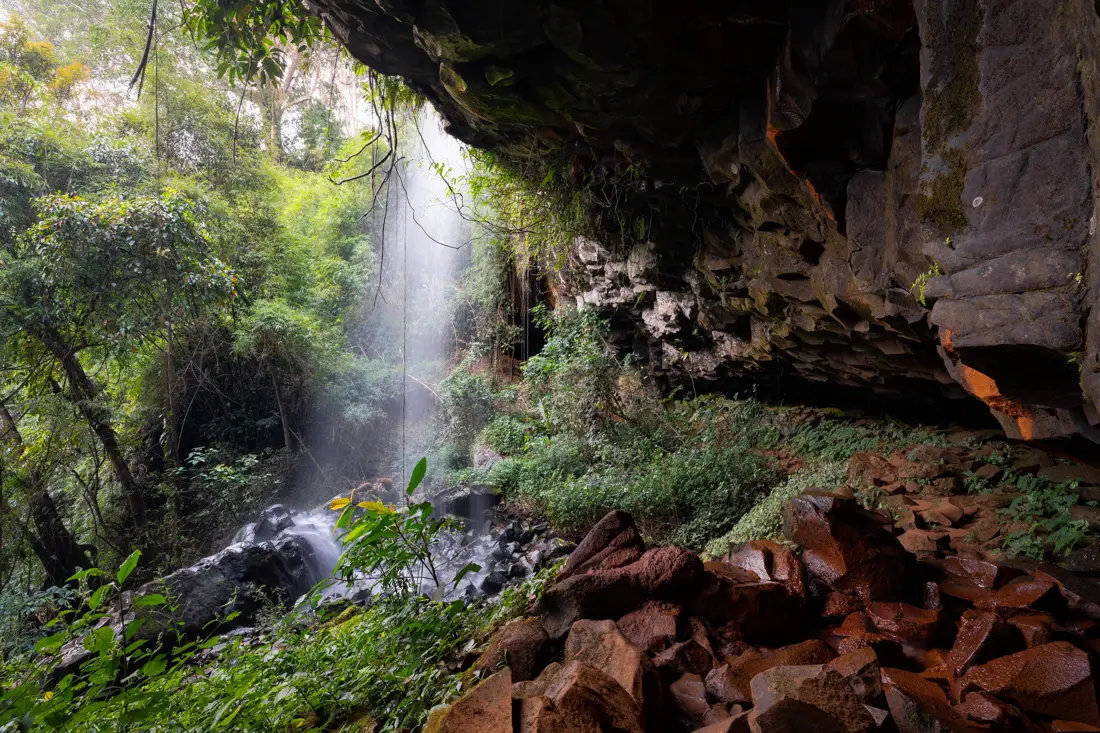
Waterfall along the trek.
A similar project worth taking a look at is the Elephant Valley Project. The tours offered are more expensive, but the accommodations are more excellent than the hammocks provided by the Mondulkiri Project.
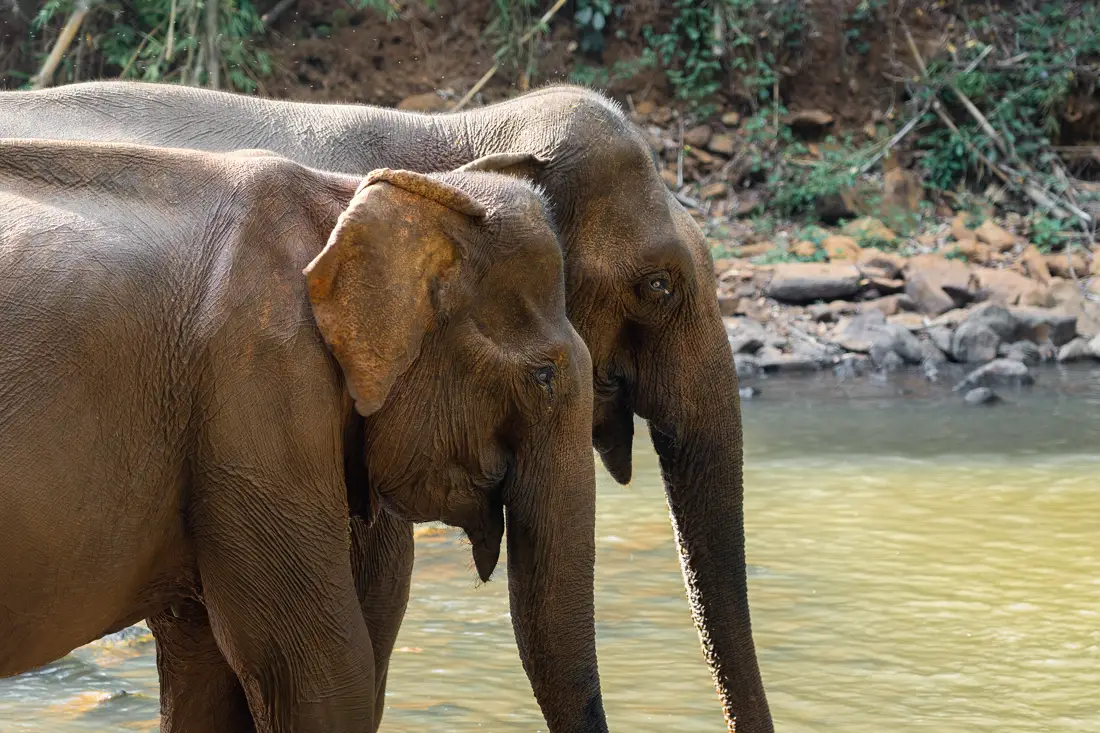
Trekking
Trekking is another popular activity in Sen Monorom. There are many options, ranging from a day tour that often includes a visit to a few waterfalls to multi-day hikes in the forest and ethnic villages. As mentioned, I think the two-day tour with Mondulkiri Project is a good compromise, but if it interests you, there is no shortage of opportunities.
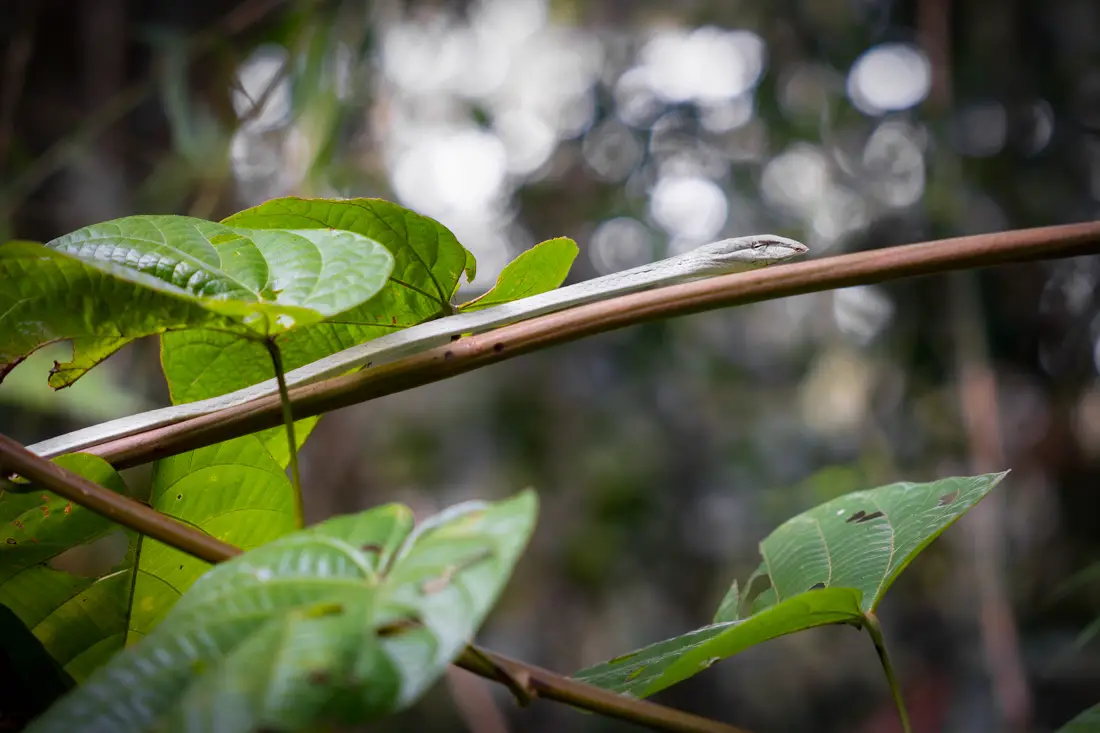
Bousra Waterfall
The Bousra Waterfall (Google Maps, Maps. me) is about a 45-minute drive from Saen Monorom and is one of the largest and most impressive in the country. I was there around early February, and there was still a lot of water. They charge 1000 reals for parking and another 10000 reals for entry. I rented the scooter directly at the guesthouse for $7, likely to cost a little less in town.
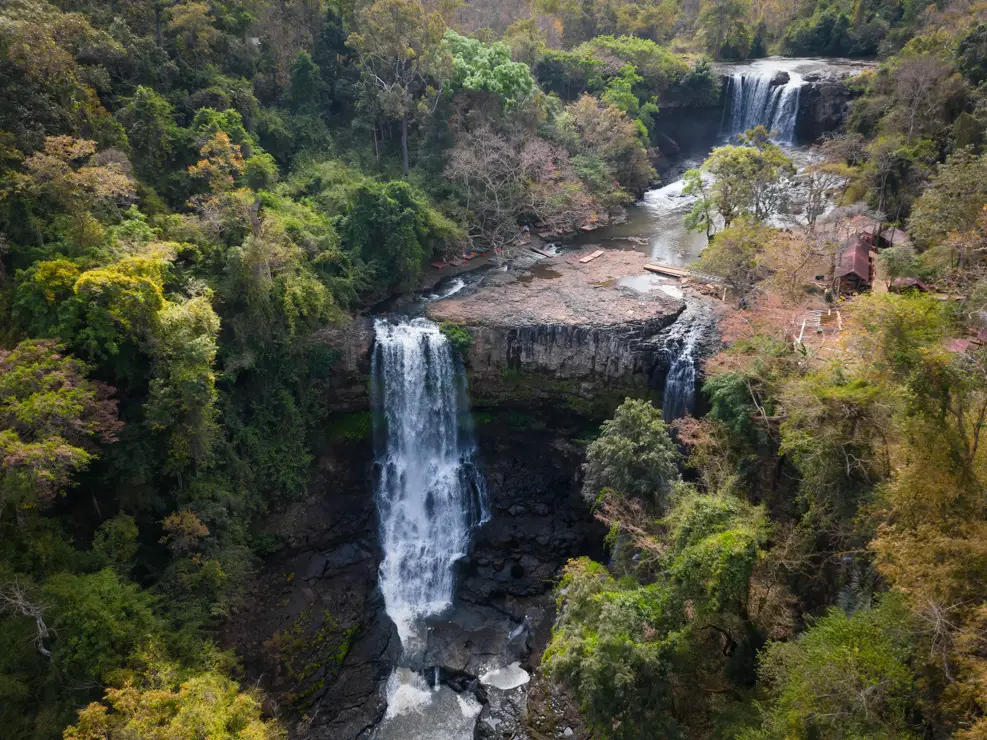
Bousra waterfall.
More waterfalls in and around Sen Monorom
There are dozens of other waterfalls around the city. Some can be reached by scooter, while others require trekking. Below, I list some easily accessible options. The day I rented the scooter, I also went to Chrey Thom (Google Maps, Maps. me). The waterfall is pretty and uncrowded; only a few local guys were there during my visit. The pool at the base of the waterfall is not suitable for swimming.
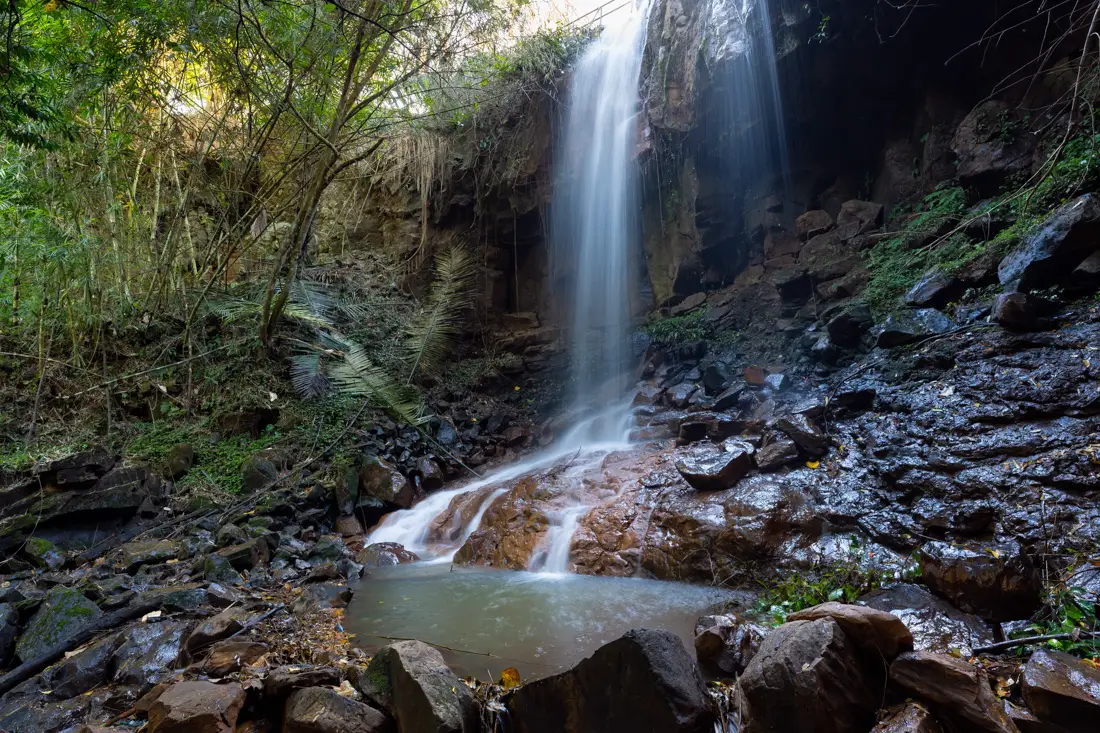
Chrey Thom waterfall.
Leng Khoen Waterfall (Google Maps, Maps. me) and Leng Oung Waterfall are within walking distance. We visited two waterfalls on the second day of the Mondulkiri Project. They seem to be a popular destination even among groups doing day treks from Saen Monorom, but if you want, I think it is also possible to reach them by scooter. The first is a very high and fascinating waterfall, while the second is perfect for swimming.
Sen Monorom waterfall (Google Maps, Maps. me) is the closest to the city. I have not been there, but you might as well walk there. It is not particularly large or impressive.
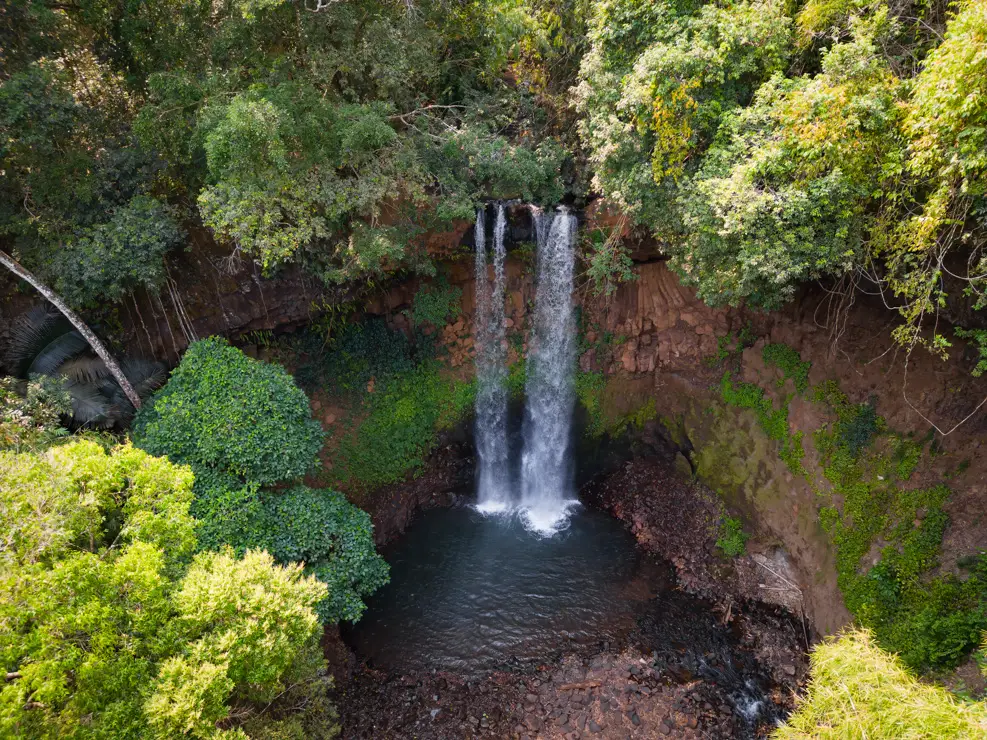
Leng Khoen waterfall.
Where to sleep in Mondulkiri (Saen Monorom)?
I slept at the Tree Lodge for convenience since it is run by the same people behind the Mondulkiri Project, but I would recommend sleeping here anyway. The Bungalows are friendly, and the view from the restaurant terrace at sunset is fantastic. The prices are fair. However, I recommend checking out New Hapthe py Elephant Bungalow if you want a slightly cheaper alternative.
How to reach Mondulkiri (Saen Monorom)?
I recommend looking at the Mondulkiri Project page, which has detailed instructions for getting to the city from many destinations.
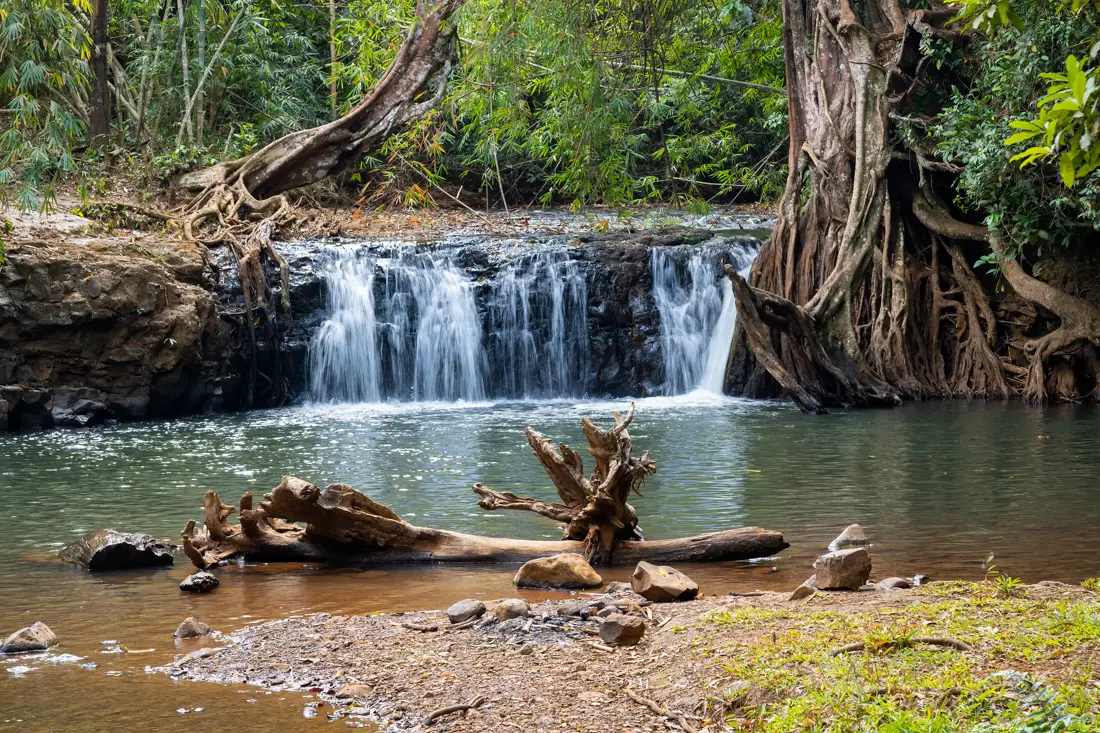
Leng Oung Waterfall.
Suggested itineraries in Cambodia
Below is a list of possible itineraries. As with any country, there is no perfect itinerary given a time frame. I believe any trip to Cambodia should include visiting Angkor Wat. Take what follows as inspiration and modify or create the itinerary according to your interests/budget!
One-week itinerary in Cambodia
If you only have one week to spare and want to limit long commutes or internal flights after visiting Angkor Wat, I recommend spending a couple of days in Battambang and Phnom Penh, from where it is easy to fly out of the country. Alternatively, you could fly from Siem Reap to Sihanoukville to spend a few days on the islands.
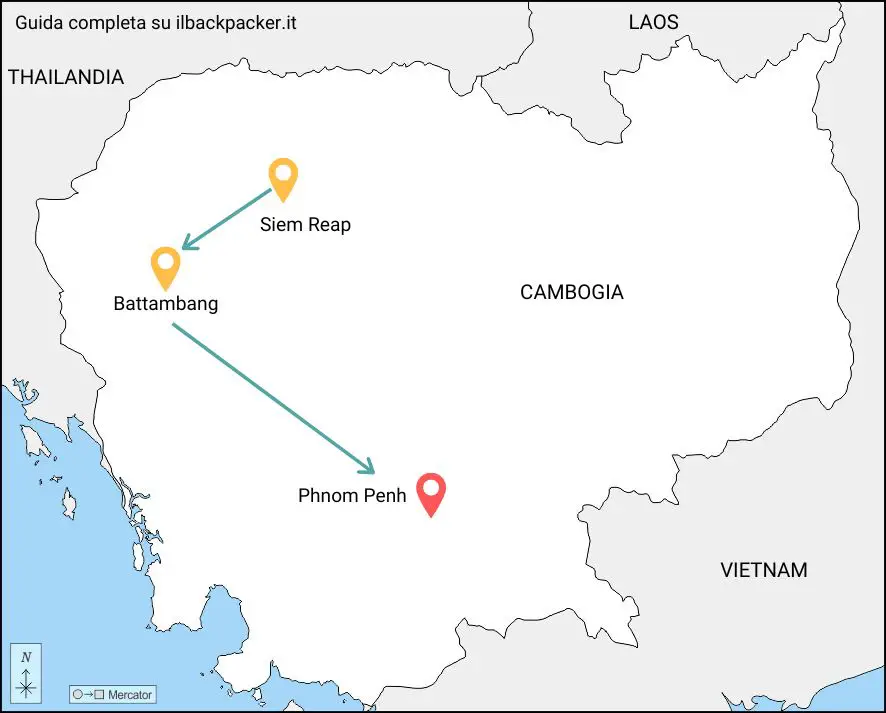
Siem Reap (3 nights)
Day 1:
Flight to Siem Reap. Visit the temples.
Day 2:
Sunrise Tour in Angkor Wat.
Day 3:
Explore the temples outside the main complex and the Landmine Museum. Alternatively, you could visit a floating village.
Battambang (2 nights)
Day 4:
Transfer to Battambang. Briefly explore the city. Attend the circus show (check the schedule; if not, you can make it the next day or visit the Siem Reap circus).
Day 5:
Tour of temples outside the city and Bat Cave.
Phnom Penh (2 nights)
Day 6:
Transfer to Phnom Penh. Briefly explore the city.
Day 7:
Visit Tuol Sleng (S-21) and Choeung Ek (Killing Fields).
10-day itinerary in Cambodia
With three more days to spare, I would follow the one-week itinerary described and then leave for a few days of relaxation on the islands.
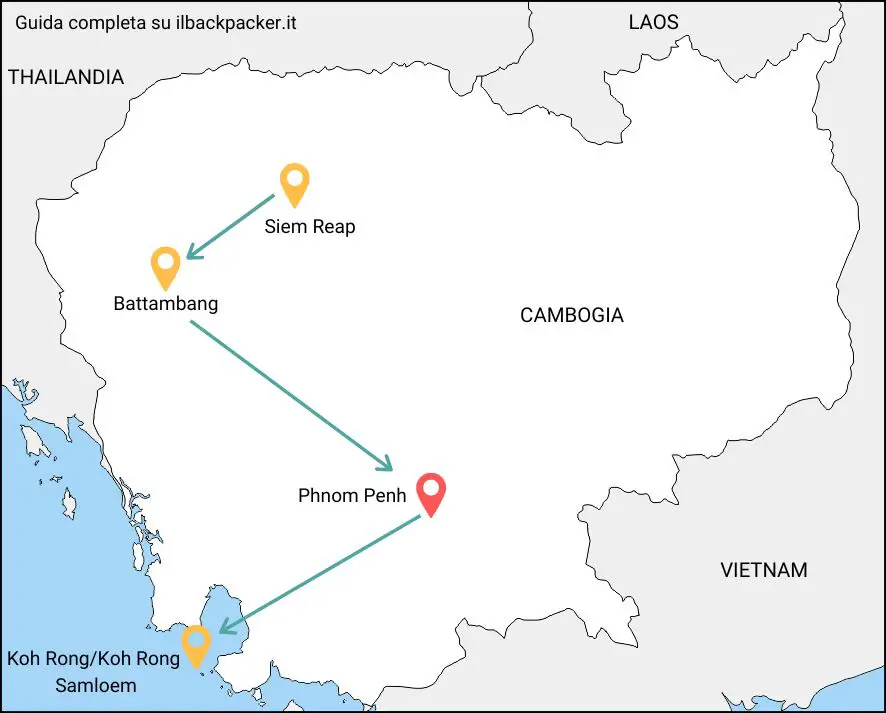
Two-week itinerary in Cambodia
With two weeks to spare, you could opt for a few extra days on the islands or head to Kampot.
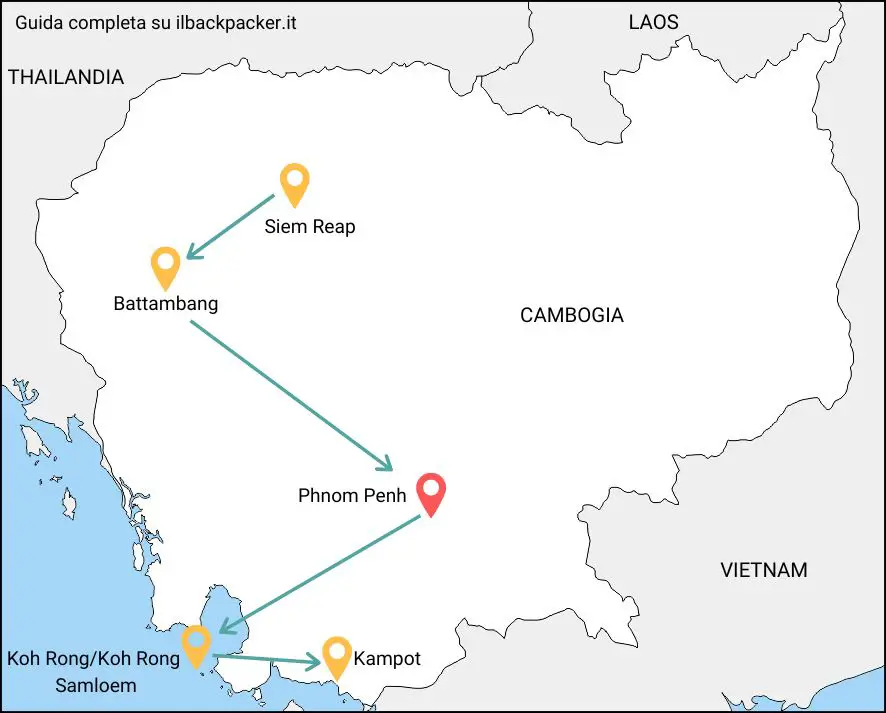
Three-week itinerary in Cambodia
With three weeks to spare, I would include Kampot after visiting the islands. Then, I will start looking eastward by reaching Saen Monorom (Mondulkiri) or Banlung (Ratanakiri), stopping in Kratie.
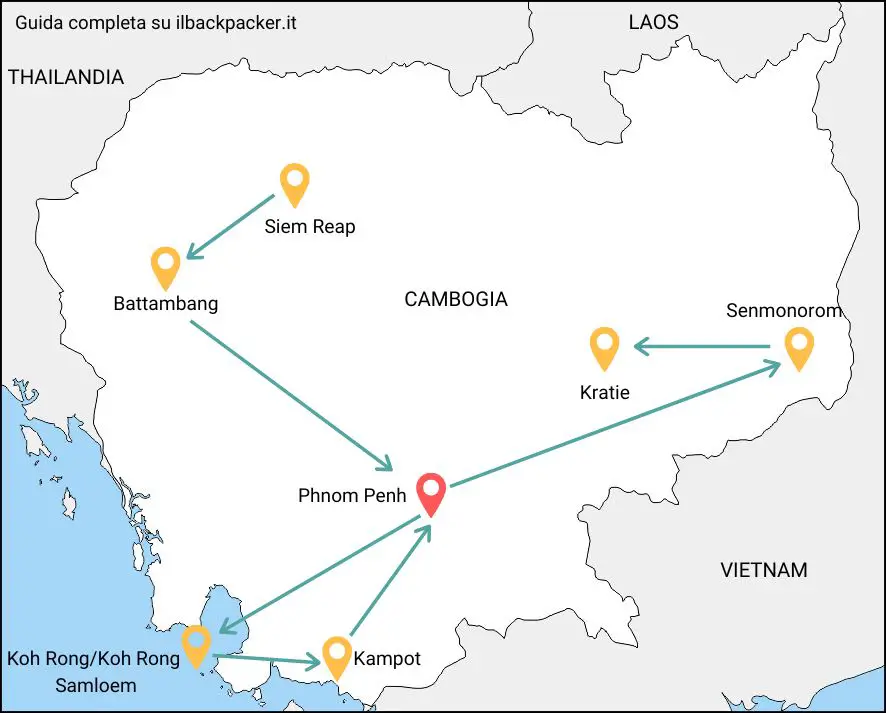
Four-week itinerary in Cambodia
With a month to spare, if you move relatively quickly, you should be able to visit most of the destinations mentioned in this guide. The exact itinerary depends significantly on how you access the country, but I would broadly follow the movements described on the map.
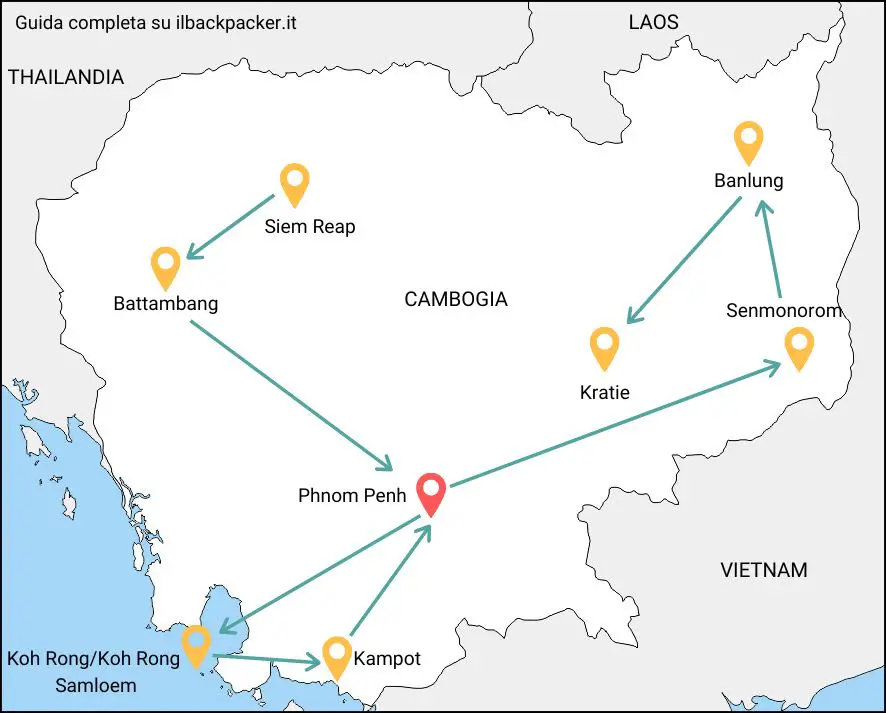
How to get around Cambodia
The infrastructure in Cambodia is undoubtedly among the worst in the region. Still, fortunately, the roads have improved quite a bit in recent years, making travel between significant cities less gruelling. That said, especially if you rent a scooter and venture into rural areas, be prepared because the roads are often unpaved and not always in good condition.

Sunrise at Angkor Wat.
Buses in Cambodia
Bus connections exist between the country’s major cities, but the bulk of travel is by minivan. Some companies I would recommend are:
Giant Ibis is considered the most “luxurious” company to operate in the country and offers connections to all major tourist destinations; you can book online.
Vireak Buntham is a company that covers a lot of routes and allows you to reach all the destinations mentioned in this guide. The minivans are almost always on time, and you can easily book them online. This is the company I have used the most overall.
Larryta offers only a couple of routes. I think only Siem Reap – Phnom Penh is relevant for most travellers. In any case, the value for money is excellent.
That said, dozens of other companies operate, and you can get an idea on sites such as 12go and Bookaway, but remember that not all options are available online. It is also important to point out that, unfortunately, no city has a standard bus/minivan station; each company has its office/garage/stop. Therefore, especially in large cities, it is good to consider your accommodation locations when choosing the company to travel with. This is also problematic if you want to save a few dollars by taking “local minivans.” I took a couple of them by booking through guesthouses, and all in all, it worked out well for me, but they are often filled beyond capacity and stop all the time to get people on and off.
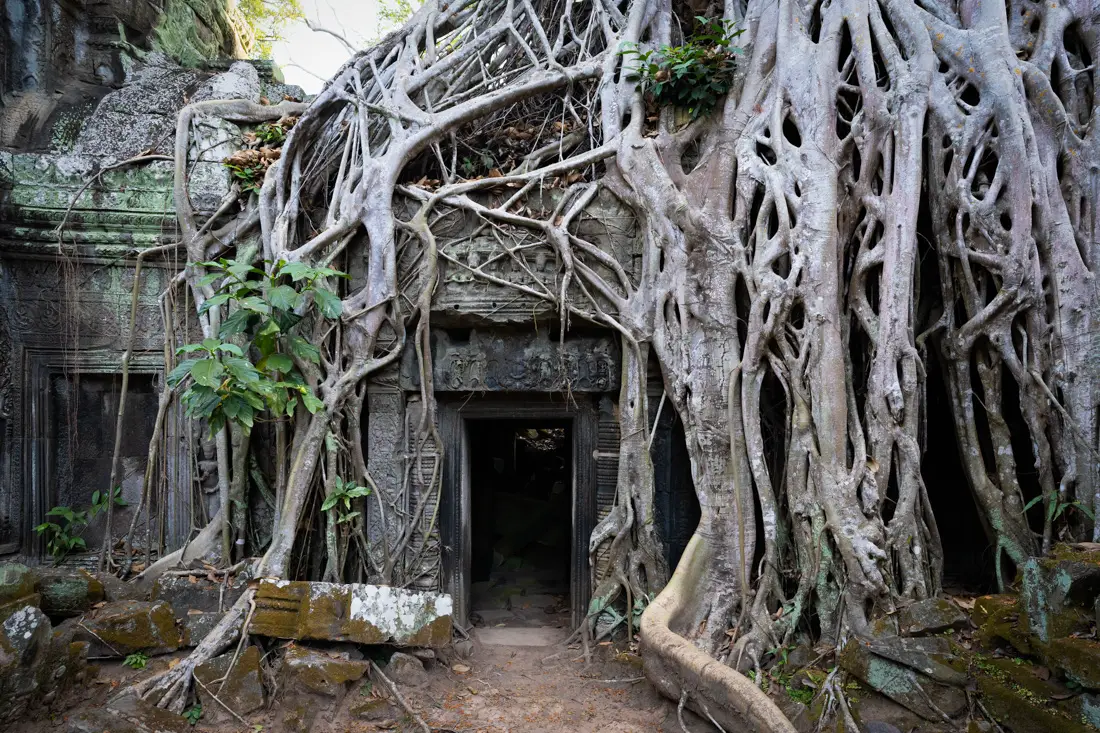
Ta Prohm temple.
Trains in Cambodia
As mentioned a few times throughout this guidebook, there are a couple of operational rail lines in the country. Unfortunately, the road option is often faster and not necessarily more expensive, leading to an obvious choice, so much so that I did not take any trains during my stay. A significant investment is underway to upgrade and improve the rail network, so things may change. This is the official website of the railways.
Tuk Tuk in Cambodia
If you decide to buy a sim card, I strongly recommend downloading the Pass app (Android, IOS). Not only is its use much more widespread than Grab (Android, IOS), but it is also cheaper. It was so affordable that on at least a couple of occasions, the tuk-tuk driver refused to offer the same price estimated by the app.
Domestic flights in Cambodia
The three airports offering commercial flights within the country are Siem Reap, Phnom Penh and Sihanoukville. The airlines of choice are Cambodia Angkor Air and Vietnam Airlines.
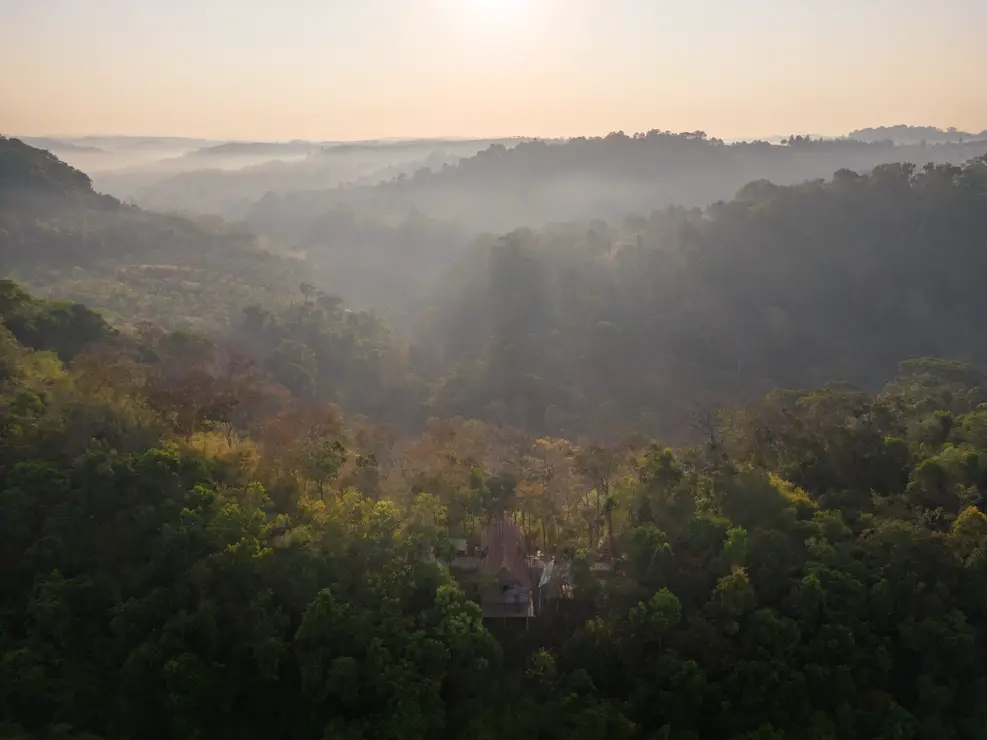
Mondulkiri Project Lodge.
Backpacking Cambodia: costs
How much does a trip to Cambodia cost? During my two-month trip (57 days), I spent 1697.6€ or just under 30€ per day.
Clearly, for a short trip where perhaps you will be travelling more frequently, the costs go up, and likewise, not everyone is willing to travel as cheaply as I do. Still, I assure you that I have never gone short of anything and in general, Cambodia is undoubtedly an inexpensive destination like the rest of Southeast Asia. A particularly low-cost traveller can quickly get away with spending even less. On the contrary, if you are looking for more comfort and frequent travel, I would budget at least 40-50€ per day.
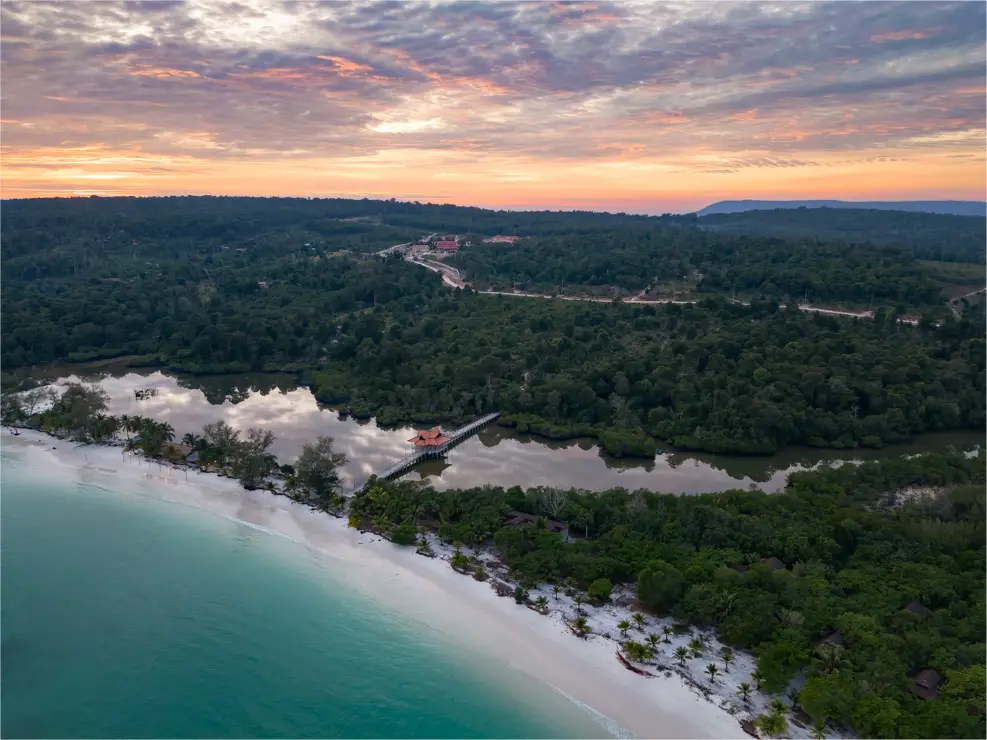
Koh Rong.
Cost of accommodation in Cambodia
Cambodia’s accommodation is cheap, especially in destinations with high competition; you can find a good dorm bed for $5. In any case, even on the islands, I never paid more than $10 per night. , I have had private rooms and bungalows for less than $10 per night in less touristy destinations.
Cost of transportation in Cambodia
Compared to lodging, transportation in the country is relatively expensive; regulars expect to pay $2-3 per hour of travel time.
Cost of food in Cambodia
It depends on what kind of restaurant you are looking for, but if you are not pretentious, you can get a good meal for $2-4. On the islands, expect to pay a little more. If you are willing to escape the tourist areas, I have had delicious meals in some local restaurants for 5000/7000 Real, which is less than $2.
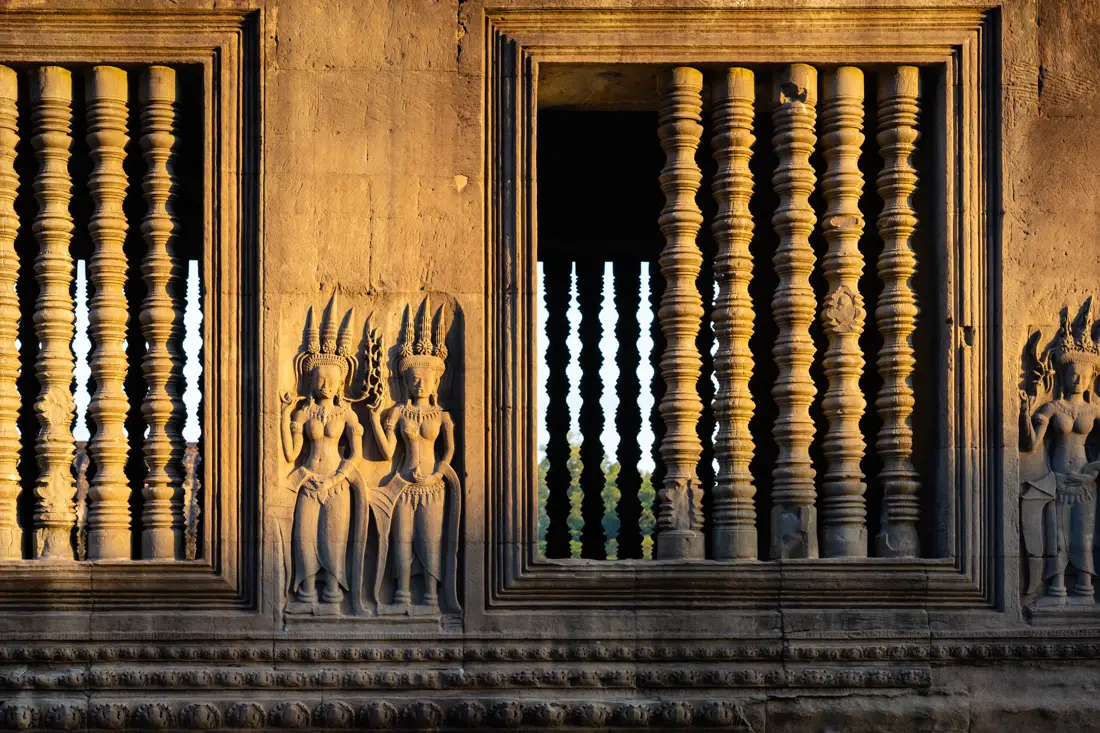
Other costs (withdrawals and sim cards)
Let’s start with the costs of withdrawals, which, unfortunately, even using the best cards for travel, cannot be reduced to zero. Most banks charge $4-$6 per withdrawal. The cheapest is Vattanac Bank, $4 per withdrawal, a maximum of $500 at a time. Maybank and Canada Bank charge $5, a maximum of $500 at a time. All others should be more expensive.
As for sim cards, if you want the best coverage, you have two choices: Smart and Metfone. I chose Smart, and all in all, I was fine; I always had a good connection except for Saracen Bay in Koh Rong Samloem. Metfone should have slightly better coverage but a lower average speed.
In any case, at least with Smart, once you register the sim in an official store (you need your passport), you can easily buy internet packages through the app. I paid the sim $1 and, if I am not mistaken, another $5 for 40 gigs of traffic.
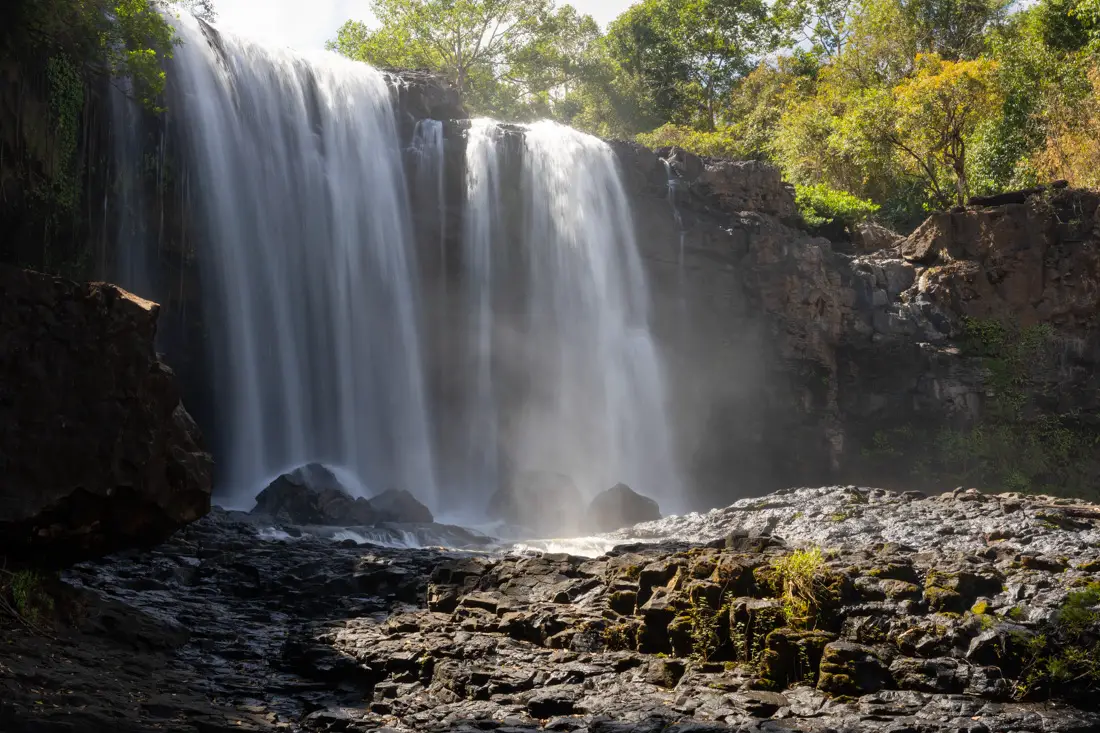
Bousra Waterfall.
Backpacking Cambodia: safety and security
Is Cambodia a safe country? Travelling to Cambodia presents no particular dangers, and in general, somewhat like all of Southeast Asia, it is a safe destination. Of course, common sense should be used as in any other part of the world, but by following my advice, I doubt you will have any problems.
That said, Phnom Penh and Sihanoukville do not have a good reputation at all; drugs and prostitution are familiar with all that goes with it. I have heard a few bad experiences, but people are always in the wrong place, doing the wrong things at the wrong times. Again, use common sense and avoid wandering around cities at night looking for or under the influence of drugs.
Do you have any questions? Updated information? Feel free to leave a comment or message me on Instagram!
If you found this article helpful, please consider purchasing your travel insurance through one of the links on this site, doing so supports my work at no additional cost to you. For EU & UK Residents, i recommend True Traveller. For everyone else i recommend HeyMondo (5% discount). Thanks!
For donations/pizzas and virtual beers 🙂
Did you like the post? Pin it!
